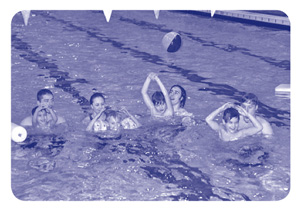Dedication
This book is dedicated to the children from Perkins School for the Blind, the California School for the Blind, Oregon State University's Special Physical and Motor Fitness Clinic, and the many other children in our lives who have taught us what works best for moving, learning, and growing.
Acknowledgments
The authors gratefully acknowledge the following people:
Ann Cowart for her patience and motivation; Julian Stein for writing the foreword and for his encouragement; Monica Lepore for her energy, super activities, editing, and never-ending guidance; and Monica Kleeman for her understanding, creativity, and wonderful support. We would like to thank our wonderful photographers: Monica Lepore, Monica Kleeman, Kelly Butterworth, Jim Cowart, Sue Fleming, Scott Hibbert, Rosanne Hoffmann, Tristan Pierce, Ann Travis, and John Schrock. We thank all the innovators because without their terrific input this book would not exist.
Lauren would like to thank her family for their support and understanding through the process; Carol Erickson for her encouragement; and Lou Lieberman for all his wonderful wisdom and belief through the years.
Foreword
Physical education teachers and activity leaders in the trenches are always on the lookout for appropriate, appealing games and activities for their students. Lauren Lieberman and Jim Cowart supply these resources through the pages of this practical, relevant, and realistic book, Games for People With Sensory Impairments. Drawing on their extensive experiences in teaching and reaching students of all ages who have visual impairments, blindness, deafblindness, or multiple disabilities, the authors have assembled fitness, recreation, and aquatic activities for elementary through high school youths. There is something for everyone in this excellent publication. The principles they present for adapting games, activities, and procedures introduced as instructional strategies can be applied to situations that involve nondisabled youngsters as well as those with disabilities. In fact, many of the activities you will read about can be used for students of all ages and levels of ability, without further adaptation.
The major focus of Games for People With Sensory Impairments, however, is on individuals who have visual impairments, blindness, deafblindness, or multiple disabilities. Lieberman and Cowart carefully and clearly present methods and techniques to assist teachers and leaders in becoming more effective with their students or clients. Experienced teachers and leaders will find this publication an excellent resource of tried-and-true activities and approaches. Regardless of the length and type of experience readers possess, they will find new ideas that will result in higher quality programs for their students.
For novices, this publication provides a wealth of information on what to do, how to do it, and why. This valuable resource should stimulate readers' creativity, resourcefulness, and initiative to explore further and develop additional games and activities for their students.
The games and activities included are, for the most part, creative innovations by outstanding teachers and leaders in special schools or programs for students who have sensory impairments. These games, however, are adaptations of familiar activities found in virtually every good physical-education or motor-development curriculum. It is apparent that even for students who have visual impairment, blindness, deafblindness, or multiple disabilities, no special curriculum and few specific activities exist only for them. Activities for these students are basically the same activities that have attracted students since time immemorial.
Even though implications of these activities are for segregated programs or special classes, the actual content and easily accomplished, commonsense adaptations and accommodations make their application appropriate for integrated classes. These activities are educational and have both general goals and specific objectives. The authors, however, aware that learning is accomplished most effectively in environments of enjoyment, pleasure, and fun, focus on the learner and learning (not the teacher and teaching). Success in any learning-teaching situation is best when teachers and leaders know their stuff, know who they are stuffing, and then stuff them wisely! These important underlying principles are demonstrated throughout the pages of this excellent book. Heartiest congratulations to the authors on an outstanding professional job, for which we all say, "Thanks for sharing your experiences and expertise with us—and well done."
Julian U. Stein
Professor in Physical Education (Retired)
George Mason University
Fairfax, Virginia
About the Authors
 Photograph of Dr. Lauren Lieberman
Photograph of Dr. Lauren Lieberman
Lauren J. Lieberman is a professor of adapted physical education in the Department of Physical Education and Sport at the College at Brockport-State University of New York at Brockport. She earned a PhD in 1995 in human performance with a minor in movement studies and disabilities from Oregon State University.
From 1989 to 1993, Lieberman was an instructor in adapted physical education and aquatics in the deafblind program at the Perkins School for the Blind in Watertown, Massachusetts.
Lauren has written several books including Strategies for Inclusion; Going PLACES: Transition Guidelines for Community-based Physical Activities for Students who Have Visual Impairments, Blindness, or Deafblindness; Adapted Physical Education and Sport; Paraeducators in Physical Education; and Physical Activity, Sport, and Recreation for Individuals who are Visually Impaired and Deaf-blind.
In 1996, Lauren started Camp Abilities, a developmental sports camp for children who are visually impaired, blind, or deafblind. There are now seven Camp Abilities throughout the US and Guatemala.
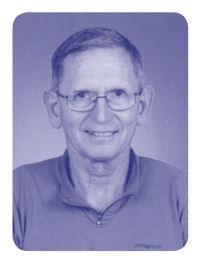 Photograph of Jim Cowart
Photograph of Jim Cowart
Jim F. Cowart was an adapted physical education teacher at the California School for the Blind in Fremont, California. He received an MA in education from the University of San Francisco. A veteran teacher of adapted physical education, Cowart has won numerous awards, most recently the 1996 Adapted Physical Activity Council National
Adapted Physical Education Teacher of the Year Award, given by the American Alliance for Health, Physical Education, Recreation and Dance. Cowart's writings on the subject of adapted physical education have been published widely. Jim Cowart is now retired, and he distributes wheelchairs to individuals with disabilities in developing countries.
About the Innovators
Karen Allen is a nationally certified adapted physical education (APE) instructor at the Oklahoma School for the Blind. Along with teaching health classes, she teaches APE to students pre-kindergarten through grade 12. She is also an adjunct faculty member of Northeastern State University, instructing in both the physical education and special education departments.
Jim Cowart has taught all ranges of abilities
throughout his 33 1/2 years of teaching. He is retired from the California School for the Blind in Fremont, California. He has contributed to many journals in the area of adapted physical education relating to teaching and adapting equipment. Jim is the 1995 Adapted Physical Education Teacher of the Year for the Southwest Alliance for Health, Physical Education, Recreation and Dance, and the National Adapted Physical Education Teacher of the Year for AAHPERD. (More information about Jim can be found in the About the Authors section.)
Sue Fleming taught regular physical education in both junior high and elementary school in Sitka, Alaska, for the over 25 years. She taught kindergarten and third, fourth, and fifth grades. She is proficient at adapting games to meet the needs of students with visual impairments.
Linda Gingery retired after 25 years of teaching at the Michigan School for the Blind in East Lansing, Michigan. Linda's energy and enthusiasm were an inspiration to all her students.
Sue Grosse is currently the president of Aquatic Consulting and Education Services in Milwaukee, Wisconsin. She was formerly on staff at Gaenslin Orthopedic School in Milwaukee, taught physical education at the Milwaukee High School of the Arts, and was an Adapted Aquatics Instructor Trainer for the American Red Cross.
Stephen Kearney has been teaching at the Oklahoma School for the Blind for over 20 years. He teaches K-12 and also coaches goalball. He has coached teams from all over the world, including the World Cup team for 3 years in a row. He is also very active in The United States Association for Blind Athletes.
Monica Kleeman is a former teacher at the Perkins School for the Blind in Watertown, Massachusetts in the Deaf/Blind Program, Life Skills, and Adult Services. Monica also coached the swim team, track team, and goalball team at Perkins and is an expert in adapted aquatics. She worked as a recreation director for the Lowell Association for the Blind in Massachusetts.
Monica Lepore has taught for 26 years at West
Chester University of Pennsylvania, preparing physical educators for including students with disabilities in physical activity programs. She has
a doctorate in leadership in adapted physical education from New York University. She has taught swimming at the Light House for the Blind, United
Cerebral Palsy, and various Red Cross community programs.
Lauren Lieberman taught at the Perkins School for the Blind for 5 years in the Life Skills, Head Injury, and Deaf/Blind Program. Lauren also coached goalball and track. In 1995 she received her doctorate from Oregon State University in Corvallis, Oregon, in movement studies for the disabled. She now teaches at the State University of New York at Brockport. (More information about Lauren can be found in the About the Authors section.)
Eric Paterson teaches physical education and aquatics at the Oregon School for the Blind in Salem, Oregon. He teaches students who are blind, visually impaired with multiple disabilities, and deafblind. Eric is also a volunteer coach for the Oregon Games for the Physically Limited, and the Oregon Special Olympics.
Tristan Pierce is a Project Leader at the American Printing House for the Blind in Louisville, Kentucky. She focuses her product development on Multiple Disabilities and Physical Education. Tristan is a swim coach at the Kentucky School for the Blind.
Candace Rehmeier has 35 years of experience in all levels of education, including 29 years of working with children who are blind or visually impaired in areas such as physical education. Honors include the Cooper Foundation Excellence in Teaching Award; the Christa McAuliffe Prize Honoree; the Nebraska Safari Club Educator of the Year for developing a Sensory Safari for blind and visually impaired children in partnership with the Lincoln Children's Zoo in Lincoln, NE; and the University of Nebraska Teacher's College Notable Alumni Award. As an instructor at the Nebraska Center for the Education of Children Who Are Blind or Visually Impaired (NCECBVI), Candace has been instrumental in taking students on the Oregon Trail for a 2-week summer camping experience in conjunction with the Kansas School for the Blind and Accessible Arts, Inc. program. She also attends Space Camp in Huntsville, Alabama, with students. She currently serves as an Outreach Consultant at NCECBVI.
John Schrock is a retired teacher from the Missouri School for the Blind. He coached track and swimming. John is the former National Chairman for powerlifting for the United States Association for Blind Athletes, and was the team leader for two World Cup Powerlifting Championships.
Haley Schedlin is a Jr. High School Physical Educator at the West Irondequoit School District. She is also the Assistant Director for Camp Abilities Brockport, which is a developmental sports camp for individuals with visual impairments, blindness, and deafblindness. Haley is a certified Yoga Instructor through YogaFit and has developed a yoga curriculum for her school district. She has co-authored two fitness manuals (Walk/Run for
Fitness and Jump Rope to Fitness) for individuals with visual impairments.
Beth Hudy Shay is a physical education teacher in Hershey, Pennsylvania where she coaches a middle school volleyball team. She previously taught physical education and swimming at the Royer Greaves School for the Blind in Paoli, Pennsylvania. She taught students who are blind and students who are visually impaired with multiple disabilities. She is a former volleyball coach at West Chester University in West Chester, Pennsylvania.
Doug Smith is a certified orientation and mobility specialist and an adapted physical education teacher at the Philip J. Rock Center and School, a school that serves children with dual sensory vision and hearing impairments. Mr. Smith has a Masters Degree in Special Education.
Linda Webbert, Certified Adapted Physical Educator, is the Lead Adapted Physical Education Consultant for Baltimore County Public Schools. Her primary responsibility is to assist physical education teachers in providing appropriate instruction in physical education to students with disabilities. Prior to working in Baltimore County Public Schools, she taught physical education and health education and also served as the Athletic Director at The Maryland School for the Blind. She was the President of the Eastern Athletic Association for the Blind and on the Board of Directors for Maryland Special Olympics. In addition, she has held various leadership roles at both the state and eastern district levels for the American Alliance for Health, Physical Education, Recreation and Dance. She is a Physical Best Instructor and a contributor to Physical Best Activity Guide Middle and High School Levels 2nd edition. She was the 1999 Maryland Adapted Physical Education Teacher of the Year and has given presentations throughout the United States on teaching and including students with disabilities into educational and recreational programs.
Preface
This manual is designed for adapted physical education specialists, physical education teachers, classroom teachers, therapeutic recreation specialists, community recreation leaders, and parents. It is specifically geared to those who—in segregated or inclusive settings—are responsible for students and/or adults who are sensory impaired or who are sensory impaired with multiple disabilities. By sensory impaired with multiple disabilities, we mean having one or more disabilities in addition to visual or hearing impairment. For example, a person may have an intellectual disability and be blind, orthopedically impaired and blind, deafblind, or cerebral palsied and blind. This book was also developed to meet the needs of sensory impaired students without disabilities, students with disabilities who are neither blind nor deaf, and adults with disabilities who are no longer in a formal educational setting.
Teachers and specialists working with students who have sensory impairments with multiple disabilities face unique challenges. Because such students make up a small percentage of the population, physical education texts on adaptations, instructional strategies, and activities for groups give only minimal information about working with them. Even less resource material is available about adults with disabilities who have progressed beyond the educational system. The daily challenges and frustrations resulting from this lack of information motivated us to write this book.
To produce a useful book we solicited physical education teachers from across the country who teach students with sensory impairments and multiple disabilities to contribute two or three of their best activities. Then we selected from among activities and games that reinforce skills, stress movement, and emphasize inclusion. All of these activities have been proven successful in both school and recreational settings. Every photo in this book includes children or adults who are sensory impaired, and illustrate that these activities are fun for all age and ability groups.
The activities offered in this book can all be presented to students who are sensory impaired with multiple disabilities within a regular physical education curriculum or to adults with sensory impairments in any recreational setting. But because these students and adults have unique combinations of impairments, modification is often required to ensure successful participation. Part I focuses on program adaptations and instructional strategies for successful participation. Common adaptations are listed under each activity; however, since even these may not be sufficient to meet the needs of all students or clients, the suggestions presented in "Adapting Games and Activities" will provide additional guidelines for making necessary adaptations.
Students in a regular physical education program typically learn skills through observation and practice. Many students who are visually impaired with multiple disabilities need to be taught movement skills in different ways in order to succeed. For this reason, we have included a range of instructional techniques that are successful with students. The method you choose will depend on the sensory abilities of the individual, with the goal of maximizing student-teacher communication. You will find practical instructional strategies reviewed in here, with examples of their use.
Part II includes activities offered by physical education teachers who have experience working with students who are sensory impaired with multiple disabilities. The groups that appear at the top of the Game Finder will help you find games that meet your teaching or recreational needs; the Game Finder includes category, sport skills, physical and motor fitness, and fundamental motor patterns and skills.
If you work with young adults with multiple disabilities, you will find that many of the activities in Games for People With Sensory Impairments are appropriate for your clients. The need for fun through physical activity doesn't stop when a person leaves school. The activities we've included in the recreation category specifically address this need. Additionally, many of the games in the high school category may also be used with these young adults.
Our goal in education is to help every student develop his or her full potential. We believe that if we deal positively and creatively with the challenges presented by students who are sensory impaired with multiple disabilities, these children, too, can develop physically, emotionally, and intellectually through the fun of games and exercise. We hope to help adults who have disabilities experience and benefit from whatever physical activity they might desire to try. One way to do this is to become more knowledgeable in teaching strategies, program adaptations, and activities geared specifically for these students and adults. In this manual we have expanded our own knowledge, and we hope it will expand your resources and knowledge as well.
How to Use This Book
Teachers and specialists often use games, both to help students develop and refine their movement skills and to engage adults in enjoyable physical activity that produces health benefits. For students and adults alike, these games can provide enjoyable experiences. For efficient learning to take place within a game, however, or for adults to participate successfully and enjoyably, the game leader must provide sound thought, careful planning, and suitable instruction.
By following the four steps given here, you can use this book most effectively to develop your use of games with students and adults. Note that although the steps are written with a school setting in mind, they are usually applicable also in settings for adults with disabilities.
Step 1—Locate an age-appropriate game that meets the needs of all students within the class.
Use the Game Finder to locate an age-appropriate game; be aware of the skills to emphasize with each student in the class. For example, an elementary physical education teacher has a class of 30 pupils who are ages 7 and 8, among them Sam, who is hemiplegic and visually impaired. Objectives for the students in the class focus on basic movement patterns (the objective in Sam's Individual Education Plan focuses on the development of locomotor patterns). The instructor wants to identify games that stress the movement patterns. She follows the steps suggested in the Game Finder to locate a game that seems to meet the movement needs of her student Sam. She sees that the game Bright Objects, for example, emphasizes basic movement patterns. She repeats this process to identify additional appropriate games for the class.
Step 2—Examine the game to confirm its suitability for students; make only needed modifications.
Once a game is located, the instructor determines if it can be played in the school's facility, if the necessary supplies are available, if the game's rules and strategies are within the students' mental capacities, and if students have the necessary social and game skills to participate. In this case, the teacher believes the game Bright Objects can be played in the school's multipurpose room, which has sufficient beanbags and other items to be used; the students have demonstrated the mental and social skills needed to play the game; and the children will use various locomotor skills (such as hopping, galloping, and skipping) they have recently learned and practiced. Sam's vision and locomotor skills allow him to differentiate most colors and shapes, and he walks and performs a modified run. Following this review of the game, the instructor believes no specific adaptations for Sam or any other student need be made. If a game or skill modification were necessary, the instructor would refer to the points listed under "Specific Considerations" in Part I.
Step 3—Implement and monitor the game's effectiveness.
Having satisfactorily completed the analysis in Step 2, the instructor introduces the game to the class. This brings into play one of the more critical elements of teaching, namely, monitoring student progress during game play. The instructor keeps the game moving smoothly by implementing game rules, by giving positive reinforcement when warranted, and by making any necessary corrections. If challenges arise during the game, the instructor makes needed adjustments in the game or play skills to keep the students actively involved in skill development. This may entail challenging some pupils more and other pupils less. The "Adapting Games and Activities" section of this book provides useful suggestions for modifications. For problems that do not require immediate solutions, an instructor should make a mental note for consideration before the game is played again.
Step 4—Reexamine the game's appropriateness.
At this point, the instructor may simply confirm that the choice of the game was good—it allowed students to practice needed skills or develop new ones in an enjoyable way. On the other hand, this could be a time to decide that the game, as presented, was inappropriate for the students. If the instructor felt students were not challenged, the game could be modified or new skills taught—the game could be made more difficult to encourage student growth. If the students were not successful, the instructor might consider changing the game to lessen the challenge or might select a different game that presents a more appropriate challenge for students. Whatever the decision, the "Specific Considerations" section in Part I can provide very useful information to make successful changes. Sam, for example, was able to walk and perform a modified run, and he could identify and retrieve objects of various colors and sizes. The instructor chose to challenge Sam further by teaching him to hop on his noninvolved foot. Teaching techniques covered in "Instructional Strategies" proved invaluable to the instructor for teaching Sam to hop.
Games for People With Sensory Impairments enables teachers and group leaders to implement these four steps by providing an easy-to-follow Game Finder, guidelines to individualize games, and instructional strategies to teach game skills. These resources will help you include children who are visually impaired with multiple disabilities in enjoyable physical activities with nonhandicapped children, while challenging them all. These features are equally beneficial when used to help adults with disabilities enjoy successful participation in physical activity.
Part 1
Adapting and Teaching Games and Activities
Adapting Games and Activities
Education is committed to the development of each student to the fullest extent possible. A number of curricular areas have been established to achieve this purpose, including physical education. Through the medium of movement, physical education contributes to the development of physical and motor fitness, fundamental movement skills and patterns, and skills in aquatics, dance, individual and group games, and sports.
Because many students with multiple disabilities cannot take advantage of unstructured participation in physical education, they often are not given the opportunity to develop skills within their ability, nor do they learn to play specific games or sports. With some creative thought and imagination, however, program adaptations can be made to accommodate these learners. Through adapted activities, students' skills may be improved, and they are enabled to learn and use new and specific game skills. In this way, education fulfills its responsibility to maximize each student's opportunity to learn.
 Photograph of a young boy standing in a gym with his hands clasp together, as if he is ready to return a volleyball.
Photograph of a young boy standing in a gym with his hands clasp together, as if he is ready to return a volleyball.
Caption: Every child deserved the maximum opportunity to learn.
The following strategies are important when considering activity adaptations for learners who are visually impaired, blind, deafblind, or have multiple disabilities.
General Considerations
Student Abilities
Good instructors assess the strengths and weaknesses of a student who has a disability before that student begins participation in movement programs. This analysis should include information about the extent of vision and hearing, and any other health concerns. Such knowledge can be obtained from classroom teachers, student health records, parents, physical therapists, and/or family physicians. With this information, instructors will have a general idea of what activity adaptations are needed to accommodate the student.
Use assessments to confirm a student's functional level and any needed adaptations. A useful tool to determine the functional fitness level of a student with a disability is The Brockport Physical Fitness Test (Winnick & Short, 1999). The Brockport Physical Fitness Test has standards for children (ages 10-17) with any level of visual impairment. This assessment covers the five components of health-related fitness, and each one has standards specifically for children with visual impairments. The areas covered are upper body strength, abdominal strength, flexibility, cardiovascular endurance, and body mass index (BMI). In addition, the test has valid standards for children with orthopedic impairments. The information gathered from this test identifies problem or weak areas. This allows the instructor to design appropriate lessons/activities to encourage the student to increase his functional level or maximize his ability.
Use the Test of Gross Motor Development II (TGMD II) (Ulrich, 2000) to assess the child's gross motor function. This test covers locomotor skills (skipping, running, sliding, leaping, galloping, and jumping) and object control skills (kicking, throwing, batting, underhand roll, and catching) for children 3-10 years old. This test gives instructors information related to weak areas of locomotor and object control that should be addressed on the Individual Education Plan (IEP) and in classes.
It is possible to use any assessment that is used with sighted peers as long as it is made accessible for the child with the visual impairment. This is done with the use of practice trials, bright or auditory equipment, a peer guide, and lessons designed to teach the target skill. These accommodations are implemented prior to data collection.
Specific Activities
Adapted physical education is a service, not a placement. Whether the child is served in a segregated program or integrated class, or a combination of both, the activities offered should mirror those offered in general physical education to his able-bodied peers. It is important for instructors to know all aspects of activities (i.e., equipment, rules, skills, etc.). In addition, it is critical for the teacher to have the knowledge and ability to task-analyze skills (i.e., the ability to break a skill down into its component parts for learning purposes). This expertise enables teachers to make necessary modifications to accommodate students while making sure that activities maintain their basic intent or original character.
Age-appropriate Activities
Design the program to help students acquire skills functionally appropriate for their age, and to learn activities that encourage interaction with non-disabled peers. If you do not understand what is age-appropriate, look at the curriculum of a good general physical education program for children of the same age as your student(s). As noted earlier, though many learners who are sensory impaired with or without multiple disabilities cannot participate unrestricted in activities with their classmates, through activity adaptation it is possible to help them both develop useful skills appropriate for their age and interact with peers.
It may be necessary to make changes in any or all of the areas noted below in order to accommodate these special learners in activities.
Rule Modification
By changing a rule or rules, an activity can be made less complex or restrictive in order to include students who are sensory impaired with or without multiple disabilities. Rules are categorized as rules related to play or rules related to players.
Play Rules
Play rules are rules that govern game play. Here are some examples of adaptations of these rules:
A batter in softball is out when a fielder stops a rolling audible ball or when the fielders perform some type of cooperative drill before the runner reaches the base. For example, after fielding the ball, the defending team might be required to form a line and pass the ball from one end to the other, alternating over the head and between the legs.
 Five young adults are lined up one after the other outside in a field. They pass a ball to each other backward and over their heads.
Five young adults are lined up one after the other outside in a field. They pass a ball to each other backward and over their heads.
Caption: In order to achieve an out, the fielding team tries to complete this cooperative game before the runner reaches the base.
Specific Considerations
- A runner in softball or kickball is awarded a point for reaching first base safely.
- A volleyball player is allowed to serve the ball from 3' in front of the net instead of the back endline.
- A wheelchair tennis player is permitted to let the ball bounce two or three times (if needed) before playing the ball.
- A player in shuffleboard earns point values of 3, 2, and 1 instead of 10, 8, and 7 due to cognitive needs.
- A student is allowed to dribble a basketball by bouncing and catching the ball.
Player Rules
Successful participation in activities may require adjustment in player position, teaming of players, number of players, etc. Noted below are some examples of rule modifications related to players:
- Two players are in touch with each other in a game like "squat tag" (i.e., elbow to elbow, back to back, etc).
- A sighted guide runs with the base runner in a kickball or softball game.
- A student limited in movement plays only the defensive position in soccer.
- Additional players are included in goalball to more adequately cover the playing area.
- A sighted person assists a blind golfer with putting by pointing out ball location, distance of ball from the cup, and so on.
Equipment and/or Facilities Modification
Few major equipment and/or facility adaptations are necessary in low-level organized activities for most learners who are sensory impaired with or without multiple disabilities; however, more specific or more complex adaptations may be needed in team, dual, or individual sports. Consider the benefit of adapting equipment or facilities that would have previously eliminated a student who is visually impaired with multiple disabilities from participating. Following are examples of equipment and facilities modified to encourage the learner in movement activities:
- Use an audible ball or anything else as a directional cue or goal in a tag game such as Steal the Bacon.
- Define the playing area with mats, walls, or cord with tape over it for any game that requires a defined playing area.
- Employ a rail for guidance in the approach in bowling.
- Use a bell, a portable radio, a portable sound source, or hand clapping, as a directional cue in relays (each team uses a different sound).
- Attach a beeper/portable sound source to a stake or arch for auditory tracking in croquet.
- Use a short-handled putter in golf for a student in a wheelchair.
- Use a tug-of-war rope on the ground as a boundary for games such as volleyball.
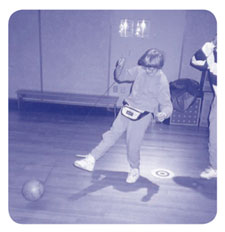 A girl kicks a ball that is attached to a string. She holds the other end of the string in her right hand.
A girl kicks a ball that is attached to a string. She holds the other end of the string in her right hand.
Caption: A student uses a ball on a string to practice kicking. In this way, she gets automatic feedback on each kick and does not have to chase the ball.
Skill Modification
Teachers who have classes that include students who have sensory impairments with multiple disabilities, must teach across a tremendous range of student abilities. By knowing where participants stand in the continuum of acquired skills, teachers make adjustments that allow each learner to use and refine a skill or skills within his repertoire while he enjoys active game participation. Some examples of skill adjustments to capitalize on each learner's functional level follow:
- In tag games, each student uses fundamental motor patterns within her skill repertoire.
- In T-ball, a student with crutches uses one of his crutches as a bat.
- In bowling, a pupil uses a one-, two-, four-, or five-step delivery, depending on the individual's capabilities.
- In swimming, a student with spastic cerebral palsy uses a "toes-in" bilateral leg kick when performing an elementary backstroke.
- In bowling, horseshoes, and golf putting, a student who is very involved with cerebral palsy with limited head control uses a mercury switch to activate game equipment.
Instructional Modifications: Movement Exploration
This teaching technique is a method of teaching movement skills that uses problem solving. It does not emphasize one "correct" body movement or dynamic quality. Its unique advantage is that for a specific challenge or problem, a variety of acceptable responses is possible. No child's success is determined or affected by the performance of another learner. For students who have sensory impairments with multiple disabilities, the approach allows for successful participation by a learner with other students no matter how limited the learner is. For example, students without sight and with additional disabilities can respond to such challenging questions from the instructor as
- "Can you go across . . . ?",
- "Show me another way . . .",
- "How many different ways . . . ?",
- "See if you can go . . .", or
- "How can you move . . . ?"
The responsibility of a teacher who uses an exploratory approach is to present a series of suitable challenges from simple to complex depending on each child's capabilities. If this strategy is implemented appropriately, continued self improvement by each learner will take place.
Conclusion
Review the general and specific suggestions discussed previously when you consider an activity adaptation. If you are unsure of how to proceed, study the examples of adaptations that are included. It is important for instructors to remember that the key consideration in making an adaptation or adaptations is the value derived by the student. More detailed information related to specific adaptations can be obtained from the resources listed at the end of this book, as well as in the game section (Part II).
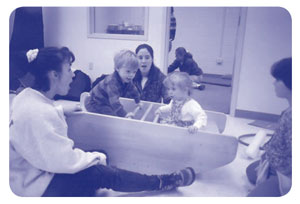 Two young children sit in a wooden rocking boat while three adults sit on the floor.
Two young children sit in a wooden rocking boat while three adults sit on the floor.
Caption: Programs that make appropriate adaptations and set students up for success from the beginning enhance students' growth.
Instructional Strategies
Typically, students gain information through sight and hearing. Other avenues by which individuals obtain information are through tactile (touch), kinesthetic (muscles, tendons, and joints), and vestibular (balance information from the inner ear) senses. When students with impairments such as intellectual disabilities, hearing loss, and/or physical disabilities experience the added disability of vision loss, the remaining senses must be used to fill the void.
In order to obtain insight into a student's preferred means to gain information, the instructor should talk with the student, classroom teacher, and parent, as well as refer to school and health records. Once channels more commonly used by the student are identified, and the intact senses used to get information are determined, the teacher tries to match instructional strategies to the student. Use tactile modeling, physical guidance (Cowart, 1993), explanation, and demonstration to broaden the student's learning. In this chapter, each of these four commonly used teaching strategies is briefly reviewed. Pointers on each strategy are also discussed. Finally, to assist the reader in planning and applying these strategies, two examples are presented: One example stresses teaching of a sport skill, while the other makes use of techniques to teach rules and strategies of the game.
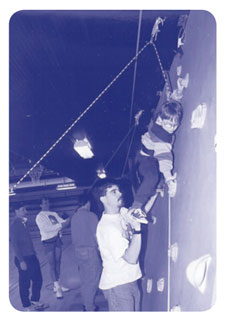 A young boy reaches for a climbing hold while a man supports him by holding the boy's feet.
A young boy reaches for a climbing hold while a man supports him by holding the boy's feet.
Caption: The student uses a harness and rope for support, and the instructor provides appropriate assistance to guide the student safely to success on a climbing wall.
Tactile Modeling
Fait (1978) defines tactile modeling (previously known as brailling) as inspection of people or objects with the hands. Vodola (1973) uses the word "see," and Reams (1980) "tactile exploration" to refer to the same thing. For purposes of this manual, "tactile modeling" refers to the student using his or her tactile senses in learning.
Tactile modeling is an effective method to help the student who is blind or visually impaired with multiple disabilities understand and learn skills. When considering the use of tactile modeling as a teaching technique, keep the following points in mind.
- When tactile modeling, the student examines with his or her hands the position of the demonstrator's body, limb(s), and/or movement of the body parts as the skill is demonstrated.
- Tactile modeling is of particular value when teaching a new skill or when making a correction in an awkward or improper movement of the student.
- Tactile modeling is sometimes more effective for skills in which the body is stationary and the limbs move (e.g., archery).
- Some skills are difficult to tactile model if the student is required to follow two or more moving body parts at the same time (e.g., four-step delivery
in bowling); in this case an alternate teaching technique, such as physical assistance with verbal or sign prompts, may need to be emphasized.
- Careful analysis of the skill by the teacher prior to instruction will help determine if tactile modeling is a good technique to use.
 An instructor stands in a "T" position while a student feels the position of the instructor's arms.
An instructor stands in a "T" position while a student feels the position of the instructor's arms.
Caption: The student uses tactile modeling with the instructor in a warm-up activity.
- An assistant may be needed to help the student assume the appropriate position and placement of his or her hands during the execution of the skill.
- When done properly, tactile modeling allows the student not only to know the location of the body and its parts during skill execution but to become aware of speed and rhythm as well.
Physical Guidance/Physical Assistance
Physical guidance is defined by Sulzer-Azaroff and Mayer (1991) as the teaching technique of performing a movement with the student, who then eventually gets the feel of the motion. It consists of placing the student's body and/or limb(s)—with or without an implement—into the appropriate position and putting him or her through the desired movement at the preferred speed. As with tactile modeling, physical guidance is a primary teaching technique for assisting some students who are visually impaired with or without multiple disabilities to learn new skills and/or to correct bad habits. If done properly, physical guidance is extremely beneficial in communicating the proper performance of a skill.
Helpful points to plan and use physical guidance are:
- Always keep in mind that the goal of instruction is for the student to perform the skill at the most independent level possible.
- Physical guidance can range from physically assisting the student totally through a skill to a gentle touch aimed at prompting the student to complete a task.
- Begin with the amount of assistance that will ensure the desired performance of the skill. Generally, by trial and error the instructor will get an indication of assistance needed for successful performance of the task. With complex skills such as golf putting, the amount of assistance may vary with each step of the putting sequence.
- Always use verbalization or sign with physical guidance to maximize skill learning.
- Be constantly alert to student response. When you feel the student begin to perform the movement pattern or step(s) in a skill sequence, minimize your assistance accordingly. Try to phase out assistance as soon as possible to prevent student dependence.
- Immediately reinforce the successful completion of a task or skill sequence. The intent is to increase the probability that the level of skill performance will occur again.
- As with tactile modeling, the position while providing assistance is critical. A proper assistance position does not interfere with the natural rhythm of the movement as the instructor feels the student begin to perform the task. (The position the instructor takes with a smaller student may not be the same with a larger student.)
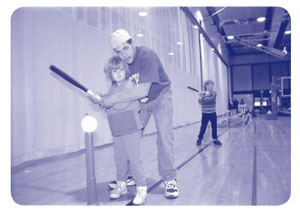 A young girl stands in front of a ball mounted on a T-ball stand; with the teacher's assistance she holds the bat ready to hit the ball.
A young girl stands in front of a ball mounted on a T-ball stand; with the teacher's assistance she holds the bat ready to hit the ball.
Caption: The instructor provides the minimum physical assistance necessary.
- When possible, have the student practice the skill under the conditions in which it will be used, reducing the necessity for later adjustments.
- If a student resists being physically assisted, do not attempt to force performance of the skill. Allow the student to calm down, and then try again. If the student continues to resist physical guidance, reevaluate what is being done. The teacher may need to set up a behavior management program, teach another skill, use tactile modeling, or reposition him or herself to provide assistance.
Explanation
In physical education, many students use their sense of hearing to gain information about skill development, game rules, and strategy. However, auditory learning may be difficult or impossible for some students. In these instances, sign or body language may be used to communicate. Consider the following points before you use this teaching strategy.
- To assist individuals who are hard-of-hearing and blind to make full use of their remaining hearing, the instructor must seek information about the loss, conditions under which hearing is best, and other communication abilities and skills. As noted earlier, this information may be obtained from school staff, parents, records, or personal observation.
-
After you become familiar with the student's mental capabilities, use whichever language (oral or sign) is appropriate for the student's functional level to portray key points of the skill.
- For more involved students with usable hearing, choose a few action words that focus on the desired skill or parts of the skill. If the student lacks hearing but has some usable vision, develop a sign or body movement that can create the correct image of the desired skill or its parts. In the case of a student who has no hearing or sight, the solution may be to manually move the student's hands through the sign(s) or movement pattern(s).
- Give higher functioning students a more thorough explanation of the skill; provide a more complete picture of what is requested or what is to follow. The information should be presented in the sequence in which it will be performed.
- When possible, combine verbal (sign) communication with tactile modeling, physical guidance, or demonstration to increase learning efficiency (O'Connell, Lieberman, & Petersen, 2006).
-
Following the explanation, observe the student's response in order to check his or her understanding of how the skill is performed. If the student seems to have difficulty comprehending the instructions, try the following:
- Repeat the instructions, along with any related teaching strategy.
- Search for another word, sign, gesture, or movement to communicate the desired skill.
- Initial progress may be slow for some students with dual sensory impairments because they may need to associate language with the movement at the same time they are learning the desired skill. Always associate language with the movement, whatever the level of the individual.
- Once the student's skill response is somewhat established, gradually reduce or remove any of the more artificial verbal or sign prompts, keeping only a natural cue or cues that are typically used to initiate the desired movement or skill.
Demonstration
Learning is achieved through the visual sensory channel with the use of demonstrations, pictures, illustrations, or film. According to Winnick (in press), this is the preferred sensory channel of learning by sighted people. Demonstration is used most often in physical education. Demonstration communicates how a skill should be executed, a game should be played, or a dance should be performed. In a well executed demonstration, the skill is performed with good form and the student follows with an attempt to imitate the movement. For many students who are visually impaired with or without multiple disabilities, demonstration is impractical and must be replaced with tactile modeling, physical guidance, and explanation.
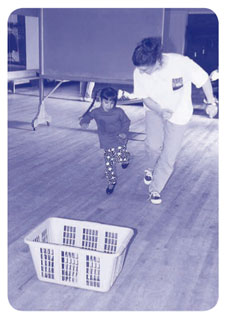 A teacher and young girl both hop on one leg.
A teacher and young girl both hop on one leg.
Caption: The student responds positively to the instructor's demonstration.
When you use demonstration for a student with some residual vision, the following may be helpful:
- The demonstrator should efficiently perform the skill as it would normally be done. In this way, the student will have an accurate image of the skill to model.
- If possible, combine demonstration with an explanation (oral or sign) and/or physical guidance to maximize the student's learning.
- If a student does have sight, it is important to determine the extent of his or her vision. Each student's visual capabilities are unique, and an individual's visual functioning may fluctuate from day to day and from one setting to another. Knowing this will help the instructor decide if demonstration can be a useful teaching strategy for a particular student, and will help provide the best conditions in which to demonstrate.
-
Demonstration should be followed by a time for practice. If the student is having difficulty modeling the skill, consider the following:
- Repeat the demonstration as well as any related teaching strategies. Make any adjustments appropriate to improve the student's chances of understanding how to perform the desired movement.
- If necessary, break complex skills (shooting an arrow, bowling a ball, etc.) into sub-skills, or component parts; lead the student to learn each part separately, using demonstration and related teaching strategies. Finally, encourage students to integrate the parts into complete skills, again using demonstrations as the models.
- Instructors should reinforce modeled performance as well as give feedback (including additional demonstrations, if necessary) to correct performance errors. This approach is repeated until the desired level of mastery is achieved, or adjustment made to conform to the student's capabilities.
Before you use tactile modeling and physical guidance, consider the following:
- Discuss the teaching approach with the student so he or she feels comfortable with it.
- Use both techniques in conjunction with explanation.
- Be patient as achievement is the goal and it may take considerably longer than for children without disabilities.
- For accountability, always document your teaching technique(s) in reports, IEPs, and lesson plans.
In addition to the above instructional strategies, the instructional approaches for running are listed below. Running is a basic skill that is found in most sports. It is a skill that should be promoted and improved upon for all children with or without sight and/or hearing.
- Sighted guide: The runner grasps the guide's elbow, shoulder, or hand depending upon what is most comfortable for the runner and guide.
- Tether: The runner and guide grasp a tether—a short string, towel, or shoelace. This allows the runner full range of motion of the arms, while in close proximity to the sighted runner.
- Guidewire: The runner holds onto a guidewire and runs independently for time or distance. A guidewire is a rope or wire pulled tightly across a gymnasium, track, or field. A rope tied to form a loop and attached to a metal ring (carabiner) or metal handle ensures that the individual will not receive a rope burn and allows for optimal performance. The runner holds onto the sliding device and runs for as long as he or she wishes independently. Guidewires can be set up permanently or temporarily.
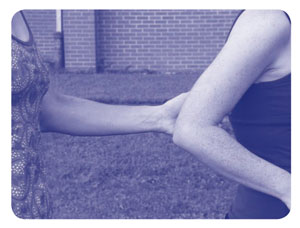 The photo shows a close up of one runner's left hand holding the right elbow of the other runner.
The photo shows a close up of one runner's left hand holding the right elbow of the other runner.
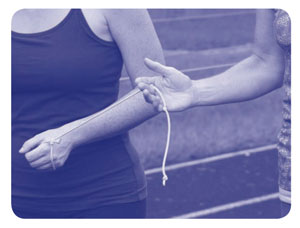 The photo shows one runner with the sliding loop side of the tether around her fingers and the other runner holds the knot on the other side of the tether between her forefinger and middle finger; the knot is showing on the palm side of her hand.
The photo shows one runner with the sliding loop side of the tether around her fingers and the other runner holds the knot on the other side of the tether between her forefinger and middle finger; the knot is showing on the palm side of her hand.
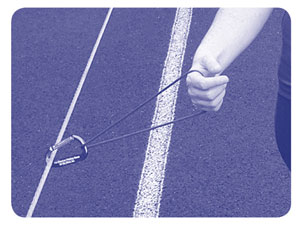 The photo shows a runner holding a looped rope that is attached to a carabiner. The carabiner is sliding along a guidewire.
The photo shows a runner holding a looped rope that is attached to a carabiner. The carabiner is sliding along a guidewire.
- Sound source from a distance:
The runner runs to a sound source such as a clap, bell, or electronic device. This can be done as a onetime sprint or continued for a distance run.
- Sound source: The guide rings a bell or shakes a noisemaker for the runner to hear while they run side by side. This works best in areas with limited background noise.
- Circular running: In a large grassy area clear of obstacles, a 20-25 foot rope is tied to a stake in the ground. The student takes the end of the rope, pulls it taut, and runs in circles independently. The circumference of the circle can be measured to determine distance or the athlete can run for time. A beeper or radio can be placed at the starting point to designate number of laps completed.
- Sighted guide's shirt: The runner with partial vision runs behind a guide with a bright shirt. Ask the runner what color he/she can see best to ensure maximum vision. This must be done in areas where it is not too crowded.
- Independent running: A runner with travel vision runs independently on a track marked with thick white lines.
- Treadmill: Running on a treadmill provides a controlled and safe environment. Select a treadmill with an emergency stop safety feature.
- Wheelchair racing: An individual who is blind and in a wheelchair can use any of the above adaptations as needed. Aerobic conditioning results from pushing over long distances, whether around the track, on neighborhood sidewalks, or along a paved path. (Lieberman, in press)
Keep in mind that it is extremely important to allow the student opportunities to experience each technique and decide which technique is preferred. Students may even prefer one technique for speed and another for distance.
Case Studies
Following are two examples of instructional strategies. The first emphasizes physical guidance and manually moving the student's hands to communicate and teach the student a swim stroke. The second example stresses application of demonstration, physical guidance, and sign to communicate and help a student understand how to play volleyball.
Example #1
Sport: Swimming
Skill: Swim stroke, prone
Background: The student is a 14-year-old boy who is totally deafblind with some spasticity in the lower limbs; his primary sources for information are assisted signing (manually moving his hands through the sign) and physical guidance. He generally resists learning new skills.
Initial Observations: The student has good breath control; he demonstrates no swim stroke; bobbing and spinning in the water are his preferred activities; he resists being placed prone or supine in the water.
Student Objective: To learn a useful stroke. A beginner stroke is selected for emphasis, starting with an alternating arm pattern, since the student has some lower-leg involvement.
Instructional Plan: Because of the student's resistance to learning new skills, a behavior modification approach to teaching the alternating arm pattern is selected. Grapes, popcorn, and potato chips are very strong reinforcers; the plan is to have the classroom teacher on the pool deck with reinforcers for the student.
The instructor and student are in the water several feet from the poolside, with the instructor positioned so that he can manually move the student's hands to communicate the desired activity, as well as give the physical guidance that the student will likely need to perform the skill. The instructor manually moves the student's hands through the sign "you swim." Then the instructor quickly puts the student into the prone position on his (the teacher's) thigh. While in this position, the teacher alternates the student's arms as he moves with the student to the poolside. On touching the poolside, the instructor lets the pupil stand and manually moves the student's hand through the sign "good swimming." The classroom teacher immediately reinforces the pupil with a chip.
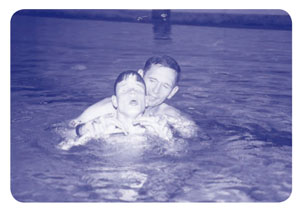 A swim instructor supports a boy in the water and manually moves the student's hands through the sign "you swim."
A swim instructor supports a boy in the water and manually moves the student's hands through the sign "you swim."
Evaluation: The instruction took place as planned. The student initially resists the practice, but he enjoys receiving the chips. It is decided to continue the plan as noted above.
Continued Instruction: Chips are used because they are strong stimuli for continued practice, but are decreased as the student exhibits less resistance. Within a short time, the pupil anticipates what the teacher is going to sign, and he immediately performs a bilateral arm pattern (modified breaststroke arm pattern). At this point, the instructor no longer emphasizes an alternate arm pattern and reduces the physical guidance to just supporting the student's hips. Additionally, performing the swim stroke now seems to be its own motivation for the student, so the use of chips is eliminated.
Gradually the student's arm strokes become stronger, and he begins breathing every few strokes; physical guidance is removed, and the student swims independently.
Example #2
Activity: Volleyball
Background: The student is a 10-year-old boy with some residual sight, no hearing, and is highly distractible. He learns new skills through signing words, demonstration, and physical guidance. He demonstrates good movement skills.
In addition, he recently attends to tasks for longer periods of time as a result of a behavior management program. Because of his good physical skills and increased cooperation, the school staff wants to involve him in a regular physical education class. Games such as volleyball are emphasized by the regular classroom teacher. For this reason, the physical education teacher selects volleyball as the first game in which to involve the student.
Student Objective: To learn to play volleyball.
Instructional Plan: Aware that the student uses his remaining sight to learn new tasks, the instructor selects demonstration, physical guidance, and word signs as the instructional strategies to emphasize. The plan is to familiarize the student with the game, boundaries, and equipment. Next, the instructor and a volunteer demonstrate the game. This is followed by the student performing the game skills with the aid of the instructor (physical guidance) and the instructor's commentary (word signs).
Evaluation: It is obvious by the student's confused look and lack of attention that he does not understand the concept of the game as it is being demonstrated. The instructor determines that a second volunteer is needed to help give a more realistic demonstration of the game, as well as to free the instructor to be with the student to provide immediate feedback and physical guidance.
Continued Instruction: Once a second volunteer is obtained by the teacher, efforts to teach the game of volleyball are continued. Two volunteers and the instructor are able to provide an effective demonstration of how the game should be played. The instructor continues to stay close to the student, signing the appropriate action, and physically guiding the student to serve the ball, catch the ball, set the ball, etc. The teacher also provides immediate feedback that relates to the success of the student's efforts. With this approach, the student quickly learns the elements of the game. Physical guidance is gradually eliminated, but appropriate word signs continue to be used during the flow of the game. Following these efforts, the student is successfully integrated into volleyball games with modifications within the regular classroom's physical education program.
Part 2
The Games
The Game Finder
Using the Game Finder
The Game Finder that follows is designed to help you locate games and activities appropriate for your students. The following steps will help you use the Game Finder quickly and easily:
Step 1 — Use the key on page 45 to identify the letters which correspond to whatever category and sport skill or physical and motor fitness skill you wish to emphasize.
Step 2 — Scan down the Category column in the Game Finder until you locate the letter that represents your chosen category, then move to the right to see if the Sport Skills and Physical and Motor Fitness columns contain the appropriate letter(s) that represent your desired sport skills or physical and motor fitness skill(s). (The Fundamental Motor Patterns and Skills column will have a check mark only if the game or activity includes these skills.)
Step 3 — Once you've found your category and corresponding skill, move to the left and note the name of the game or activity that incorporates the skill you wish to emphasize.
Step 4 — Refer to the corresponding page that is listed in the Game Finder and review in detail the game or activity to see if it will meet the students' needs. Each game or activity follows the same format.
The games and activities in this book are success oriented. All individuals should be able to participate within their ability. Remember that grade level is a suggested grade range. Aquatics activities may also have suggested grade ranges. Use recreational activities with either children or adults in educational or non-educational settings. Be flexible and creative when you choose equipment and setup to encourage successful participation, and to take advantage of whatever equipment you have at hand. If a game or activity is too easy for some, then you can add more challenging tasks. If a game or activity is difficult for others, use the suggestions listed in the adaptations section of the specific game or Part I of this book to ensure success for all individuals.
Key
| Category |
| E |
Elementary School |
| M |
Middle School |
| HS |
High School |
| R |
Recreation |
| Aq |
Aquatics |
| Physical and Motor Fitness |
| Ag |
Agility |
| Ba |
Balance |
| CR |
Cardiorespiratory Endurance |
| F |
Flexibility |
| ME |
Muscular Endurance |
| St |
Muscular Strength |
| Sport Skills |
| A |
Archery |
| B |
Baseball or Softball |
| Bb |
Basketball |
| Bo |
Bowling |
| C |
Croquet |
| Fb |
Football |
| Fr |
Frisbee® |
| G |
Golf |
| Go |
Goalball |
| H |
Hockey |
| Hs |
Horseshoes |
| RS |
Racquet Sports |
| Ro |
Roller Skating/Blading |
| S |
Soccer |
| Sh |
Showdown |
| T |
Track |
| V |
Volleyball |
Fundamental Motor Patterns and Skills
Examples include walking, running, hopping, skipping, sliding, galloping, etc. Marked with a check.
Game Finder
| Game Name |
Category |
Sport Skills |
Physical & Motor Fitness |
Fundamental Motor Patterns & Skills (X) |
Page |
| Airdyne Across (Insert your state name) |
M, HS |
|
CR |
X |
61 |
| Archery Balloon Pop |
HS |
A |
|
|
65 |
| Auditory Bowling |
R |
Bo |
|
|
67 |
| Ball in the Box or Goal |
E, M |
|
Ag, ME, St |
|
71 |
| Barn Yard Yoga Animals |
E, M |
|
Ba, ME, F, St |
|
73 |
| Basketball Shoot |
M, HS |
Bb |
|
|
79 |
| Batting Skills (Lead-Up Game) |
E, M |
B, RS |
|
|
83 |
| Beach Ball Volleyball |
HS |
V |
CR, ME |
|
85 |
| Beep Baseball |
HS |
B |
|
|
87 |
| Bell Balloon Bash |
E |
S |
Ag, Ba, CR |
X |
91 |
| Bell Tetherball |
R |
|
|
X |
93 |
| Body Painting |
Aq |
|
F |
|
95 |
| Bowling Pin Position |
R |
Bo |
|
|
97 |
| Box Ball or Bucket Ball |
E |
|
Aq, Ba, CR |
X |
101 |
| Bright Objects |
E |
|
Aq, Ba, CR |
X |
105 |
| Bucket Play |
E, Aq |
|
F |
|
107 |
| Busy Bee |
E, M |
|
Ag, Ba, CR |
X |
109 |
| Call Ball or Spud |
E, M |
|
Ag, Ba |
X |
111 |
| Can Game |
E, M |
|
|
X |
113 |
| Challenge Tasks |
E |
|
Ag, Ba |
X |
115 |
| Clean Up Your Room! |
Aq |
|
Ag, Ba, CR |
|
119 |
| Clothes Swim |
Aq |
|
CR, ME |
|
123 |
| Diamond Ball |
E, M |
B |
St |
X |
125 |
| Diving In! |
Aq |
|
Ag, Ba, F |
|
129 |
| Duck Swim |
Aq |
|
CR, F, ME, St |
|
131 |
| Find the Ducky |
E, Aq |
|
CR |
|
133 |
| Fitness Wheel |
R |
|
CR, F, ME, St |
X |
135 |
| Flower Hunt |
Aq |
|
Ag, CR |
|
139 |
| Football 5-a-Side |
M, HS |
Fb, S |
Ag, F, St |
X |
141 |
| Frisbee Bell Hockey |
M, HS |
H |
Ag, Ba, CR, ME |
|
143 |
| Frisbee Golf |
M, HS |
Fr |
CR |
|
145 |
| Goalball |
M, HS |
Go |
Ag, CR, F, ME, St |
|
149 |
| Golden Sneaker Club |
R |
T |
CR, ME |
|
153 |
| Holiday Roller Blading |
R |
Ro |
Ag, Ba, CR, ME |
|
155 |
| Home Run Derby |
HS |
B |
|
|
157 |
| Hot Rod Potato Relay |
E, M |
T |
Ag, Ba, CR, ME |
X |
161 |
| Human Bowling |
E, M |
Bo |
Ba, St |
|
163 |
| "I See" |
E |
|
Ag, Ba |
X |
165 |
| Jump Tag |
E |
|
Ag, Ba, St |
X |
167 |
| Kickball |
E, M |
B, S |
CR |
X |
171 |
| Lap Counting |
Aq |
|
CR, ME, St |
|
173 |
| Leader in the Circle |
Aq |
|
|
|
175 |
| Modern Dance |
HS |
|
Ag, Ba, CR, F, ME |
X |
177 |
| Musical Hoops |
Aq |
|
CR, ME |
|
179 |
| Obstacle Course Ideas |
E |
|
Ag, Ba, St |
X |
181 |
| Parachute Pull |
E, M |
|
CR, St |
|
185 |
| Partner Pull Relays |
Aq |
|
CR, ME, St |
|
187 |
| Poison Ball |
E |
|
Ag, BA, CR |
X |
189 |
| Poker Chip Pickup |
E, M, HS |
|
St |
|
191 |
| Pool Activities |
E, Aq |
|
Ag, Ba, CR, ME |
X |
193 |
| Pool Parachute |
Aq |
|
CR, F, St |
|
195 |
| Relays |
E |
|
Aq, Ba, CR, St |
X |
197 |
| Scatter Stations |
R |
|
Ag, Ba, CR, F, ME, St |
X |
201 |
| Scavenger Hunt |
Aq |
|
CR, F, St |
|
205 |
| Sensational Table Tennis |
R |
RS |
F, ME |
|
207 |
| Sequential Motor Patterns |
E, M |
|
Ag, Ba, CR, F, ME, St |
X |
209 |
| Shipwrecked |
E |
|
Ag, Ba, F, ME |
X |
213 |
| Showdown |
R |
Sh |
|
|
217 |
| Sockley |
E, M |
V, RS, B, S |
Ag, CR, ME |
X |
221 |
| Sponge Partners |
Aq |
|
CR |
|
225 |
| Stations |
E |
Bb, Bo |
Ag, Ba |
X |
227 |
| Steal the Bacon |
E, M |
Bb, S |
Ag, Ba |
X |
231 |
| Success-Oriented Horseshoes |
R |
Hs |
St |
|
233 |
| Tactile T-Ball (Lead-Up Game) |
M |
B |
F |
|
237 |
| Tactile Twister |
R |
|
Ba, F, ME, St |
|
239 |
| T-Ball |
E, M |
B |
|
|
243 |
| Team Cone Croquet |
R |
C |
|
|
247 |
| 10 Shot |
M, HS |
Bb |
|
|
249 |
| Throw and Search |
E, M |
B |
|
X |
251 |
| Underwater Tag |
Aq |
|
CR, ME |
|
253 |
| Wacky Yoga Warriors |
E, M |
|
Ba, F, St |
|
255 |
| Water Baseball |
Aq |
B |
CR, ME |
|
263 |
| Water Soccer |
Aq |
S |
CR, ME |
|
263 |
| Weather Game |
Aq |
|
|
|
265 |
| Your Fitness is in the Cards |
E, M |
|
CR, F, ME, St |
|
267 |
| Zone Volleyball |
E, M |
V |
ME |
|
271 |
Games and Activities
The elementary years are a time for most children to acquire and/or refine their movement skills and patterns. To facilitate this skill development, children should have the opportunity to engage in a variety of movement activities and games. The basic movement skills and patterns learned at the elementary level are further refined and used in lead-up games, and activities of a more specialized nature, during the middle school years. At the high school level, students' skill emphasis and development is channeled even more into specific individual and group games and sports. Throughout all grade levels, there are recreation and aquatics games and activities appropriate for all ages.
This section includes many activities and games with suggested adaptations that stress skill development at the elementary, middle, and high school levels as well as increased performance in recreation fitness and aquatics for all age groups.
| GAME |
Airdyne Across (Insert Your State Here) Category: Middle/High School |
Goal
To develop cardiorespiratory endurance and fundamental motor patterns and skills
Objective
Each student rides a stationary bicycle or Airdyne® bicycle (student uses arms as well as legs) at a constant pace for a designated time. Students select cities or towns within the state, locate the mileage to each, and choose an interesting fact about each place.
Equipment
Airdyne or stationary exercise bicycles, and a large tactile outline of the state noting selected towns and cities.
Setup
Have available stationary bicycles within the gym, weight room, or classroom.
Description
Students ride three to five times per week to accumulate miles. This is an activity in which all students with sensory impairments will be able to participate equally. Before starting, the student must:
- Decide whether to accumulate mileage individually or as a team.
- Determine the towns and cities to visit.
- Locate mileage to identified towns or cities.
Once the above decisions have been made, students keep track of miles biked. These figures are recorded on the large state map. When students reach their destination, they are responsible for collecting historical information about the town or city. They then present this information to the entire class. The activity has proven to be very motivating for the students.
Adaptations
- This activity can be adapted to any group. Younger children can participate by walking, running, jumping rope, etc. The activity can be converted to miles any number of ways; one trip around the schoolyard equals 1 mile, 10 jumps with a rope equals 1 mile, and so on. The level of information gathered can be adjusted for the age level or ability of the student(s).
- Outline the state map, and note distances to the chosen towns and cities using thickly painted string (place a piece of string in wet paint, and let it dry). Students use their sense of touch to get an idea of the shape of the state as well as the distance to various towns and cities.
- Students unable to bike may accumulate miles by walking, wheeling, rolling, and so forth.
- The mileage of slower students may be multiplied by 2, 5, or 10, depending upon the need.
- Students can keep track of their miles on a computer, graph, map, or chart.
- Use the same concept for swimming. Each lap equals 1 mile.
Innovator
Candace Rehmeier
Nebraska Center for the Education of Children who are Blind or Visually Impaired
| GAME |
Archery Balloon Pop Category: High School |
Goal
To improve sport skills (archery)
Objective
Students practice the basic shooting technique while attempting to pop balloons placed on an archery target.
Equipment
Archery bows, arrows, mats, ground quivers, balloons, mini beepers, footboards, and aiming devices
Setup
Place balloons close together on the archery target. Have the shooting line 20-25 feet from the target.
Description
While students practice their basic shooting technique, they attempt to break as many balloons as possible during their turn. The desire to break balloons seems to keep students focused on skill acquisition.
Adaptations
- Students who have difficulty keeping an arrow on the arrow rest or string can use an arrow guide rest, arrow nocks (narrow enough for an arrow to snap onto a bowstring), and finger guards (all items can be obtained from a local archery dealer).
- For students who are deafblind, the use of the footboard and aiming device have proven helpful in aligning themselves and the arrow to the target.
- Students who use a wheelchair can practice shooting from the chair.
- Students who are blind with hearing may benefit from the following devices:
- A mini beeper placed on top of the archery target for a directional clue.
- Use a footboard (Cowart, 1993) to assist a student with consistent body/foot position in relation to the target.
- Use an aiming device (Reams, 1980; Cowart, 1993; White, 1995) to help a student familiar with the basic shooting techniques to align an arrow with the target.
Innovator
Jim Cowart (retired)
California School for the Blind
| GAME |
Auditory Bowling Category: Recreation |
Goal
To improve sport and recreation skills (bowling)
Objective
Partcipants move milk jugs by striking them with a rolling ball. They then determine what substance is in the jug.
Equipment
Three to five milk jugs, dirt, rice, water, bells, macaroni, tape, and an 8-inch playground ball
Setup
Line up three to five milk jugs (depending upon the ability level of the student) 1-2 feet in front of a 4-foot line, as shown in the diagram.
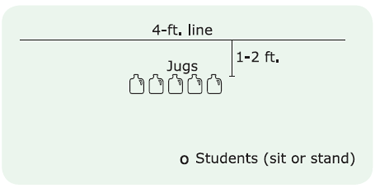 The drawing shows five jugs in a row. Approximately 1-2 feet behind the jugs is a line that measures 4 feet long and is parallel to the jugs. A mark shows that the students stand 6-10 feet in front of the jugs.
The drawing shows five jugs in a row. Approximately 1-2 feet behind the jugs is a line that measures 4 feet long and is parallel to the jugs. A mark shows that the students stand 6-10 feet in front of the jugs.
Description
Put a different substance in each jug (e.g., one with 10 bells, one with 1 cup of rice, one with 2 cups of water, one with 3 cups of dirt, etc.), enough to make a distinct sound when the jug is hit with a ball. Be sure that the lids are closed tightly on each jug. Then line the participants up 6-10 feet in front of the jugs, depending upon their ability. Have the participants roll the ball at the jugs and see if they can hit the jug over the 4-foot line for 5 points, then determine what substance is in the jug for another 5 points. Each participant gets two or three turns per round, playing five to seven rounds. The participants who are able can keep score for themselves.
Adaptations
- Use painted jugs for students who have low vision and little hearing.
- Mark letters or numbers on the front of jugs. After the jug is hit over the 4-foot line, participants can identify the letters or numbers for double points.
- Participants in chairs can roll the ball down a large tube or a ramp.
- Use more jugs for particiants who need a larger range and fewer jugs for participants who need a smaller range.
- Have a higher functioning participant set up the jugs.
- Use a heavier ball for participants who need more sensory feedback.
Innovator
Lauren Lieberman
The College at Brockport-SUNY
| GAME |
Ball in the Box or Goal Category: Elementary/Middle School |
Goal
To increase muscular strength and endurance and agility
Objective
Team members push their ball into the opposing team's box or goal.
Equipment
Two large colored boxes (one end of the box is open) or cones to mark goal areas, and two large balls at least 36 inches or larger in diameter
Setup
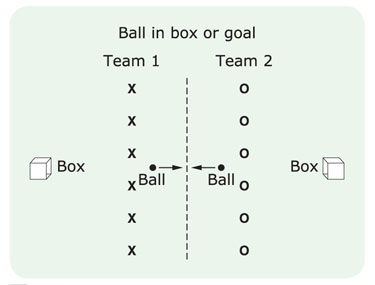 The illustration shows a vertical dashed line separating the game area in two. In the center, on each side of the dashed line is a dot to indicate each team's ball. The right side has 6 circles to indicate one team's players and the left side has 6 Xs to indicate the other team's players. The players are lined up parallel to the dashed dividing line. Each side has a box centered behind the line of players.
The illustration shows a vertical dashed line separating the game area in two. In the center, on each side of the dashed line is a dot to indicate each team's ball. The right side has 6 circles to indicate one team's players and the left side has 6 Xs to indicate the other team's players. The players are lined up parallel to the dashed dividing line. Each side has a box centered behind the line of players.
Description
Familiarize team members with equipment, boundaries, goal areas, etc., and then position players on their respective starting lines. When the teacher gives the signal, team members push their ball toward the opposing team's box or goal area. The team that pushes its ball into the box first, wins that round. Repeat play.
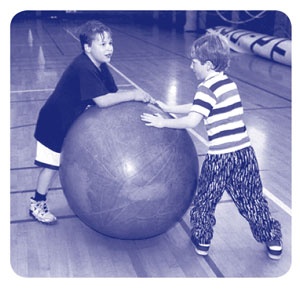 One boy stands firm on one side of an oversized exercise ball while another boy pushes the ball from the opposite side.
One boy stands firm on one side of an oversized exercise ball while another boy pushes the ball from the opposite side.
Adaptations
- A teacher or assistant can help push the ball, and where necessary, communicate game rules.
- Use a caller or beeper at each box or goal to serve as a prompt for students who are visually impaired.
- For safety, allow only three or four students to push the ball at once.
- Use more than one ball.
- Play the game on scooters.
Innovator
Doug Smith
Philip J. Rock Center and School
| GAME |
Barn Yard Yoga Animals Category: Elementary/Middle School |
Goal
To improve flexibility and balance
Objective
Students hold different yoga poses that correspond to animals. Each pose will be individually modified to meet the needs of each person.
Equipment
Soft surface (yoga mats, folding gym mats, wrestling mats, carpeted surface, carpet squares)
Setup
Set up the space so that each student has enough room to move freely without getting into another student's personal space.
Description
Students follow the instructor as she/he describes different yoga poses that resemble different animals.
- Mountain Pose - This resting pose allows the student to transition from one pose to another. Stand up tall with both feet flat on the mat, hands to the side of the body, palms forward, and draw the top of your head to the sky.
- Swan Dive - From Mountain Pose, draw your arms over head with a slight backbend. Then draw your arms out to the side of your body like wings while hinging from the hips. Draw your hands to the floor into a forward fold (bend your knees if needed).
- Downward Facing Dog - From your forward fold, bend your knees and place your palms flat on the
floor. Step back with your right foot, then step back with your left foot and push your bottom up to the sky. Elbows should be straight, knees slightly bent, and head relaxed between your arms. Variations: If student's wrists hurt, have him/her place straight fist or forearms on the ground.
- Cow Pose - From Downward Facing Dog, draw your knees to the floor so you are in a crawling position. Draw your belly towards the floor as you arch your back and lift your head up to the sky. Keep your elbows straight and your hips over your knees.
- Cat Pose - From Cow Pose, draw your belly button into your spine as you round your back up toward the sky. Keep your elbows straight and allow your head and neck to relax between your arms. Transition between Cat Pose and Cow Pose.
- Extended Cow Pose - From Cow Pose, extend your right arm out and your left leg back holding the pose for 3 seconds. Switch to your left arm out and your right leg back. Variation: Student lifts his/her arm and leg separately.
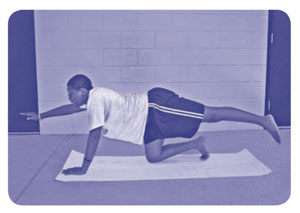 A boy holds the extended cow pose on a yoga mat; his right arm is extended and his left leg is extended.
A boy holds the extended cow pose on a yoga mat; his right arm is extended and his left leg is extended.
Caption: The student demonstrates Extended Cow Pose.
- Child's Pose - Child's Pose is a resting position. From Cow Pose, draw toes together, open knees up to the side, and sit your bottom on your heels. Draw your torso towards the floor and extend your arms out, resting your forehead on the mat.
- Camel Pose - From Child's Pose, come to a kneeling position. Place the top of your feet on the mat and keep your bottom off your heels. Place your fists into your lower back and start to arch your back and lift your chest toward the sky. Allow your head to slowly and carefully look back to a comfortable spot. When coming out of Camel Pose, push your fists into your lower back and slowly transition into Child's Pose to release the lower back. Variation: For individuals who are very flexible, they can tuck their toes onto the floor and place their hands onto their heels while arching their back and extending their torso towards the sky.
- Pigeon Pose - Start in a crisscross position. Rock forward placing your hands on the floor and extend your right leg back and keep your left leg in the crisscross position. You want to keep your left heel in line with your right hip joint. Allow your bottom to sink toward the floor as you slowly bring your torso towards the floor. Place your forehead onto your folded arms in front of you and rest. Slowly walk yourself up, back into a crisscross position and transition to the other side. This is a great pose to open up the hip joint and hip flexors. Variations: Student lies on his/her back with the right knee bent and the right foot flat on the mat. The student places the outside of the left foot onto his/her right thigh allowing the left knee to open out to the side. Change legs and repeat.
- Bug Pose - Lie on your back. Raise your feet up towards the sky. Bend slightly at your knees and grab your big toes with your fingers. Allow your knees to draw towards the floor on each side of your body. Make sure to keep your entire back and head flat on the floor.
- Relaxation Pose - Lie on your back with straight legs; allow your feet to open naturally to the side. Place your arms on each side of the body, palms facing up. Close your eyes, relax, and breathe.
Adaptations
- Use tactile pose cards.
- Physical guidance from instructor with verbal instructions
- Tactile modeling by instructor
- Use interpreters for individuals with deafblindness.
- Use peer tutors who work 1:1 with students.
Innovator
Haley Schedlin
West Irondequoit School District
| GAME |
Basketball Shoot Category: Middle/High School |
Goal
To improve sport skills (basketball)
Objective
Students take turns passing, running, shooting, and rebounding.
Equipment
Basketballs, baskets, cones, and a backboard with a beeper attached (when possible). Use a doorbell; the APH Portable Sound Source, Sport Edition; or a pop can with quarters or rocks inside attached to a rope. You can also take a child's cane and tap the rim of the basket for an auditory cue.
Setup
Place a cone in the area of each foul line, closer to or farther from the basket depending upon the ability of the student. Have teams of two or three students; each team lines up facing a basket.
Description
The first person in line has a basketball. The game begins when the teacher says "go." The first person passes the ball overhead to the person behind. The second student runs to the cone and shoots at the basket. He or she rebounds the ball and returns to the front of the line. Immediately he or she passes the ball to the next person, who continues the drill until stopped by the teacher.
Adaptations
- Keep points—one for hitting the backboard or rim, and two for a basket.
- Use the game as a relay or shooting drill.
- Add a dribble up to the cone instead of running with the ball.
- Change positions of the teams and cones so students learn to shoot from different angles and distances.
- Use a beeper or other sound cue (handclap, verbal directive, etc.) to indicate the location of the basket or cone, positions of teammates, and so on.
- Have adjustable baskets to accommodate students unable to reach a standard basketball hoop.
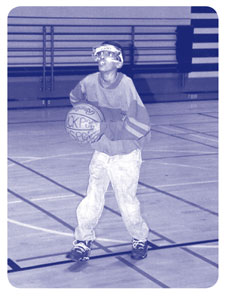 A boy who wears safety glasses prepares to throw the basketball up to the basketball goal in a gym.
A boy who wears safety glasses prepares to throw the basketball up to the basketball goal in a gym.
- For students with multiple disabilities, a staff member may need to provide assistance to locate the cones and/or basket, execute a shot, rebound the ball, return to team members, etc.
- Students pass the ball under the legs or around the body.
- Use a ball other than a basketball.
- Give students more than one turn.
Innovator
Linda Webbert
Baltimore County Public Schools
| GAME |
Batting Skills (Lead Up Game) Category: Elementary/Middle School |
Goal
To improve sport skills (baseball)
Objective
Students stand individually or with a partner and practice tracking and batting balls.
Equipment
Rope and string; bats, paddles, or racquets; Wiffle® ball, balloon, beach ball, beep baseball, softball, or like objects to strike; and a batting tee and/or designated pitcher who can pitch for successful batting.
Setup
At a few stations tie strings to the balls and hang them from the ceiling, a basketball rim, or a rope suspended between volleyball standards. Put batting tees at other stations with different-sized balls. At the remaining stations place a home plate where students will stand to hit a pitched ball.
Description
Initially, have each student practice the striking skill while emphasizing stance, weight transfer, tracking, and contact points. Then have students pair up and take turns hitting objects at different stations. Ask challenging questions such as "How many times in a row can you hit the ball?" or "Can you hit it within three pitches?"
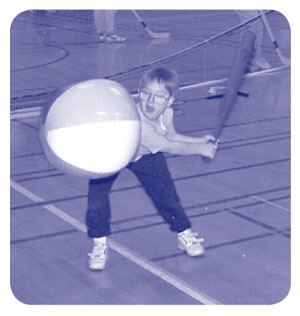 A student hits a beach ball with a bat in a gym.
A student hits a beach ball with a bat in a gym.
Adaptations
- Lower the objects and practice kicking skills.
- Raise the objects on the strings, and work on the overhand throw or serving motion.
- Put bells in the balls or balloons used by students with visual impairments. Use bright balls and balloons for students with low vision. Use beep baseballs.
- Provide assistance to students who have difficulty performing the striking skill. Use trained, peer tutors.
- Make the balls softer/harder depending upon need.
- Increase or decrease the size of the striking object depending upon the ability of the student.
- For students who are deaf or deafblind, provide communication assistance to increase their knowledge of the proper striking stance.
Innovator
Monica Kleeman
Perkins School for the Blind
| GAME |
Beach Ball Volleyball Category: High School |
Goal
To improve sport skills (volleyball) and cardiorespiratory and muscular endurance
Objective
Students volley a beach ball using adapted volleyball rules.
Equipment
Volleyball or badminton net with standards, and a multicolored beach ball
Setup
Use a regulation size volleyball court.
Description
The objective of the game is to see how long the students can keep a beach ball in the air. (Students or staff can keep track of the number of hits or the length of time the two teams are able to continually volley the ball.) The slower flight of the beach ball allows the students with physical disabilities more time to get in position to play the ball. The serve can be a punch, hit, or throw; assistance can be given by other players to get the ball over the net.
Adaptations
- Beach balls of different sizes can be used according to the ability or age of the students.
- Add a teaspoon of uncooked rice to the inside of the beach ball to allow for auditory tracking.
- Use hand clapping or verbal prompts as directional cues for students who are blind.
- Tie the beach ball to the net with long string so students do not have to chase it.
- To make it possible for students limited in movement to successfully participate, use a large balloon; reduce court size; permit one or two bounces; allow students to catch the ball or move closer to the net; permit an unlimited number of hits or people touching the ball; and so on.
Innovators
Karen Allen and Stephen Kearney
Oklahoma School for the Blind
| GAME |
Beep Baseball Category: High School |
Goal
To improve sport skills (baseball)
Objective
The batter must reach a buzzing base before a fielder has possession of the ball.
Equipment
A 16-inch softball containing an auditory beeper; two bases that are 48-inch vertical pylons in which electronic devices emit a buzzing sound when activated
Setup
See diagram.
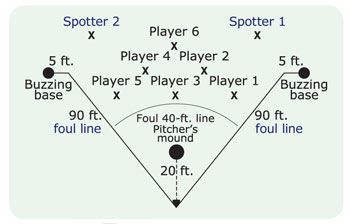 The illustration shows the beep baseball playing field. The pitcher's mound is 20 feet in front of home plate. First base and third base are shown at 2 and 10 o'clock respectively about 90 feet from home plate. There is an arc shaped foul line 20 feet behind the pitcher. It goes from baseline to baseline. There are six defenders or outfielders beyond the foul line: three in the first row, two in the second row, and one in the third row; they stagger each other. Spotter 1 is on the right and Spotter 2 is on the left, both beyond the defenders.
The illustration shows the beep baseball playing field. The pitcher's mound is 20 feet in front of home plate. First base and third base are shown at 2 and 10 o'clock respectively about 90 feet from home plate. There is an arc shaped foul line 20 feet behind the pitcher. It goes from baseline to baseline. There are six defenders or outfielders beyond the foul line: three in the first row, two in the second row, and one in the third row; they stagger each other. Spotter 1 is on the right and Spotter 2 is on the left, both beyond the defenders.
Description
A team is made up of six players who are blind or visually impaired, and two sighted individuals. The sighted participants play pitcher and catcher on offense, and spotters on defense. Players bat on offense, and field on defense. The pitcher tries to hit the bat of the batter with the ball. The batter tries to swing the bat through the same arc each time. A well-hit ball is the cooperative effort of the pitcher and the batter. When the ball is hit, the batter runs to either first or third base, depending upon which base the umpire activates. A run is scored when the batter reaches first or third base before a defender holds the ball off the ground. If a defender picks up the ball before the base runner reaches the base, the base runner is out.
Selected Game Rules
Taken from information provided by the National Beep Baseball Association: NBBA.org
- Games are six innings in length.
- Players with a visual classification of light perception or better must wear blindfolds.
- A minimum of one but not more than two spotters assist the defensive team. They vocally assist the defense in positioning themselves on the field before the ball is struck. They also may advise if a batter
is right-handed or left-handed and provide other data they feel their players should know. Once a ball is struck, a spotter may call out only the name or number of the person in the best position to field the ball.
- A batter is allowed five strikes before being called out. Foul balls are considered strikes, but the fifth strike must be a clear miss.
- A batter may allow two balls to go by without penalty. Any additional balls not swung at will be called strikes by the umpire.
- Each team is allowed three outs per time at bat.
- An out is recorded either by a strikeout or by a struck fair ball that is cleanly fielded by a defensive player prior to the runner reaching the buzzing base. The defensive player must have definite in-hand and off-the-ground possession of the ball in the opinion of the umpire.
- The pitcher must have one foot in contact with the pitching mark (20 feet from home plate) when delivering the ball.
- The pitcher is obligated to give two verbal alerts to the batter. The first, "Ready," must be clearly audible to defense players. This means the pitcher is about to deliver the ball. The second, "Pitch" or "Ball," must also be audible to the defense players and must be said as the ball is released.
Adaptations
- Provide students—who have trouble locating the base—a sighted guide, or the base may be moved closer.
- Students who have difficulty locating the ball may be given verbal prompts as needed and/or provided physical assistance.
- Students unable to hit a pitched ball may use a batting tee and/or be provided physical assistance.
- Large bases may be replaced by clapping or a sound device the batter can hear.
Innovator
Contributed by Jim Cowart (retired)
California School for the Blind
| GAME |
Bell Balloon Bash Category: Elementary School |
Goal
To improve fundamental motor patterns and skills, agility, balance, cardiorespiratory endurance, and sport skills
Objective
Each student follows his bell balloon around the gym with a previously chosen locomotor skill and kicks the balloon when it is located.
Equipment
Balloons with bells inside and a large gym floor
Setup
Each student is given a balloon.
Description
Students kick the bell balloon and use the chosen locomotor skill (such as skipping, hopping, sliding, etc.) to locate the balloon and kick it again. It is suggested that the locomotor skill chosen be one that the student has already performed successfully. Be sure that any student who is totally blind is monitored for safety.
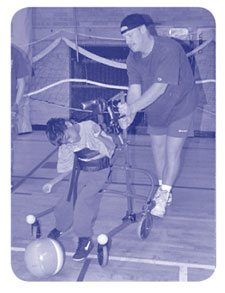 An instructor assists a boy in a prone stander who is kicking a ball.
An instructor assists a boy in a prone stander who is kicking a ball.
Adaptations
- Students use a chosen locomotor skill and kick the balloon up to a cone and back.
- Use sighted, trained peer tutors as guides for students who are blind.
- Use a guidewire pulled across the gym to guide a child who is blind.
- Students practice doing the locomotor skill fast or slow while going after the bell balloon.
- Students locate the balloon while changing from one locomotor skill to the other.
- Use a big therapy ball or Rib-it-Ball instead of a balloon.
- Count how many times students can kick the balloon in a minute while using the chosen locomotor skill.
- Students select the locomotor skill themselves.
- Use a large balloon and have students in wheelchairs push themselves to the balloon, or have those using crutches ambulate to the balloon.
- A teacher or volunteer can assist students who are deafblind to locate the balloon.
- Play the game on scooters.
Innovator
Lauren Lieberman
The College at Brockport-SUNY
| GAME |
Bell Tetherball Category: Recreation |
Goal
To improve fundamental motor patterns and skills
Objective
Participants use tetherball skills to wrap the ball and string around the tetherball pole.
Equipment
A volleyball standard or tetherball standard; string or cord; a soft ball such as a punchball, beach ball, balloon, Rib-it-Ball (add grommet), or Balzac Ball. If needed, have some type of auditory element such as bells, rice, or popcorn kernels inside.
Setup
Tie string or cord to the standard and to the ball at the appropriate height. Secure the ball approximately a foot above the participant's head if trying to promote the overhead throw, shoulder height for encouraging sidearm motion, waist level for the underhand throw, and on the ground to promote kicking.
Description
After organizing the game for the desired skill, set up the standard with one participant on each side. Tell each participant to hit the ball past the opponent using the appropriate skill. The "round" is over when the string and ball are wrapped all the way around the pole. Additional rounds are played as time allows.
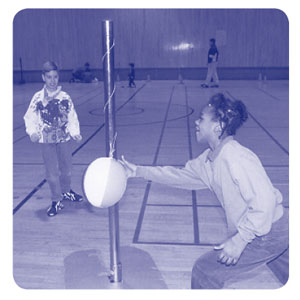 An instructor demonstrates how to hit the tether ball to her student; the cord of the ball wraps around the pole.
An instructor demonstrates how to hit the tether ball to her student; the cord of the ball wraps around the pole.
Adaptations
- Participants in chairs play with ambulatory participants; however, they may need rule modifications (e.g., no more than two hits in a row, no smashing the ball, etc.).
- Softer balls may be used for participants who are tactile-defensive or are afraid of harder balls.
- Allow participants to choose the height of the ball and the skill.
- Participants who need more skill development may practice without competition. For example, give the command, "Hit the ball overhead until it is totally wrapped around the pole." This approach allows the participants to be independent while working on a skill at the same time.
Innovator
Lauren Lieberman
The College at Brockport-SUNY
| GAME |
Body Painting Category: Aquatics |
Goal
To increase water adjustment and flexibility
Objective
Students practice total body washing/showering.
Equipment
Body paints (water-based paint), paintbrushes, washcloths, and soap
Setup
Locker room or shower, students and staff wear swimsuits
Description
Individuals body-paint themselves and/or each other using water-based paints in bright colors. Use terms such as, "Can you paint your knee?" "Can you make your elbow red?" "Paint your partner's feet blue!" and so on. After painting, students shower, being sure to wash or scrub to remove all the paint.
Adaptations
- Direct the activity to include specific identification of body parts—for example, paint legs, wash legs.
- Direct the activity to include color identification—red on the right leg, blue on the left, and so on.
- Students with low vision or no vision may want to use a specific textured paint.
Innovator
Sue Grosse
Milwaukee High School of the Arts
| GAME |
Bowling Pin Position Category: Recreation |
Goal
To improve sport skills (bowling)
Objective
Participants deliver a bowling ball. The teacher alerts participants to the number of standing pins; in turn, the participants relate the position/location of the standing pins.
Equipment
Bowling guide rail, bowling ball (6 pounds and heavier), bowling pins, and a magnetic pin position board
Setup
Set up equipment at a community bowling establishment or school gym.
Description
The participant becomes aware of pin position through practice (consistently rolling a bowling ball toward the pins). Once the delivery begins to become consistent, the participant is ready to learn how to convert spares. Initially, the instructor uses a magnetic pin position board to assist students with visual impairments in learning bowling pin numbers as well as their position on the pin deck. Through feeling and with verbal input from the instructor, most participants learn quickly. Once the participant is aware of pin numbers and position, the instructor tells the participant the numbers of the pins left standing after the participant's first and/or second delivery of the ball. In turn, the participant tells the teacher the position and location of the standing pins. For example, the participant is told pins 6, 7, and 10 remain standing after delivery; in turn, the participant tells the instructor that #7 is on the left side of the pin deck, and #6 and #10 are on the right side. Participants enjoy the challenge of stating pin position without making an error.
Adaptations
- Participants with limited mobility can sit on a chair at the foul line to deliver the bowling ball.
- Participants who are blind or deafblind may benefit from the following options:
- A bowling guide rail—This is used to direct the participant from the beginning of an approach to the foul line.
- A magnetic pin position board—Ten small magnets are placed on a metal base (4 inches by 4 inches) as they are positioned on the pin deck. The top of each magnet and its position on the metal base is brailled with the numbers 1-10. Magnets can be easily removed by the teacher to represent a pin or pins knocked down. By feel, a participant can easily determine the numbers of the pins knocked down as well as the location of standing pins. A board constructed to use Velcro® instead of magnets is another option.
- A gutter guard can be used to ensure no balls go in the gutter, thereby increasing success.
Innovator
Jim Cowart (retired)
California School for the Blind
| GAME |
Box Ball or Bucket Ball Category: Elementary School |
Goal
To improve agility, balance, cardiorespiratory endurance, and fundamental motor patterns and skills
Objective
Students follow a sound source using a designated locomotor skill, pick up a ball, return to the starting line, and pass the ball down to the next person in line.
Equipment
Several small balls that can be handheld, buckets or boxes that are big enough to hold the balls, and a beeper/portable sound source, or caller
Setup
Organize an equal number of players on each team (three players on each team is ideal); have half of the teams on opposite ends of the room.
Description
The players from each team are matched up according to similar abilities and assigned like numbers by the teacher. For example, both number 2s are students who are blind, both number 3s are partially sighted, etc. The teacher or volunteer stands between the two opposing teams with a box that contains the balls and the beeper. The teacher or volunteer calls out a number. The students who have been assigned that number travel in a prescribed manner (walk, jump, run, creep, bear walk, roll, scooter board, etc.) to the box, find a ball, and return it to their respective team. The activated beeper allows students who are blind to find the box with the balls, while teammates' voices provide a directional cue for the students' return. Upon reaching his or her team, the student passes the ball down the line of students to the last player. At this point the next number is called, and that student takes his or her turn. Play continues until all have had an opportunity to participate.
Adaptations
- The teacher can change the way the students pass the ball down the line; for example, pass the ball around the waist, touch the ball to the toes, pass the ball between the legs, etc.
- Hold up cards with locomotor skills and/or numbers written on them to assist deaf children.
- Have two or more students participate at the same time.
- When necessary, staff assists students who have physical disabilities and/or are deafblind to perform the designated locomotor movement, carry the ball, and so forth.
- Students with deafblindness use a cord taped to the floor, or a guidewire, as a guide to the box.
- Students in wheelchairs push forward, backward, fast, slow, and so forth to the box.
Innovators
Karen Allen and Stephen Kearney
Oklahoma School for the Blind
| GAME |
Bright Objects Category: Elementary School |
Goal
To improve fundamental motor patterns and skills, agility, balance, and cardiorespiratory endurance
Objective
Students perform a chosen locomotor skill to reach a bright object on the floor, pick it up, and take it to a designated area.
Equipment
Beanbags, foam shapes, water balloons, and yarn balls (any group of objects from which the student would need to choose a specific color, shape, or size)
Setup
See photograph.
Description
Several beanbags (or other objects) are placed around the players. The teacher then tells the students to perform the chosen locomotor skill to locate a beanbag and take it to a designated line or container. This sequence continues until all the beanbags are picked up.
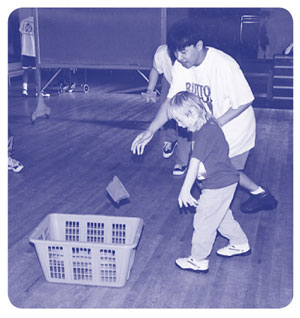 An older student assists a younger student with throwing a beanbag into a laundry basket.
An older student assists a younger student with throwing a beanbag into a laundry basket.
Adaptations
- Use a thematic approach, for example one in which apples are retrieved (harvest in the fall) and placed in a basket or bucket of water (include bobbing for apples when all have been retrieved). Other thematic ideas include "herding," in which students pick up stuffed animals and return them to the corrals; "parking cars," in which toy vehicles are retrieved and put in the parking lot; or "picking flowers," in which students pick up bunches of plastic flowers and place them in vases, pots, etc.
- Have students refine previously learned skills or practice newly learned skills.
- Students pick up all the round beanbags, all the red beanbags, all the small beanbags, etc.
- Students who are blind can locate beanbags by following a cord on the floor, a guidewire, a sound source, or use a sighted guide.
- Staff assist students who have deafblindness or have multiple disabilities to move in the play area as needed.
Innovator
Lauren Lieberman
The College at Brockport-SUNY
| GAME |
Bucket Play Category: Aquatics |
Goal
To improve water adjustment and flexibility
Objective
Students perform a variety of motor tasks that require handling and manipulating objects in the water.
Equipment
Buckets, pails, tubs, scoops, poker chips, cups, sponges
Setup
Individuals should wear swim attire. Locker room, room with drain in floor, outdoor grass or solid surface, or shallow children's wading pool
Description
Individuals manipulate various objects to pour, scoop, measure, dump, retrieve, splash, wash, and generally handle water in as many ways as possible.
Adaptations
- Vary the motor task to change the skill. For example, picking up poker chips from underwater is a fine motor task; pouring from a large bucket into a small cup is a large motor task.
- Alter the temperature of the water by adding ice cubes.
- Vary the texture of items used. A soft cloth feels different from a sponge with a scrubbing surface on the back.
- Add intensity to the task when washing and scrubbing.
Innovator
Sue Grosse
Milwaukee High School of the Arts
| GAME |
Busy Bee Category: Elementary/Middle School |
Goal
To improve fundamental motor patterns and skills, agility, balance, and cardiorespiratory endurance
Objective
Students touch identified body parts on themselves or their partner; designated locomotor skills are used when finding a new partner.
Equipment
None
Setup
Divide the class into pairs. If there is an odd number, the instructor can play.
Description
Each student faces his or her partner. One individual starts the activity by calling a body part—for example, hands to hands, nose to nose, elbow to elbow, etc. Partners in turn touch that body part. When the caller calls "busy bee," everyone finds a new partner using the designated locomotor skill, and the game begins again.
Adaptations
- A student who is deafblind can sign a body part to
a peer or adult translator, who in turn verbalizes the direction to the rest of the class.
- The speed at which the body parts are called can be increased as students become more proficient.
- Discuss with the students any differences they noticed in their partners—for example, partner is shorter, partner's arms are longer, weight differences, etc.
- Students with physical disabilities participate within their ability.
- A staff member or volunteer signs the body parts to students who are deaf or deafblind.
- When changing partners, have students utilize locomotor skills within their ability.
- Use music when partners change.
- Use a pool noodle to touch body parts.
Innovator
Linda Gingery (retired)
Michigan School for the Blind
| GAME |
Call Ball or Spud Category: Elementary/Middle School |
Goal
To improve fundamental motor patterns and skills, agility, and balance
Objective
A student retrieves a bouncing ball and hits a classmate by rolling the ball.
Equipment
Ball (bell ball, electronic sound-emitting ball, playground ball)
Setup
The students gather in the middle of the room.
Description
One person has the ball and throws it up above his or her head with two hands and calls a person's name. The person called has to locate the bouncing ball and call "spud" when it is in his or her possession. The other students scatter around the gym and keep moving until they hear the word "spud." When the students hear "spud," they stand in place and clap their hands. The person with the ball rolls it at a clapping player and tries to hit his or her legs. A student who is hit with the ball is assigned a score of one potato. A player who receives a third potato must execute a designated task (e.g., animal walk). Once completed, the student then reenters the game. After a player is hit, the ball is given to another classmate, who continues the game.
Adaptations
- When necessary, assign each student who is blind or deafblind a trained peer tutor. Also provide an aid/paraeducator when necessary for each student with a physical disability. They can assist students to move appropriately, roll the ball, clap at a designated time, and so on.
- Use more than one ball at a time.
- The game can be played with partners.
Innovator
Linda Gingery (retired)
Michigan School for the Blind
| GAME |
Can Game Category: Elementary/Middle School |
Goal
To improve fundamental motor patterns and skills
Objective
Students execute an overhand and underhand throw at a designated target for distance and/or accuracy.
Equipment
Hula Hoops, 10 or more empty soda cans per Hula Hoop®, and five or more beanbags per student
Setup
Place Hula Hoops on the floor or ground with cans inside each hoop. Students stand a challenging distance away from the soda cans.
Description
This can be an individual or group activity. Give each student five or more beanbags. The instructor, trained peer tutors, or volunteers tap the soda cans to cue the students where to throw. The students in turn throw the beanbags at the soda cans using either an overhand or underhand throw, in an attempt to knock over as many cans as possible. After each throw, students are told the number of cans hit. Students keep their own scores and/or a group score. The staff may return the beanbags by sliding them on the floor to the students' feet.
Adaptations
- Place the soda cans (targets) on tables to encourage students to aim higher.
- Move the students farther away for a greater challenge.
- Students use different throws such as sidearm, underhand, or overhand.
- Students who are blind or deafblind may need a staff person to help position them in preparation for their throws, assist them to "feel" how far away the cans are before throwing, keep score, give feedback on their throws, and so on.
- Place beepers adjacent to Hula Hoops as a directional cue.
Innovator
Beth Hudy
Royer Greaves School for the Blind
| GAME |
Challenge Tasks Category: Elementary School |
Goal
To improve fundamental motor patterns and skills, balance, and agility
Objective
Students use basic movement skills in a variety of challenge tasks.
Equipment
Depends on challenge tasks
Setup
Students are spread out around the gym.
Description
A major area of emphasis in physical education for young children who are visually impaired with multiple disabilities is to help them develop their basic movement skills. In many cases, it is necessary to use the teaching strategies covered earlier as well as behavior modification to teach lower-functioning students. Once a student comfortably performs movement patterns (running, jumping, hopping, galloping, rolling, etc.) within his or her abilities, encourage the student to refine these patterns through such activities as challenge tasks in preparation for later participation in low-level organized games. Examples of challenge tasks for jumping are noted below:
Can you...
- jump really low?
- jump really high?
- jump really far?
- jump a short distance?
- jump and land on your toes?
- jump over a rope?
- jump forward/backward?
- jump with your feet close together?
- jump with your feet far apart?
Adaptations
- Within the same challenge, allow each student to demonstrate the tasks within his or her capabilities.
- To communicate with each child, use his or her preferred means of communication.
- If a student has difficulty understanding or performing the tasks, use the most appropriate teaching strategy in order to assist the student to perform the desired movement.
- Use trained peer tutors to work 1:1.
- Perform tasks to music.
- Develop routines with consecutive tasks.
- If a child uses a wheelchair, have him or her perform gross motor arm movements, or push the chair in a designated area.
Innovator
Jim Cowart (retired)
California School for the Blind
| GAME |
Clean Up Your Room! Category: Aquatics |
Goal
To improve water orientation, group cooperation, balance, agility, and cardiorespiratory endurance
Objective
Students move around the playing area, locate a ball, and push it toward the opponent's area, continuing the activity for 3 minutes.
Equipment
Two lane lines and twice as many small floating balls as there are people
Setup
Put lane lines in a "T" formation in the pool with at least 10 balls on each part of the "T."
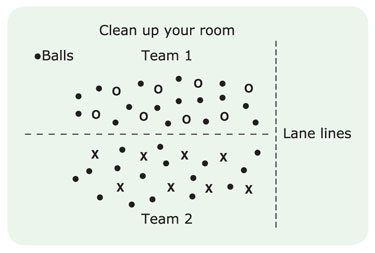 The illustration shows dash lines forming the letter "T" lying on its side. There are 10 dots representing balls that are randomly placed above the horizontal line and 10 balls placed randomly below the line. Eight circles represent eight players above the horizontal dashed line and eight Xs represent eight players below the line. The players are interspersed among the balls.
The illustration shows dash lines forming the letter "T" lying on its side. There are 10 dots representing balls that are randomly placed above the horizontal line and 10 balls placed randomly below the line. Eight circles represent eight players above the horizontal dashed line and eight Xs represent eight players below the line. The players are interspersed among the balls.
Description
In shallow water (up to chest deep), secure one lane line widthwise and another lengthwise (see illustration). Next, place equal numbers of students in each rectangle, marked 1 and 2. Then place double the number of balls as students in each playing area. On a signal, students begin to push the balls to the other side. The objective of the game is to have no balls on your side of the pool when the game is stopped. No throwing; balls must be pushed only. Students move constantly to locate and push balls to the opposite side of the lane line. Suggested time limit is 3 minutes. When play is completed, count how many balls are left on each side, or play the game just for fun.
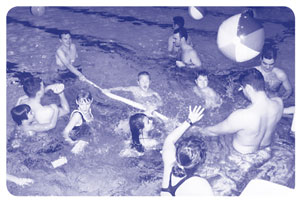 The photo shows two adults holding a line. Students are on both sides of the line. There is a beach ball on one side.
The photo shows two adults holding a line. Students are on both sides of the line. There is a beach ball on one side.
Adaptations
- Use very bright balls for students who are partially sighted.
- Use flotation devices, such as a buoyancy belt or a life jacket, for students with limited mobility.
- Larger balls, balloons, or table tennis balls can also be used (however, table tennis balls may get sucked into the gutter of some pools).
- A sound device can be placed behind one playing area for orientation.
- Helpers can be in the water to orient individuals who have multiple disabilities.
- Helpers can be placed at lane lines to return stray balls and players.
Innovator
Monica Lepore
West Chester University
| GAME |
Clothes Swim Category: Aquatics |
Goal
To improve cardiorespiratory and muscular endurance and increase water adjustment and safety by being prepared for accidental submersion wearing clothes
Objective
Students participate in water activities wearing clothes.
Equipment
Long-sleeved shirts, long pants, old tennis shoes (all clean)
Setup
Pool with depth appropriate to swimming ability
Description
Participants wear clothes over their swimsuits. Students enter the pool and perform usual pool activities wearing their clothes. The class members discuss what is different about being in the pool with clothes on, how it feels, what might happen in an accident situation, and how they can help themselves.
Adaptations
- Expand the activity to include disrobing.
- Expand the activity to include clothing flotation.
- Expand the activity to include using personal flotation devices such as life jackets or buoyancy belts.
Innovator
Sue Grosse
Milwaukee High School of the Arts
| GAME |
Diamond Ball Category: Elementary/Middle School |
Goal
To improve fundamental motor patterns and skills, baseball skills, and muscular strength
Objective
Students hit the ball from a tee and then run the bases in the correct order.
Equipment
- Five eyehooks
- Batting tee
- Yellow ski rope or equivalent
- Wiffle® ball with bell pushed inside or beep baseball
- Oversized bat
- Rubber bases
- Athletic tape
- Large box or basket
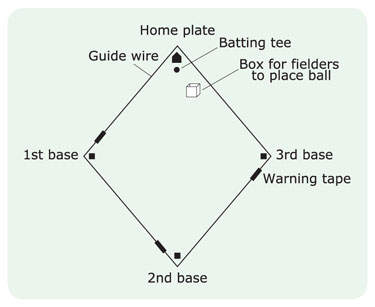 The illustration shows a guidewire in the shape of a diamond. The top of the diamond is home plate with a batting tee. The remaining three corners of the diamond are 1st, 2nd, and 3rd base. Each base has a warning tape indicator on the guidewire just before the base. There is a box inside the diamond and close to home plate for the fielders to place the ball.
The illustration shows a guidewire in the shape of a diamond. The top of the diamond is home plate with a batting tee. The remaining three corners of the diamond are 1st, 2nd, and 3rd base. Each base has a warning tape indicator on the guidewire just before the base. There is a box inside the diamond and close to home plate for the fielders to place the ball.
Setup
On gym walls, place eyehooks as noted in the diagram. Secure rope to each eyehook, forming the shape of a baseball or softball diamond. Place tape on the rope approximately 10-15 feet from each base; this serves as a warning to the base runner that he or she is approaching a base. Tape rubber bases to the floor in their proper places.
Description
One of the hardest concepts to understand for a number of children who are blind is the baseball or softball "diamond." Diamond ball was developed to help communicate this concept. Students are divided into hitting or fielding teams. Members of the fielding team are positioned in the field. When the ball is hit by a member of the hitting team from the tee, any player in the field may retrieve the ball. The object for the fielding team is to locate the ball and place it in a box located to the side of home plate as quickly as possible. Scoring for the batting team occurs in the following way: after hitting the ball from the tee, the batter grasps the guide rope and runs to first base; if he or she reaches the base before the ball is placed in the box adjacent to home plate, one point is scored. If the base runner reaches second base before the ball is placed in the box, two points are scored; three points are awarded for a triple, and a home run is worth four points for the batting team. When everyone on the batting team has batted, the teams switch positions. Points earned are tallied for each team.
Adaptations
- Students who are blind stand on a rubber mat to establish a sense of direction when they bat.
- If a beep baseball is not available, bells placed inside a Wiffle ball provide an adequate sound substitute for the fielding team; in addition, verbal prompts will be necessary to aid students who are blind to locate a stationary ball in the playing field or on the batting tee.
- A teacher, an aide, or a volunteer can provide assistance as needed when students with physical disabilities are batting, fielding, etc.
- Students who have more abilities may swing at a pitched ball on either the fly or the bounce if a playground or soccer ball is used.
- If eyehooks are not available to secure the guide rope to the wall, check with the school's maintenance staff for another method of attaching the rope.
Innovator
Candace Rehmeier
Nebraska Center for the Education of Children who are Blind or Visually Impaired
| GAME |
Diving in! Category: Aquatics |
Goal
To learn to dive
Objective
Students lie down on a mat that goes from the deck of the shallow end of the pool into the water and slide in head first in a dive position.
Equipment
6' × 8' or larger waterproof mat
Setup
Allow 2⁄3 of the mat to be on the pool deck and 1⁄3 to be in the pool.
Description
- Students lie on their stomach in a front dive position and slide head and arms first into the shallow end of the pool.
- Once they master this activity, move to the 8 feet section of the pool. Students dive from a sitting position into the pool.
- Once they mastered this activity, they dive from a kneeling position into the pool.
- Once they have mastered this activity, move to the deep end of the pool. Students dive from a standing position into the pool.
- Once they mastered this activity, they dive from a diving board into the pool.
Adaptations
- Use tactile pose cards.
- Physical guidance from instructor with verbal instructions
- Tactile modeling by instructor or a peer
- Use interpreters for individuals with deafblindness.
- Use peer tutors who work 1:1 with individuals.
Innovator
Monica Lepore
West Chester University
| GAME |
Duck Swim Category: Aquatics |
Goal
To improve arm and leg strength, stroke pattern, cardiorespiratory and muscular endurance, and flexibility
Objective
Students practice arm and hand position and/or leg position during stroking action. Improved positioning will result in increased muscle strength and more efficient stroke.
Equipment
Swim fins and Wave Webs® (hand mitts with webbing between the fingers)
Setup
Pool with depth appropriate to swimming ability
Description
Students perform the arm stroke pattern and/or leg kick pattern wearing mitts and/or fins (use either mitts or fins-—not both at the same time—until individuals get used to them). Fins are particularly useful for crawl stroke kicks. Mitts can be used for any arm pattern.
Adaptations
- Vary the size of the fins. Stiffer, larger fins require more leg strength. Smaller, more flexible fins require less leg strength.
- Vary the hand position once mitts are on. The desired form (end result) is fingers together. When fingers are spread, the web action of the mitt is used. This helps participants learn the reason for cupped hands and builds arm strength.
Innovator
Sue Grosse
Milwaukee High School of the Arts
| GAME |
Find the Ducky Category: Aquatics |
Goal
To improve water adjustment, auditory focusing in the pool, spatial orientation, and cardiorespiratory endurance
Objective
Students locate and move to touch a squeaky toy.
Equipment
Plastic duck or other floatable identified toy that makes a noise
Setup
In the pool, rope off a shallow area.
Description
Within a contained shallow area, individuals move to locate and touch a toy they hear squeaking or making a noise. The toy is activated by the teacher, aide, or other students.
Adaptations
- Use several different toys with different sounds. Put them in a variety of locations. Individuals must locate a specific toy with a specific noise.
- Individuals must perform a specific locomotor movement to get to the noise.
- Students may perform the activity with partners.
- Students who are deafblind or with physical disabilities may need help to understand the game, locate the ball, and so on.
Innovator
Sue Grosse
Milwaukee High School of the Arts
| GAME |
Fitness Wheel Category: Recreation |
Goal
To improve flexibility, strength, muscular and cardiorespiratory endurance, and fundamental motor patterns and skills
Objective
Participants spin the fitness wheel, identify area to which the dial is pointing, and perform assigned task.
Equipment
A spin dial (homemade or from an old board game) and objects to place on the dial as needed
Setup
Make a dial with different exercises printed on it such as skipping, galloping, jumping jacks, sit-ups, push-ups, running laps, etc. The skills and exercises should also be printed in braille. This dial or an additional dial may be made with pictures of the activity as well as words to give the participants more information. For participants who are deafblind, make a dial with shapes and objects to represent exercises, such as a soft piece of fabric (representing a mat) for push-ups and sit-ups; a small card for running laps; a balloon for skipping and galloping; and a piece of Velcro® for jumping jacks, etc.
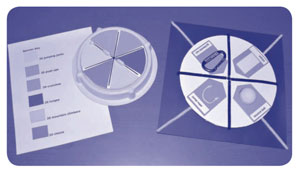 The photo has two types of tactile spinners. One uses textured papers and a key to know what each texture represents, i.e. smooth to represent 20 lunges. The other spinner uses tactile communication symbols, i.e. piece of rope to represent jumping rope.
The photo has two types of tactile spinners. One uses textured papers and a key to know what each texture represents, i.e. smooth to represent 20 lunges. The other spinner uses tactile communication symbols, i.e. piece of rope to represent jumping rope.
Description
Play this game as individuals or in teams. A participant spins the dial; when the dial stops, the participant identifies (by either the word or object) the exercise to be performed. Identification of the correct exercise earns the participant a point. The participant then performs the skill. Participants who perform the skill correctly get one point. Each person gets a turn. The person/team with the most points wins.
Adaptations
- Give each participant a dial adapted to his or her ability level.
- Use different activities for different units, such as different types of throws for a throwing unit, different gymnastic moves for a gymnastics unit, and different locomotor skills for a locomotor skills unit.
- Use the same approach with aquatics skills (or locomotor skills) in the pool.
- If the group includes participants with physical limitations, add challenging but attainable skills to the fitness wheel for them.
Innovator
Beth Hudy
Royer Greaves School for the Blind
| GAME |
Flower Hunt Category: Aquatics |
Goal
To improve underwater swimming, breath control, search and find technique, and cardiorespiratory endurance
Objective
Students swim underwater, locate an object, and then surface.
Equipment
Plastic flowers, each flower is attached to enough washers to make it sink. Use two to three times as many flowers as there are students, depending upon their ability.
Setup
Place the plastic flowers in a straight line across the bottom of the shallow end of the pool.
Description
Swimmers (three or four at a time) submerge at the wall and probe the bottom of the pool with their hands to grab the flowers. They must swim with the flowers to the other side and show the teacher what they have found. Then the students drop the flowers to the bottom of the pool for the next group.
Adaptations
- Let students walk until they feel the flowers and then bob down to get them.
- Allow beginner swimmers to retrieve flowers with their feet.
- Students with limited ability can retrieve floating flowers or flowers placed in close proximity.
- Adapted from American Red Cross film Focus on Ability.
Innovator
Contributed by Monica Lepore
West Chester University
| GAME |
Football 5-a-Side Category: Middle/High School |
Goal
To play the game of soccer with sighted or blind peers
Objective
Individuals play the game of soccer blindfolded 5 vs. 5 with a sighted goalie
Equipment
Soccer ball with bells, sound source behind the goal, soccer field, soccer goals, blindfolds
Setup
Set up on a soccer field with the sound source behind each goal. Make sure each player is oriented to the field before play starts.
Description
Football 5-a-Side is played by athletes with blindness/visual impairment, with one sighted player as the goalkeeper. There are five players per team and each game lasts 50 minutes. Rules are the same as able-bodied football/soccer with certain modifications: the ball makes a noise when it moves, the goalkeepers may be sighted and act as guides during the game, the rest of the team uses eyeshades to ensure fairness, the field-of-play measurements are smaller, and there is no offside rule. The game consists of two, 25-minute halves. The Football Subcommittee of the International Blind Sports Federation (IBSA) governs this sport, following modified rules of the International Federation of Association Football (FIFA). It is played by athletes in over 30 countries. The first national Football 5-a-Side Championships took place in Spain in 1986. Since then, the sport has developed rapidly around the world and made its Paralympic debut in Athens in 2004.
Adaptations
- Orient all players to the field before play starts.
- Use a tactile board to show where the goals are set up and where the penalty lines are located.
- Use physical guidance from instructor with verbal instructions at the beginning.
- Use tactile modeling by instructor for teaching kicking and throw ins.
- Use interpreters for individuals with deafblindness.
- Use peer tutors or paraeducators who work 1:1 with individuals.
Innovator
Lauren Lieberman
The College at Brockport-SUNY &
International Blind Sports Federation
| GAME |
Frisbee Bell Hockey Category: Middle/High School |
Goal
To improve sport skills (hockey), agility, balance, and cardiorespiratory and muscular endurance
Objective
Students play hockey using a bright Frisbee® with bells for tracking.
Equipment
Frisbees, bells, string, enough hockey sticks for each student, and cones or hockey goals
Setup
Tie strings across the bottom of the Frisbee from one side of the rim to the other with three to five bells attached to the string evenly across the bottom. Because the Frisbee is brighter and slower moving and forms a larger target to hit, it serves well as the puck or ball in a hockey game for many students especially students with visual impairments.
Description
Divide the class evenly. Have one team in red pinnies and one in blue (or shirts and skins, white and dark—whatever helps distinguish teams). Play the game of indoor hockey using the Frisbee with bells. The Frisbee with bells promotes increased success and elevates the level of excitement in a game.
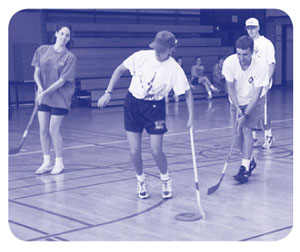 A group of teens play hockey on a gym floor using a Frisbee®.
A group of teens play hockey on a gym floor using a Frisbee®.
Adaptations
- Use lead-up activities such as "dribbling" the Frisbee around cones under control, hitting the Frisbee back and forth with a friend, or shooting the goal from different angles and distances.
- For students in wheelchairs, the grip on the hockey stick may have to be modified, or the time given to hit the Frisbee may need to be increased. You may also want to duct tape the stick to the chair of a student who uses an electric chair. You may also make a rule that a particular student must hit the Frisbee before that team can score.
- A guide or trained peer tutor may be needed for students with less vision.
- The use of flags and signs can aid in communication for students who are deaf.
- Use a beep baseball as the puck.
Innovator
Lauren Lieberman
The College at Brockport-SUNY
| GAME |
Frisbee Golf Category: Middle/High School |
Goal
To improve sport skills (Frisbee®) and cardiorespiratory endurance
Objective
Students throw the disc at the flag and try to get it inside the Hula Hoop® in the least amount of throws.
Equipment
Three to nine bicycle flags (large orange flags), three to nine Hula Hoops, one Frisbee for each student, and one card for each student with a pen to keep score
Setup
In a field or big grassy setting, set the bike flags inside the Hula Hoops. Space flags 4-20 feet from each other depending upon the throwing ability of the students. Many towns have disc golf courses in parks. Students can learn how to use their hometown courses.
Description
Students start at flag #1. From there they throw the disc to the #2 flag and land it in the Hula Hoop around the flag. Students try to accomplish this goal with the least amount of throws possible. Students add up how many throws it takes to complete the course, as in the game of golf. The course may be set up with 3 flags all the way up to 18 flags depending upon class time and student ability. Students with limited vision and/or hearing may need help with the direction of the flag. (Use a sound source.) When the students get closer to the Hula Hoop, they can feel the hoop and then walk to their disc to understand the distance between the two.
Adaptations
- Students with low vision may prefer a particular color disc in order to see the contrast against the grass or gym floor.
- Students may want to compete only against themselves, or against other students. At the end of the unit, the staff (blindfolded) can compete against the students!
- If the space is limited, or if only an indoor area is available, set up the same formation with cones in the middle of the hoops.
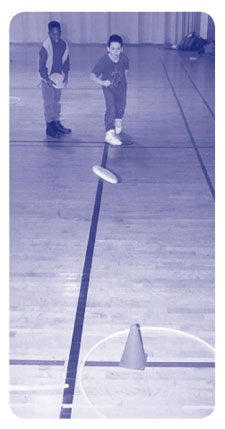 A boy tosses a Frisbee® at a cone inside a Hula Hoop on the gym floor. Another boy waits his turn holding his Frisbee.
A boy tosses a Frisbee® at a cone inside a Hula Hoop on the gym floor. Another boy waits his turn holding his Frisbee.
- Students with limited range of motion or limited gripping ability may have flags set closer together, start 2-3 feet from each flag, or use a beanbag instead of a disc.
Innovator
Lauren Lieberman
The College at Brockport-SUNY
| GAME |
Goalball Category: Middle/High School |
Goal
To improve sport skills (goalball), agility, cardiorespiratory endurance, flexibility, and muscular endurance and strength
Objective
Students try to roll the goalball over the goal line of their opponents.
Equipment
Goalball (purchased through the United States Association for Blind Athletes), knee and elbow pads, blindfolds, nonstretch rope or cord, and 3-inch-wide gym floor tape. Be sure tape does not mark the gym floor.
Setup
Define the playing area as shown in the diagram. Use cord held to the floor by tape.
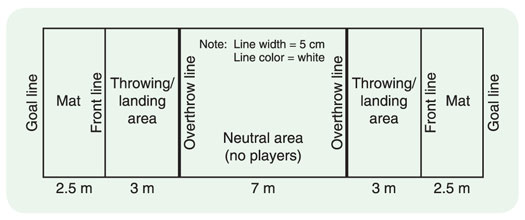 The illustration shows the goalball playing area. It is a rectangle. The middle 7m is the neutral area where there are no players. The end of the neutral area is designated by the Overthrow line. On each side of the neutral area is the 3m throwing and landing area. Its end is designated by the front line. The next and last area is the 2.5m mat area and its end is designated by the goal line.
The illustration shows the goalball playing area. It is a rectangle. The middle 7m is the neutral area where there are no players. The end of the neutral area is designated by the Overthrow line. On each side of the neutral area is the 3m throwing and landing area. Its end is designated by the front line. The next and last area is the 2.5m mat area and its end is designated by the goal line.
Description
The teams may consist of up to six players, with no more than three players per team on the court at one time. Substitutions may be made during any stoppage of play. Each player must wear a blindfold during the course of the game. The referee (teacher or peer) should prohibit all crowd noise, especially coaching from the crowd. The team starting with the ball (offense) rolls the goalball on the ground at the other team with the intention of scoring. Scoring occurs when the goalball crosses the goal line or back line in the court. The team receiving the ball (defense) tries to stop the ball by diving in front of it and gaining possession of the ball without the other team scoring. That team then becomes the offensive team. Each team has a center (the player at front and middle) and two wings, playing one to the right of center and one to the left, 2-3 feet behind the position of the center.
Penalties
- No player may defend the ball in front of the "front line" of his or her playing area.
- Players may not use vision in any way.
- Once possession of the ball is obtained, the offensive team has 8 seconds to roll the ball.
- No player may roll the ball more than two consecutive times for his or her team.
- Any balls rolled by the offensive team must contact the ground at least once before crossing the "overthrow line."
Penalty Shot
When a penalty shot is awarded, the player who caused the penalty remains on the court while his or her teammates leave the court. The penalized player has to single-handedly defend against a penalty throw. Any player who is on the offensive team at the time of the infraction may take the penalty throw. Following the penalty throw, play stops while the removed players return to the court.
Adaptations
- For students who are deafblind, use a peer or teacher to tap their shoulder to indicate ball position-soft and to the right for a ball that is close to them on the right, soft and left for a ball that is
close to them on the left, harder and to the right for a ball for which they need to dive to the right, and harder to the left for a ball arriving farther to the left.
- Students with limited lower-body control start in a kneeling or sitting position.
- Use a task-analysis approach for students unable to throw or catch the goalball.
More information about goalball, the rules, training camps, and tournaments can be obtained from the United States Association for Blind Athletes (USABA.org).
Innovator
Lauren Lieberman
The College at Brockport-SUNY
| GAME |
Golden Sneaker Club Category: Recreation |
Goal
To improve cardiorespiratory and muscular endurance and sport skills (track)
Objective
Participants are given two class periods (or recess time) a week in order to walk and/or run at their own pace on the track and/or cross-country course. Participants record the distance walked/run on a large chart; the objective is to reach 25 miles in order to earn a "Golden Sneaker" trophy.
Equipment
Chart for recording miles walked/run, a pedometer (optional)
Setup
Track or any area where distance can be accurately marked
Description
This is an activity that is self-motivating. Participants walk/run using guidewires or sighted guides. They have the option to walk/run either the track or cross-country course during the time provided to give some variety. (The cross-country course can be designed by the participants.) Participants' progress is recorded on a large chart. At the end of the term, every participant who has accumulated 25 miles or more is awarded a "Golden Sneaker" trophy at a special assembly. The trophies can be actual tennis shoes glued to wooden bases and sprayed with gold paint. Lettering on the plaques indicates the participant's name and number of miles walked/run.
Adaptations
- Names on trophies are in braille or large print.
- Students record their progress on a computer.
- Use a talking pedometer.
- For students with limited mobility, require fewer miles walked or wheeled in order to achieve an award.
Innovator
Candace Rehmeier
Nebraska Center for the Education of Children who are Blind or Visually Impaired
| GAME |
Holiday Roller Blading Category: Recreation |
Goal
To improve balance, agility, cardiorespiratory endurance, and sport skills (roller blading)
Objective
Participants rollerblade independently and purposefully around the gym.
Equipment
Four cones, rollerblades, Nyloop wall/board, cutout felt shapes (objects or shapes vary depending on the holiday theme), and Velcro®
Setup
Example: Valentine's Day
Place cones around the gym in a circle (connect them with rope if necessary). At one end of the gym, place the Nyloop target on the wall. Next to the target, place all the cutout hearts on a table (put a small piece of Velcro on the back of each heart). Participants are motivated by a thematic approach to the lesson.
Description
Participants rollerblade around once and pick up a heart. The next time around they place the heart on the Velcro target. Repeat as many times as possible in the time allowed. Challenge the participants to add one more lap each session.
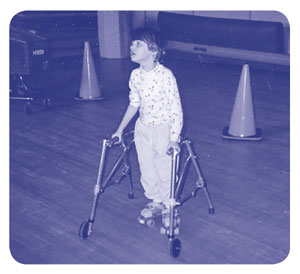 A girl skates in the gym with the support of a walker.
A girl skates in the gym with the support of a walker.
Adaptations
- Change the object or shape according to the new theme: ornaments on a Christmas tree, Easter eggs in a basket, candles on a menorah, stars on a flag, pumpkins on the ground, apples in a tree, and so on.
- Cut out paper shapes and place tape on one side. Participants stick them on the gym wall.
- Have races around the gym or up and back for relays.
- Give each participant a different numbers of laps and objects or shapes according to his or her ability.
- Set up a smaller circular rink for participants with limited mobility and use roller skates.
- This same concept can be used for locomotor skills, walking, running, and swimming laps.
Innovator
Monica Kleeman
Perkins School for the Blind
| GAME |
Home Run Derby Category: High School |
Goal
To improve sport skills (baseball)
Objective
Students play a modified game of baseball. The game is individually adapted to meet the needs of each player.
Equipment
A softball-sized Wiffle® ball—color should contrast with the batting tee and gym walls and floors, an adjustable batting tee or pylons that can be stacked to adjust height, and four rubber bases—color contrast with floor
Setup
Set up the gym with four bases in a diamond shape. Mark scoring areas with colored tape.
Description
Teams consist of four to five players. With teams of this size, the positions are limited to a pitcher and three or four fielders. Each player bats every inning; after all have batted, the teams switch positions. Depending on the batting ability of the students, they can receive a pitched ball or hit the ball off a batting tee. The following game rules apply: Singles, doubles, triples, and home runs are determined by the ball landing in designated areas clearly marked with colored tape. For example, singles are balls hit in the infield, doubles are balls hit in the outfield, triples are balls hit below the 15-foot line on the wall, and home runs are balls hit on or above the 15-foot line. The designated areas can be modified for gym size, ceiling height, and so forth. A student runs to the base that corresponds to his or her hit
(e.g., a student who hits a double runs to second base). The base runner advances according to the hit by the following runner. Runs are scored either by advancing a runner to home plate or by hitting a home run. Imaginary base runners can be used if needed instead of allowing the students to run the bases.
Adaptations
- Play "Drawball," in which students draw a card out of a box that tells if their hit is a single, double, triple, or home run. Students advance bases accordingly. The teams change from offense to defense after all players have had a turn drawing a card.
- Use a brighter, slower, or auditory ball for success.
- Use different sizes of bats depending upon the need.
- Staff, volunteers, or peers can assist students who need help to bat, field, or run bases.
- Students with visual impairments may need a sighted guide or a guidewire when running bases.
- Students in wheelchairs or using crutches may need additional physical assistance.
Innovators
Stephen Kearney and Karen Allen
Oklahoma School for the Blind
| GAME |
Hot Road Potato Relay Category: Elementary/Middle School |
Goal
To improve agility, balance, cardiorespiratory endurance, and muscular endurance
Objective
Students use basic motor skills to run independently, pass off a "potato" to an opposing team member, and gain points for their team.
Equipment
- Guidewire
- Ball or baton (potato)
- Timer
Setup
Set up a guidewire system (see Appendix D) for travel. Divide the students into two teams; position each team at opposite ends of the guidewire.
Description
Set the timer for a random amount of time. One student at a time travels down the guidewire to the opposing team and hands off the "potato." This is repeated until the timer goes off. Teams collect points when the opposing team is caught with the potato when the timer goes off.
Adaptations
- Use the smallest (18") Rib-it-Ball (see Appendix D). Students who have cerebral palsy can grasp and hold onto the ball's ribs. If a student uses a wheelchair, the ribs prevent the ball from rolling off of his/her lap.
- Use scooters for more of a challenge.
Innovator
Tristan Pierce
American Printing House for the Blind
| GAME |
Human Bowling Category: Middle School |
Goal
To increase understanding of bowling and to work on balance, upper body strength, and auditory awareness
Objective
Individuals sit or lie on a scooter and either push themselves or are pushed by a peer down a lane 10-30 feet into bowling pins set up at the end of the lane.
Equipment
Scooters, bowling pins, sound source
Setup
Set up the space so that the bowling pins are set up in a space 10-30 feet away, with nothing in the way between the starting point and the pins. The sound source can be set up behind the pins. See diagram.
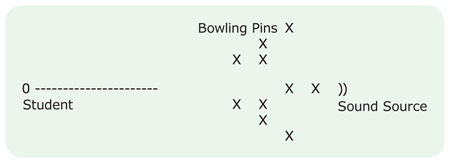 The illustration shows a student standing on the far left and a portable sound source on the far right. Bowling pins are placed randomly between the two but far enough apart so a child on a scooter can move around and in between the pins.
The illustration shows a student standing on the far left and a portable sound source on the far right. Bowling pins are placed randomly between the two but far enough apart so a child on a scooter can move around and in between the pins.
Description
Students sit on the scooter. They choose whether to push themselves or to be pushed to knock down the bowling pins. The students keep track of the number of pins knocked down or play for fun. If a student is blind, he or she can have a peer, paraeducator, or teacher give verbal feedback as to where to go for the pins. A peer can help put the pins back up between frames.
Adaptations
- Use a tactile board to show where the pins are set up and which pins are left.
- Physical guidance from instructor with verbal instructions
- Tactile modeling by instructor
- Use interpreters for individuals with deafblindness.
- Use paraeducators who work 1:1 with student(s).
Innovator
Lauren Lieberman
The College at Brockport-SUNY
| GAME |
"I See" Category: Elementary School |
Goal
To improve fundamental motor patterns and skills, agility, and balance
Objective
Students listen to directions and perform designated movements and balance tasks.
Equipment
None unless stated objective requires
Description
The activity is started by the teacher saying, "I see." Students reply, "What do you see?" If the emphasis of the lesson is on basic movement skills, the teacher may respond, "I see boys and girls jumping up and down," or "I see boys and girls crawling around on the floor." For body awareness, the response could be, "I see boys and girls touching ankle to ankle!" The students in turn perform the designated activities. The possibilities are limitless!
Adaptations
- Allow the students to be callers. Students who are deaf or deafblind can sign the tasks to an adult or peer who in turn gives verbal direction.
- Be sure to include some creative directives to make it fun, such as "I see students creeping like bears," or "I see students squirming like snakes."
- Use cones or chairs and incorporate concepts such as front, back, left, and right.
- Have students pair up; one partner is the caller, and the other is the performer, then switch.
- Provide assistance as needed to students who are physically challenged to perform a skill or substitute skill. Instead of crawling on the floor, a student in a wheelchair can move the chair in a zigzag pattern.
- Give a response that allows each student to perform the task within his or her capabilities—for example, "I see some students jumping and others creeping." Or "I see some students doing a forward roll and others doing a log roll."
Submitted by
Candace Rehmeier
Nebraska Center for the Education of Children who are Blind or Visually Impaired
| GAME |
Jump Tag Category: Elementary School |
Goal
To improve fundamental motor patterns and skills, agility, balance, and muscular strength
Objective
Students use basic movement skills either to avoid being tagged by "it" or, if student is "it," to try to tag other students.
Equipment
Gym walls and mats used for activity boundaries and mini beeper
Setup
One player is selected as "it"; the remaining players are scattered within the playing area. The only way a player can move around the playing area is by jumping (forward, backward, or sideways).
Description
Each game consists of a few minutes; during this time, "it" attempts to tag the other players; a player can be touched more than once during the game. After a player is tagged, the players spread out over the playing area before play is again started. The object of the game is for players to be tagged as few times as possible by "it." The player who has been tagged the least number of times during the game becomes "it" for the next game. To add interest to the game, some players like to include a "safe" position. This is a position players can assume twice
during the game and not be tagged by "it." Players can get very creative in determining safe positions.
Adaptations
- Skills and movements used in a tag game are limited only by teachers' and players' creativity and imagination. Players perform other previously learned skills such as hopping, skipping, galloping, etc.; various animal walks can be emphasized, such as the crab walk or elephant walk; players can pull or push themselves when prone, supine, kneeling, or sitting on a scooter board.
- For students who are blind with hearing, "it" wears a mini beeper that emits an intermittent sound; in turn, the other players regularly call "it's" name. In this way, the players who are blind know the general location of each other.
- For students with some vision and hearing, have "it" wear a blindfold.
- If "it" is deaf with some sight, have him or her perform a more difficult skill that restricts movement, or blindfold the player and have an adult or sighted peer hold his or her arm or hand.
- For a student who is deafblind, have an adult or sighted peer hold the student's hand or arm.
- Students with multiple disabilities (unable to move in designated way) perform a movement skill within their ability (on a bolster, lying on a mat, or in a prone standard).
- Examples of "safe" positions suggested by students include hugging another student, squatting with hands touching the feet, etc. The position can be maintained for a count of five (students count aloud).
- An alternative way to free a tagged player is to have the tagged player do a designated number of exercises or stunts before resuming play.
- Play this game with music.
Innovator
Jim Cowart (retired)
California School for the Blind
| GAME |
Kickball Category: Elementary/Middle School |
Goal
To improve fundamental motor skills and patterns, cardiorespiratory endurance, and sport skills
Objective
Students play a modified version of kickball.
Setup
Students are divided into two teams.
Description
The student who is "up" kicks the ball as far as he or she can and runs the bases as fast as possible. The fielder who retrieves the ball immediately starts to bounce the ball a predetermined number of times—15, 20, 25, depending on the ability of the base runner. When the ball is bounced the required number of times, the base runner has to stop. If the base runner reaches first base, he or she receives one point, second base two points, third base three points, etc. There are no outs; each player on the team has the opportunity to be "up" once or twice, depending upon the time allotted for the game, before teams change positions. When all players have had the opportunity to be up the predetermined amount of times, the teams switch positions.
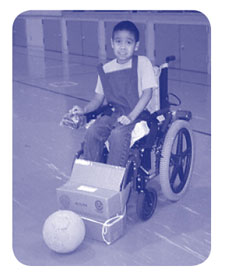 A young boy is in a power wheelchair with a box tied to the wheelchair's footplate. He is kicking a ball with the box.
A young boy is in a power wheelchair with a box tied to the wheelchair's footplate. He is kicking a ball with the box.
Adaptations
- Have all the outfielders bounce the ball a designated number of times—say, 5 or 10—before the base runner must stop.
- Use guide runners for students who are blind, deafblind, or have physical disabilities.
- Use peer pushers for students in wheelchairs who are unable to push their own chairs.
- Have students keep their own scores.
- A student who is unable to stand and dribble the ball can sit or kneel to dribble. The student could also do a predetermined number of air dribbles, passes around the body, or passes between the legs.
- Students who are deafblind or have physical disabilities can be provided assistance as needed when kicking, running bases, fielding, and so on.
- Students with physical involvement may "kick" the ball using any method within their ability—for example, use the hands, arms, or head.
Innovator
John Schrock
Missouri School for the Blind
| GAME |
Lap Counting Category: Aquatics |
Goal
To improve cardiorespiratory endurance, muscular endurance and strength, and independence in swimming laps
Objective
Students swim laps and count independently. Note: Many students who are good swimmers do not swim independently because they are prompt-dependent—that is, they depend on a staff person to tell them to continue each time they reach the end of the pool. Some students will wait at one end of the pool throughout the class period if someone does not tell them to keep going or swim more laps. This behavior is usually associated with autism or intellectual disabilities. This activity will help decrease or eliminate prompts.
Equipment
Large plastic containers and diving rings or sticks
Setup
Place rings or sticks at one end of the pool, and the plastic containers at the other. If students can normally swim 10 laps, give them 11 or 12 rings.
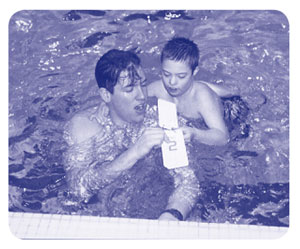 An instructor and boy are in the pool at the wall. They are looking at a flip-over number card.
An instructor and boy are in the pool at the wall. They are looking at a flip-over number card.
Description
Students start swimming from the end of the pool that has the plastic containers. They swim a length, pick up a ring or stick, and swim back to the container. The rings or sticks are placed in the container. Students continue swimming until all rings or sticks have been placed in the container.
Adaptations
- Use objects that are reinforcing to your students.
- Students can swim laps for time.
- Students with limited ability can swim widths of the pool.
- Students who are blind or deafblind can utilize the lane markers and sides of the pool as directional prompts.
- If students have difficulty swimming while holding the ring, create an easy way to carry the object, change the object, use flip cards with numbers to count laps, or place the plastic containers and diving rings at the same end of the pool.
Innovator
Monica Kleeman
Perkins School for the Blind
| GAME |
Leader in the Circle Category: Aquatics |
Goal
To improve pre-swimming skills
Objective
Students take turns leading the class in performing various pre-swimming skills.
Equipment
One ball
Setup
Students get into a circle formation.
Description
Students pass the ball around the circle, singing: "Round and round the circle we go, where it stops nobody knows, 1-2-3-4-5!" When they reach "5," the student with the ball tells the rest of the class which pre-swimming skill to perform as well as the number of repetitions or a time limit—for example, float on your back for 15 seconds, jump up and down 10 times, submerge for 5 seconds, etc.
Adaptations
- Students with limited ability may need a flotation device or physical assistance.
- Students can perform the skills with partners.
- Challenge the better swimmers with more repetitions or more difficult skills.
- Students who are deaf or deafblind may need a volunteer, a teacher, or an interpreter to aid in communication.
- Students with limited mobility may push the ball to pass it around the circle.
Innovator
Monica Kleeman
Perkins School for the Blind
| GAME |
Modern Dance Category: High School |
Goal
To improve agility, flexibility, balance, cardiovascular and muscular endurance, and fundamental motor patterns and skills
Objective
Students perform a dance consisting of familiar moves and music.
Equipment
A large open space and music. Modern funky music tends to motivate the students most.
Setup
Students start in a line or circle formation with arms on each other's shoulders or holding hands. The teacher first explains the moves, then adds music.
Description
Students stand in a line and wait for the teacher's command. The teacher makes moves related to a one-word command. For example, "Circles" means to make arm circles; "Bend" indicates side bends; "Knees" means to march in place; "Up-back" indicates walking forward for eight counts and back for eight counts; "Hips" means to sway the hips. Each move is performed for one or two sets of eight counts. The moves can be as simple or complex as necessary. The goal to keep in mind is student success. Formation can vary from a line, to a circle, to a "U" shape, or in partners. Strive for repetitious movements within each student's capability. When the class has learned five or six moves in a row, put those moves to music, and repeat the sequence. The results will be sensational! Extra teachers, volunteers, and peer tutors will help make the dance successful.
Adaptations
- Students with limited mobility or students who are hard-of-hearing can be placed next to a volunteer, teacher, or peer tutor for the appropriate cue. The students who are deafblind may need a tactile cue.
- After a 6-to-8-week unit, students may elect to perform a dance show!
- Allow the students to form the dance moves using their imaginations.
Innovator
Lauren Lieberman
The College at Brockport-SUNY
| GAME |
Musical Hoops Category: Aquatics |
Goal
To learn to start and stop to music, personal space location, breath control, and to improve cardiorespiratory and muscular endurance
Objective
Swimmers move clockwise around a shallow area in a predetermined movement, duck under a hoop when the music stops, and perform an aquatic skill in the hoop.
Equipment
Hoops and music
Setup
In the pool, equal number of hoops and participants are spread through shallow water (or deep water if students are good swimmers).
Description
To start the game, a helper on the deck puts on music, and all students run, skip, hop, or swim (beginner stroke, breaststroke, etc.), in one direction. When the music stops, all participants feel for a hoop, duck under and into it, and perform a designated skill, such as bob three times or prone floating for 5 seconds (whatever challenges each player). When the music begins again, they resume circling until the music stops again.
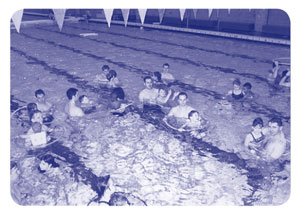 The pool is full of student and swim instructor teams. Most teams have a Hula Hoop®.
The pool is full of student and swim instructor teams. Most teams have a Hula Hoop®.
Adaptations
- For more challenges, vary the locomotor movement or swimming stroke.
- For nonswimmers, stress bobbing, blowing bubbles, and so forth in the hoop.
- Individuals who are more physically disabled can move in a tube; when the music stops, they locate a hoop, place it over their head, and execute a designated skill—for example, move with the assistance of a volunteer or perform a movement within their ability.
- Take away one hoop, allowing two students to share a hoop when the music stops.
Adapted from American Red Cross, 1977, Adapted aquatics: Swimming for persons with physical or mental impairments. Garden City, NY: Doubleday.
Innovator
Contributed by Monica Lepore
West Chester University
| GAME |
Obstacle Course Ideas Category: Elementary School |
Goal
To improve fundamental motor patterns and skills, agility, strength, and balance
Objective
Students have multiple opportunities to practice the skills needed to correctly complete the obstacle course.
Equipment
Several pieces of equipment to challenge individual students are noted below. Options are sufficient to allow the instructor to select items to fit any available space.
Setup
Set up equipment in a circle or "u" formation so students can easily travel from one obstacle to the next and return to start.
Description
Sample stations and skill/activities:
- Use two cones with a soft cotton rope tied to foam balls that are pulled into the cones; this serves as an obstacle to jump over, step over, and so forth.
- Use chairs or cones for an agility run.
- Crawl through a trapezoid cube bolster.
- Use a small crash pad for balance and tumbling skills.
- Create three tunnels in a row for moving through or over.
- Use a sturdy cardboard box as a tunnel.
- Use a low, sturdy table covered by a long, thick mat to create a "mountain" for climbing.
- Use a wooden A-frame climber for balance or climbing tasks.
- Use a low balance beam for stationary or dynamic balance stunts.
Suggestions
- Use each station as an activity center so only two or three students are using it at a time. This reduces wait time.
- Arrange equipment to emphasize concepts such as up, down, under, over, through, etc.
- To ensure safety, always designate a time when the next person can start. For example: "When the person ahead of you has climbed down the climber, or stepped off the balance beam, then you may begin."
Adaptations
- Place a sighted student peer with a student who is blind so the two can move together between stations.
- Stations may be added, deleted, or changed, or skills may be performed more slowly or in parts to accommodate students who are physically involved or deafblind.
- Keep time of the performance through the whole course.
- Play music while students are working through the course.
Innovator
Sue Fleming
Sitka, Alaska
| GAME |
Parachute Pull Category: Elementary/Middle School |
Goal
To increase muscular strength and cardiovascular endurance
Objective
A group of approximately five students pulls one student sitting on a parachute.
Equipment
Parachute (full size)
Setup
Gym or long corridor
Description
One student sits on the parachute. The other pupils stand facing the seated student and roll the parachute into their hands. Once ready, students pull the parachute walking backwards (with guidance from adults) the length of the gym or corridor. Upon reaching the end, another student sits on the parachute while the rest of the students pull him or her in the other direction.
Adaptations
- Some students may need physical prompts in order to pull appropriately.
- A staff member may need to assist students who may lose their balance while pulling.
- For some students, the use of single words may be more understandable—for example, "Your turn," "Sit," "Pull," "Stand up," or "Walk back." For other pupils, it may be necessary to use sign language.
- Students with physical disabilities or who are deafblind may need assistance to assume a safe acceptable position on the parachute as well as when pulling the chute.
- Most elementary texts include parachute activities emphasizing strength development that can be used with the above activity.
Innovator
Doug Smith
Philip J. Rock Center and School
| GAME |
Partner Pull Relays Category: Middle/High School |
Goal
To improve cardiorespiratory endurance, muscular strength and endurance, and team building skills
Objective
Students use front crawl arm stroke to drag their teammates to the other end of the pool during a relay race.
Equipment
Pool with anti wave lines
Pull buoys (optional)
Setup
A three-member team is in each lane.
Description
Teams swim a relay race by holding onto each other's ankles. The team lineup changes with each length of the pool; the first swimmer who pulls the other two (no kicking allowed) moves to the end of the line. This continues for 125 meters (25 meters each rotation), and the team that finishes first wins.
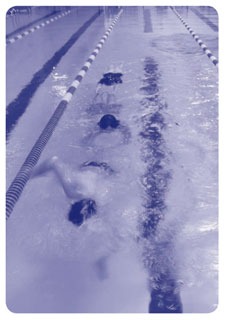 Three swimmers are in one lane in the pool. The first swimmer moves his arms as if swimming front crawl. The second swimmer holds the first swimmer's feet and the third swimmer holds the second swimmer's feet. The third swimmer kicks her legs.
Three swimmers are in one lane in the pool. The first swimmer moves his arms as if swimming front crawl. The second swimmer holds the first swimmer's feet and the third swimmer holds the second swimmer's feet. The third swimmer kicks her legs.
Adaptations
- Use a tapper to notify the lead swimmer when the end of the pool is near.
- Swim for a designated amount of time. Continue switching off the lead swimmer (cycling through each swimmer several times) until the time is up. The team with the greatest number of lengths completed wins.
- Each swimmer uses a pull buoy.
Innovator
Tristan Pierce
American Printing House for the Blind
| GAME |
Poison Ball Category: Elementary School |
Goal
To develop and refine fundamental motor patterns and skills, practice balance and agility tasks, and improve cardiorespiratory endurance
Objective
Students move away in different ways from the sound of a bouncing ball.
Equipment
Playground ball or cage ball
Setup
Students scatter around the gym.
Description
The instructor or student bounces the playground or cage ball around the gym and tries to touch students with his or her hand. The students move away from the sound of the ball and try not to be touched by the person with the ball. Students touched by this person have several options: They may accumulate points, do a specific number of exercises before again participating, "freeze" until freed by an untagged player (yelling "help" to attract an untagged player), etc.
Adaptations
- If the student with the ball cannot see the other pupils, have the students clap hands, call out his or her name, shake bells, etc.
- Have students employ various movements within their ability: scoot on scooter board, jump, walk, run, push wheelchair, etc.
- Have a student(s) be the "tagger."
- The instructor or student can wear a beeper instead of bouncing the ball, and move around the room trying to tag the players.
- Students who are totally blind or who have limited mobility can be paired with a peer partner.
- Provide assistance to students who are deafblind and with multiple disabilities so they can safely move around the gym, perform designated tasks (or substituted tasks) after being tagged, understand rules of the game, and so forth.
Innovator
Linda Gingery (retired)
Michigan School for the Blind
| GAME |
Poker Chip Pick Up Category: Elementary/Middle/High School |
Goal
To improve strength
Objective
Students utilize upper body strength to raise and lower parachute then locate objects on the floor using appropriate searching techniques.
Equipment
Parachute, poker chips, paper cups
Setup
Students stand in a circle, holding the edge of the parachute with both hands.
Description
Students raise and lower the parachute on command—for example, "Up 1-2-3, down 1-2-3." Poker chips are then placed in the parachute and students raise and lower the parachute until all poker chips have fallen out of the parachute. Students are then given a paper cup to collect the fallen poker chips.
Adaptations
- Students work as partners to locate the chips.
- Divide the class into teams.
- Use other objects such as beanbags, coins, peanuts, shells, etc.
- Staff or volunteers assist students who have physical disabilities or who are deafblind to manipulate the chute, collect chips, communicate directions, etc.
- Blindfold some of the sighted students.
- Do the same activity in the pool with quarters.
Innovator
Linda Gingery (retired)
Michigan School for the Blind
| GAME |
Pool Activities Category: Aquatics |
Goal
To improve water adjustment skills, agility, balance, cardiorespiratory and muscular endurance, and fundamental motor patterns and skills
Objective
Students walk, jump, skip, run, hop, or gallop the width of the pool in chest-deep water.
Setup
Swimming pool shallow enough for the students to stand comfortably in chest-deep water
Description
Students enter the pool in chest-deep water. The teacher tells the student the locomotor skill to use while crossing the pool. The student performs the skill. If the student has difficulty with the skill, the teacher may manually manipulate the student or model the skill to reinforce the motion. Once the student has performed the chosen skill, he or she may have an easier time transferring it to land. If the skill is performed in the pool, yet is difficult on land, the student needs to continue working on the skill in the pool until he or she can successfully perform the skill on land. Students may work in partners for help with balance and cooperation.
Adaptations
- When students have mastered a skill, have relay races of either one width or two of the chosen skill.
- If a student is having a hard time with one skill, break down the skill, teach each sub-skill separately, and then integrate the separate sub-skills into the desired skill.
- See how many times students can cross the pool using a different skill each time. Can they add a new skill to their repertoire?
- Play follow the leader in the shallow end, with different skills and different leaders. Suggested commands include: "Can you do it backwards?" "Hop as high as you can!" and "Swing your arms forward!"
- Students with low vision or blindness may need an auditory cue to the side of the pool, especially if they are afraid.
Innovator
Lauren Lieberman
The College at Brockport-SUNY
| GAME |
Pool Parachute Category: Aquatics |
Goal
To improve group cooperation, water adjustment, swimming skills, flexibility, cardiorespiratory endurance, and muscular strength
Objective
Students cooperatively play parachute activities.
Equipment
6-foot parachute
Setup
No setup is required.
Description
Students hold onto the parachute in a circle in the shallow end of the pool. They then walk in circles to the left or right. On the count of three, they pull the parachute under the water and stretch it tightly so that no part of it is near the surface. At this point, the teacher calls a student's name, and that student swims over the parachute to the other side.
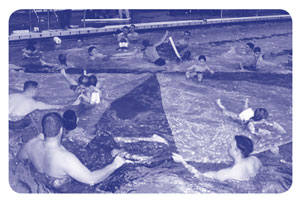 Students and adults are in a pool standing in a giant circle and holding a stretched out parachute under water. A few students are swimming over the top of the parachute.
Students and adults are in a pool standing in a giant circle and holding a stretched out parachute under water. A few students are swimming over the top of the parachute.
Adaptations
- Students who cannot stand in the shallow end should wear a flotation device for the game.
- Students who need help standing may be provided assistance by a volunteer, or may stand against a wall for support.
- Use sponge balls to bounce on the parachute.
- Students who are blind or deafblind should be given descriptions of what is happening with the parachute to increase levels of excitement.
- Students with limited mobility may hold onto the parachute and float around the circle.
- Without lifting the parachute, have students and staff pull the parachute tight. Then the students can sit on top of the parachute while it is being moved around in a circle.
Innovator
Monica Kleeman
Perkins School for the Blind
| GAME |
Relays Category: Elementary School |
Goal
To improve fundamental motor patterns and skills, agility, balance, cardiorespiratory endurance, and strength
Objective
Students perform designated skills.
Equipment
- Cones: color-coded for ease of identification by students who are visually impaired
- Floor tape
- Dowel or broom handle cut into 6" pieces
- Jump ropes
- Hoops
- Scooters: preferably 24 to 30 inches long
- Batons (plastic wrap tubes)
- Tennis balls
- Beanbags
Setup
- Use the width of the gym (frequency of turns is preferable to distance covered).
- Use floor tape to mark the starting line and place cones across the gym as turning points.
- Color-coded cones serve as directional cues for students with some vision; beepers can be used for students who are blind, and cord can be taped to the floor for students who are deafblind.
- Utilize two students per team. Each pair (team) stands on the starting line opposite their cone.
- Tasks are repeated for a designated number of times or for a set time limit.
Description
Examples of locomotor skills
- Run around the cone and back, then tag the partner. (If necessary, substitute a locomotor skill within the student's ability.)
- Run around the cone carrying a baton, and pass the baton to the partner.
- Run to the cone, drop a 6-inch dowel into the hole at the top of the cone, retrieve it from under the cone, and return it to partner.
- Jump rope to the cone and return. (If student is unable to jump rope, he or she may step over the rope as it is turned while moving forward.)
- Walk around the cone and back with a beanbag on the head.
- Run forward carrying a tennis ball and place it on top of the cone; run back and touch the starting line; run again to retrieve the ball before giving it to the partner, who is waiting at the starting point.
Examples of scooter activities
- Push or pull oneself with the hands while prone, or sit on the scooter and pull and push oneself with the legs.
- Partners: One student sits on the scooter board while the other student pushes on the rider's shoulders; the rider needs to steer with his or her feet and/or use the feet as a bumper.
- Partners sit back to back; using their feet, one pushes while the other pulls.
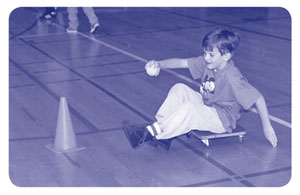 A young boy is sitting on and riding a scooter. He holds a small white ball in one hand and guides himself with his other hand touching the gym floor. He approaches a cone.
A young boy is sitting on and riding a scooter. He holds a small white ball in one hand and guides himself with his other hand touching the gym floor. He approaches a cone.
Adaptations
- A taller cone may be easier to find for students with some sight.
- Directional cues for students who are blind include a beeper at the cone and the partner's voice at the starting line.
- Students who are blind may hear directional cues better when they participate at one end of the gym.
- Use a guidewire to guide students who are blind.
- Assistance can be provided to students with multiple disabilities or who are deafblind to use scooter boards, perform locomotor skills, and so forth.
- The instructor can be creative in the movement skills that he or she asks students to perform.
Innovator
Sue Fleming
Sitka, Alaska
| GAME |
Scatter Stations Category: Recreation |
Goal
To improve agility, balance, flexibility, strength, muscular and cardiorespiratory endurance, and fundamental motor patterns and skills
Objective
Students read or listen to directions and perform various movements and exercises.
Equipment
Laminated cards with directions in large print, braille, and/or pictures; bells or other sound cues
Setup
Place the activity cards at stations around the gym.
Description
The leader begins the activity by reading the designated motor skill and specific exercises noted on station #1's card. This is followed by activating a sound cue at station #1. On hearing the sound, all participants move to the first station by performing the designated motor skill (e.g., walk, crawl, roll, spin, etc.). Once participants locate station #1's card and leader, they execute the specific exercise. After the exercise is completed, another participant reads the movement and exercise for station #2. A sound device is activated for station #2, and all students move to that station using the specific motor skill and perform the noted exercise. This continues until all the cards have been read at least once. Exercise ideas include 10 side leg raises, 10 push-ups, 10 bent knee sit-ups, 10 jumping jacks, 10 arm circles, 10 deep breaths, 10 alternate toe touches, etc.
Adaptations
- Use equipment such as mats, balls, beanbags, scooters, hoops, and jump ropes.
- Additional activity ideas include balancing a beanbag on the head, tossing a beanbag and catching it, doing a forward roll, dribbling 10 times in a row, jumping rope three times without missing, standing on one foot, and twirling the Hula Hoop® for a count of five.
- Participants who are blind may be paired with a peer.
- Vary activities according to the functional level of participants and the goal of the activity.
- Participants can choose to return to an activity after they have completed all stations.
- If there are participants in the group with limited physical abilities, include activities on the cards for them as well. For example, participants in chairs may do arm circles when the other participants are performing jumping jacks, or they can perform wheelchair push-ups while the other participants are performing regular push-ups.
Innovator
Linda Webbert
Baltimore County Public Schools
| GAME |
Scavenger Hunt Category: Aquatics |
Goal
To learn submersion and underwater swimming, improve cardiovascular endurance, flexibility, and muscular strength
Objective
Students submerge, search for, and retrieve specific items.
Equipment
A variety of sinkable objects: cap, dive ring, cup, washcloth, spoon, lock, etc., and a scavenger hunt list (written on chalkboard, brailled on laminated paper, or pictures of objects)
Setup
Pool with depth level appropriate to the swimming ability of participants
Description
Individuals are divided into two teams. Each team is given a different list of items that are submerged across the whole swimming area (lists can be read to participants). Participants must find items on their lists.
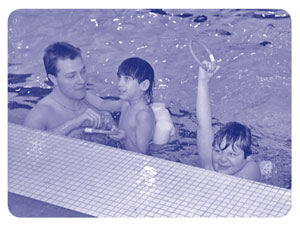 Two boys and their teacher are in the pool next to the wall. Each boy wears a float belt and holds a dive ring.
Two boys and their teacher are in the pool next to the wall. Each boy wears a float belt and holds a dive ring.
Adaptations
- Vary the length of the list.
- Vary the size of items (be sure small items won't go down drains).
- If students are at very different ability levels, make a rule that each student must collect a certain number of items. Allow students to work in pairs if necessary.
- Students who are deaf or deafblind will need to have directions signed to them.
- Include objects that buzz, jingle, ring, etc., where possible for students who are blind. The students may also be partnered with a peer.
- For students with physical disabilities, volunteers or peers may provide assistance as needed in retrieving objects.
Innovator
Sue Grosse
Milwaukee High School of the Arts
| GAME |
Sensational Table Tennis Category: Recreation |
Goal
To improve sport skills (table tennis), flexibility, and muscular endurance
Objective
Participants stand or sit at a table tennis table and hit a balloon back and forth over the net.
Equipment
Table tennis paddles, balloons, table tennis table, string, and bells (optional)
Setup
One or two players play on each side of the table.
Description
Participants play a regular game of table tennis using a balloon. The balloon should be a color that contrasts well with the table and adjacent walls. If the students need more auditory prompts, bells can be put inside the balloon. Regular table tennis rules can be used, or students may count the number of consecutive times they hit the balloon over the net.
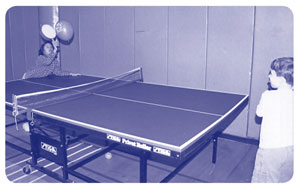 A boy and girl play ping pong. They hit a balloon over the net with their large paddles.
A boy and girl play ping pong. They hit a balloon over the net with their large paddles.
Adaptations
- Students with less muscular control can hit the balloon with a paddle having a larger head, or with their hand.
- Using a string, tie the balloon to the net so students do not need to chase it all around.
- Participants who are higher functioning can use a small beach ball, a small Nerf® ball, a sound adapted table tennis ball (see Appendix D), or a regular table tennis ball.
Innovator
Lauren Lieberman
The College at Brockport-SUNY
| GAME |
Sequential Motor Patterns Category: Elementary/Middle School |
Goal
To develop balance, agility, flexibility, strength, fundamental motor patterns and skills, and cardiorespiratory and muscular endurance
Objective
Students move from station to station achieving their best motoric performance on each obstacle.
Equipment
Large sponge donut, conventional gym mat, decline/incline wedge mat, balance beam, horizontal ladder, large blocks placed like steps, Hula Hoops, an accordion tunnel, and similar objects
Setup
Arrange the following stations in a circle.
Description
Sample stations
- Creep or crawl through the donut.
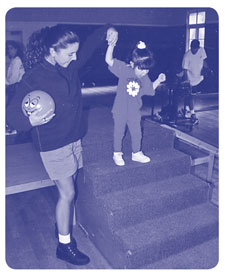 A female teacher holds the hand of a young girl who is walking down a set of stairs.
A female teacher holds the hand of a young girl who is walking down a set of stairs.
- Perform log, forward, or back rolls or animal walks up and down the mat.
- Log roll or forward roll a specific number of times on the mat.
- Start on all fours, then stand up; repeat a specific number of times.
- Step over the rungs of the ladder or walk forward, sideways, or backward on the sides of the ladder.
- With the balance beam positioned on the floor, walk sideways, forward, backward, etc.
- Walk up and down steps or large blocks.
- Walk, jump, or hop from one Hula Hoop® to the other.
- Jump inside the Hula Hoop.
- Finish with appropriate gross motor exercises (i.e., sit-ups, squat thrust, V-sit, static stretches, etc.).
Adaptations
- Familiarize students who are blind or deafblind with the stations before the unit begins.
- Provide physical assistance when necessary to perform skills, change stations, and so on.
- For students who have a hearing loss or are deafblind, communicate desired tasks and directions with sign.
- Have students go through the course for time, emphasizing individual improvement. (Eliminate time if there is a potential for injury or a student performs skills poorly in an attempt to gain time.)
- Students perform the activity or skill within their ability.
- Vary stations to maintain student interest.
- Increase or decrease the number of stations, depending upon the ability level of students.
- Design stations and tasks to challenge each student's skill level. For example, one student may be challenged by crawling through the tunnel forward while another is challenged crawling backward, etc.
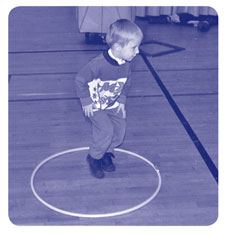 A young boy jumps up and down inside of a Hula Hoop® that is lying on the floor.
A young boy jumps up and down inside of a Hula Hoop® that is lying on the floor.
Innovator
John Schrock
Missouri School for the Blind
| GAME |
Shipwrecked Category: Elementary School |
Goal
To improve flexibility, balance, agility, muscular endurance, and fundamental motor patterns and skills
Objective
Students listen for the captain's (a teacher or student) commands and respond appropriately.
Equipment
Gym
Setup
Students scatter around the gym.
Description
The captain of the ship gives the commands, and the students perform the designated tasks. The game is fast-moving and requires the students to listen and follow directions.
Commands—Tasks
- "Ship's bow" (or stern, port, etc.)—students run forward (for kindergarten students, use "front of ship," "back of ship," etc.).
- "Torpedo"—students place their hands together overhead and run around the gym.
- "Hit the deck"—students lie down flat.
- "Abandon ship"—in pairs, students simulate a rowing motion.
- "Man overboard"—students place a hand over their brow to shade sunshine and look to the right and left.
- "Cook's in the galley"—students get into groups of three or four sitting in a circle.
- "Swab the deck"—students simulate a swaying motion with their arms and body, like mopping.
- "To the crow's nest"—students pretend they are climbing a ladder.
- "Man the pumps"—students get into a push-up position and do push-ups.
- "Bring in the anchor"—students pretend they are pulling in an anchor.
Adaptations
- Use the wall as a guide when moving to the front or back of the ship. Secure tape or a rope to the walls 6 feet from each end to signal the end of the gym or room.
- Use another student (trained peer tutor) or a volunteer as a helper for students who are blind, deafblind, or with physical disabilities to assist in understanding commands and performing tasks (substitute skills). It may be necessary to familiarize students with the commands and movements during the first few sessions.
- Call out "torpedo" when running to spread everyone out, and then give another command.
Innovator
Sue Fleming
Sitka, Alaska
| GAME |
Showdown Category: Recreation |
PowerShowdown, or Showdown as it is known internationally, is a sport specifically designed for and played by people who have visual impairments.
Goal
To improve sport skills (Showdown)
Objective
A player hits the ball under the center bar and into the opponent's goal.
Equipment
- A sound adapted table tennis ball (see Appendix D) or a hollow toy plastic baseball (approximately 2-3⁄4 inches in diameter) containing 5-7 bee bees
- A bat—similar to a small cricket bat (the blade is approximately 3 inches by 10 inches and is attached to a 5-inch handle)
- A table, consisting of a flat playing surface (approximately 4 feet by 12 feet), ringed by a 5-inch frame. Each table corner features a quarter-circle. A small goal box (6 inches by 3 inches) is located at each end of the table.
- A T-bar with a panel which splits the table and rests on the side frames (the panel prevents sighted players from anticipating shots from blind opponents)
- See Appendix D for information to purchase a PowerShowdown table and supplies.
Description
One player begins play by placing the ball in front of his or her bat and hitting it toward the opponent's goal. The served ball must hit the sidewall prior to passing under the center divider. The defender waits for the served ball with his or her bat on the table in front of the goal, with the blade slanted slightly forward (to direct the ball to the table surface). On returning the ball, the defender may use a push shot (pushing the ball), wrist shot (flicking the wrist), slap shot (hitting the ball from a few inches back), handle shot (the ball hits the handle), and so forth. Following the return, the player again places the bat in front of the goal in preparation to block and return the next shot. Play continues until a point is scored or the game is won by one of the players.
Selected Game Rules
Taken from International Blind Sports Federation (IBSA) Showdown Rulebook 2005-2009
- The game is played with two or four players.
- The first team to reach 11 points and be ahead by a minimum of 2 points wins the game.
- A match consists of the best two out of three games.
- The player who begins the game serves five times consecutively, then relinquishes service to the opponent.
- The ball must pass under the center divider to be considered in play.
- The bat must be held in only one hand.
- Scoring: Two points are awarded for a goal. In addition, your opponent gets a point if any of the following occur: the ball is hit off your side of the table, the ball hits the screen, or the ball is touched with any part of your body other than the bat or batting hand up to and including your wrist.
Adaptations
- Participants who have difficulty tracking the ball may be provided verbal prompts and/or physical assistance.
- Participants who have trouble hitting the ball may be given physical assistance based on level of need.
- Participants who are deaf with some sight can use their vision to play the game.
- For further information and complete rules, see http://www.ibsa.es/eng/deportes/showdown/ presentacion.htm
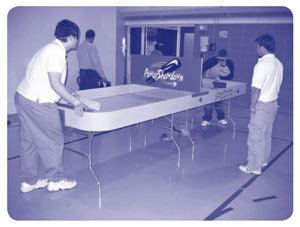 Two boys wear blindfolds and hold paddles. They pass the ball back and forth under the center divider. A third boy watches.
Two boys wear blindfolds and hold paddles. They pass the ball back and forth under the center divider. A third boy watches.
Innovator
Contributed by Jim Cowart (retired)
California School for the Blind
| GAME |
Sockley Category: Elementary/Middle School |
Goal
To improve object control skills, sport skills, agility, and cardiorespiratory and muscular endurance
Objective
Students use a chosen manipulative skill to propel a ball or balloon.
Equipment
- Balloon, punchball, or a ball on a string
- Long, strong, smooth rope
- Volleyball standards
- A small pulley or paper clip
- Two flags
Setup
A long rope is placed across the gym and tied to hooks on each end of the wall or secured to two volleyball standards. The balloon, punchball, or ball on a string is suspended from the rope with either a pulley, carabiner, or large paper clip. This attachment allows the object on the string to slide freely when hit. Flags are attached to the rope at an equal distance from the center for goal markers.
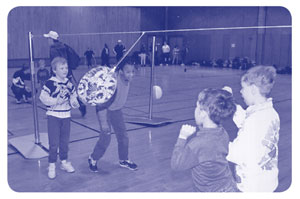 Two children stand on one side of a suspended wire and two other children stand on the other side. An inflated ball is tied to the wire with a rope. The ball is swinging to one side.
Two children stand on one side of a suspended wire and two other children stand on the other side. An inflated ball is tied to the wire with a rope. The ball is swinging to one side.
Description
The students line up along the long string. Two teams are organized, with one, two, or three players on each team. Students in chairs can play against their ambulatory peers. The students hit the ball with the predetermined manipulative skill such as underhand hit, sidearm strike, or kick, and try to get it past the other team members and hit the flag. The ball may be raised or lowered to facilitate the chosen manipulative skill.
Adaptations
- Put bells in the balloon or punchball for students with some hearing.
- Use this game as a lead-up game for soccer by lowering the ball so the students have to play with a kick. Lead up for volleyball by raising the ball high. Lead up for racquet skills by positioning the ball medium height.
- Vary the distance of the students or the distance of the flags.
- Change the roles of the students; encourage passing the ball.
- Have a rule that students must use one hand, two hands, or only the dominant foot, and so on.
Innovator
Lauren Lieberman
The College at Brockport-SUNY
Adapted from the game of Sockley in:
Marsallo, M., & Vacante, D. (1983). Adapted games and motor activities for children. Annandale, VA: Marsallo/Vacante.
| GAME |
Sponge Partners Category: Aquatics |
Goal
To improve water adjustment skills, cooperation, and socialization
Objective
Students take a sponge with a specific shape and find a partner who has the same sponge.
Equipment
One sponge for each student (two of each kind of sponge—e.g., two round sponges, two square, two large, two small)
Setup
Students stand in a circle in the pool's shallow end.
Description
Students put their hands behind their backs, and the instructor places a sponge in each person's hands. On "Go" the students feel the shape of their sponges, then move around the pool and try to find the student who has the same shaped sponge. They cannot talk, but they can bring their sponges out from behind their backs. When a student finds his or her partner, they move as fast as they can together to the wall. The goal is to be the first pair to find their sponge partner and reach the wall.
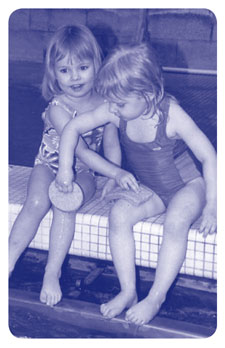 Two young girls sit on the pool's edge and wipe each other's legs with sponges.
Two young girls sit on the pool's edge and wipe each other's legs with sponges.
Adaptations
- Have all students keep the sponges behind their backs for the entire game.
- Instead of sponges, use objects of different textures.
- Students who cannot move independently in the shallow end may wear a flotation device or receive assistance from an aide or volunteer.
- In addition to using the sense of touch to locate similar objects, students who are able may use their voices to describe the object.
- Students who are deaf or deafblind will need to communicate using sign language.
- Once students find a partner with a sponge of the same shape or color, they may participate in "body painting."
Innovator
Monica Kleeman
Perkins School for the Blind
| GAME |
Stations Category: Elementary School |
Goal
To improve balance, agility, fundamental motor patterns and skills, and sport skills
Objective
Students go from station to station performing the predetermined skill and/or activity to their best ability.
Equipment
(specific to the station chosen—see below.)
Digital kitchen timer—to remind teacher and students when to rotate stations
Setup
Listed below are a variety of items from which to choose:
- Hula Hoops—free play
- Bowling—1-10 pins (mark spots on floor), a 10-inch playground ball, and balance beams or two-by-fours on the floor to separate lanes
- Hoops suspended from the ceiling or an overhead ladder, with a bell or milk jug (with unpopped corn kernels inside) attached to the hoop to give feedback regarding the success of a thrown ball; use light 10-inch slow motion (Slo-Mo®) balls or Nerf® balls for throwing. See Appendix D.
- Basketball hoop attached to a wall or pole (height depends on ability level of the student); use mini basketballs, playground balls, etc.
- Scooter board obstacle course—use folded mats, cones, tunnels, chairs, etc., as obstacles. (For example, two chairs with plastic or bamboo sticks across the seats or a low table can be used as a tunnel.)
- Jump ropes—have a variety of tasks to challenge students' abilities, from simply jumping over a rope on the floor to independently using a jump rope. For jump ropes, see Appendix D.
- Beanbag toss—have milk crates or hoops on the floor or wall.
- Chin bar—chin-ups, hang for time, etc.
Description
Students are shown or demonstrated the expected skill to perform at each station. They are then assigned a place to begin. Stations are numbered or color-coded. When it is time to change stations, one approach may be to say, "Stop, put your equipment away. Red (students) go to blue (station), blue go to yellow," and so on.
Adaptations
- Gradually increase the length and complexity of the course depending on the
students' abilities.
- It may be necessary to familiarize students who are blind or deafblind with the various stations or skills prior to the class. In this way, there will be less delay in starting the activity.
- Place beepers on targets for directional cues.
- Have a teacher, aide, or trained peer tutor assist in aligning the pupils for throws, retrieving balls or equipment, performing skills, and moving to stations.
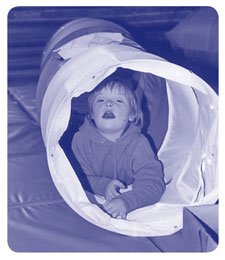 A young child looks out from the inside of a play tunnel.
A young child looks out from the inside of a play tunnel.
- Use the appropriate level of instruction to teach the skills.
- Have a student perform an activity or skill within his or her ability if the designated skill is inappropriate.
- Challenge the students to improve on each activity as they go through the unit.
Innovator
Sue Fleming
Sitka, Alaska
| GAME |
Steal the Bacon Category: Elementary/Middle School |
Goal
To improve fundamental motor patterns and skills, sport skills, agility, and balance
Objective
Students play a team game utilizing their listening skills, locomotor skills, and speed.
Equipment
Mats, a bell, and a gym
Setup
Place large mats end to end in the middle of the gym or room. Position members of each team a predetermined distance from the mats. They sit or stand on poly spots or in Hula Hoops to designate their spots.
Description
Assign each member of one team a number, animal, car, or like object. Do the same with the other team, so that players from each team have corresponding numbers or names. The instructor or volunteer stands in the middle of the mat with a bell. The instructor designates movement skills for students to use, then calls out a number(s), car(s), animal(s), or the like and rings the bell. The players with that number, car, animal, etc., move forward and attempt to touch the mat before their opponent does. The play continues until the teacher stops the competition.
Adaptations
- Match opposing players of similar ability.
- Students can perform different locomotor skills to get to the mat: scoot, crawl, crab walk, jump, hop, skip, gallop, and so on.
- Blindfold sighted, or partially sighted students.
- Play the game using carts, scooters, wheelchairs, or the like.
- Provide assistance to those students who need interpreting, help to move, etc.
Innovator
Linda Gingery (retired)
Michigan School for the Blind
| GAME |
Success-Oriented Horseshoes Category: Recreation |
Goal
To improve sport skills (horseshoes) and muscular strength
Objective
Participants play the game of horseshoes and experience success no matter what the physical limitation. (This game promotes success because more stakes are used and because the stakes are longer and thicker, so the student is more likely to hit the stake or get a ringer!)
Equipment
20 stakes 2 feet long and at least 1 inch thick (ask the woodworking teacher, or buy inexpensive ones at a hardware store) and 6-10 plastic horseshoes
Setup
Set up the stakes outside in the grass, in an arrangement that will promote success for the participants. For participants with less ability, set up several stakes and place them one horseshoe width apart. For participants with a higher ability, set up fewer stakes, farther apart. If the class includes participants of various abilities, set all the stakes close together, and have the more experienced participants stand farther back. Use either of the stake formations noted below in the diagram. Also change the setup so participants have to vary their shots.
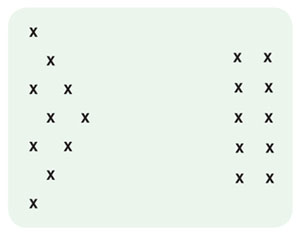 One side has ten Xs staggered with one X in the first row, two Xs in the second row, three Xs in the third row, and four Xs in the fourth row. The other side has ten Xs lined up in two rows, five in each row.
One side has ten Xs staggered with one X in the first row, two Xs in the second row, three Xs in the third row, and four Xs in the fourth row. The other side has ten Xs lined up in two rows, five in each row.
Description
Participants play a game of horseshoes with two to four horseshoes each. Scoring could be 5 points if the horseshoe is touching the stake, 10 points if it is leaning on the stake, and 20 points for a ringer. Allow participants to keep their own scores when possible. Participants in wheelchairs may throw from closer distances such as 2-10 feet away. Participants who are totally blind may walk the distance of the course, feel the formation of the stakes, and have a peer guide to point them in the right direction when they throw.
Adaptations
- Tap the stakes for a directional cue for participants who are totally blind.
- Have tournaments against classmates and staff.
- Play indoors with small, thin cones, or stakes that screw into a wooden stand.
- Use larger horseshoes for even more success!
- Color-code the stakes for more complicated scoring. Also make scoring areas in the grass surrounding the stakes so participants have a better chance to get points with every throw.
Innovator
Lauren Lieberman
The College at Brockport-SUNY
| GAME |
Tactile T-Ball (Lead-Up Game) Category: Middle School |
Goal
To improve sport skills (baseball) and develop an understanding of the games of baseball and kickball
Objective
Students hit a ball off a cone and run the bases independently.
Equipment
Four tall cones, a long rope, a playground ball, and a bat
Setup
Set up the cones in the shape of a baseball diamond. Wrap or tape rope around each cone in order to connect all the bases. Have two playing areas if sufficient staff or volunteers are available to help supervise.
Description
Put the ball on the home plate cone. A student hits the ball off the cone (or hits a pitched ball), then runs around all the bases with or without trailing the rope. Have a different-textured surface on home plate so students who are blind know when they have reached home. Fielders retrieve the ball and return it to home plate. After batting, the student rotates to the field, and one of the fielders becomes a batter.
Adaptations
- Students with sight can be guide runners for students who are blind.
- To make the guide rope easier to trail for taller students, raise the cones by placing them on a crate or box.
- Use a beeper ball for students who are blind.
- Use larger or smaller balls for different ability levels of students.
- To accommodate individual student needs, use different types of bats, such as a flat bat, large pillow polo bat, or Wiffle® ball bat.
- Have an aide, volunteer, or peer tutor assist students who are deafblind or who have multiple disabilities to bat, run bases, or retrieve the ball.
Innovator
Monica Kleeman
Perkins School for the Blind
| GAME |
Tactile Twister Category: Recreation |
Goal
To improve flexibility, muscular strength, balance, and muscular endurance
Objective
Participants play the game of Twister® with tactile cues.
Equipment
One large bedsheet (preferably full, queen, or king size), flexible glue, glitter, cutout shapes (preferably familiar shapes), and an 8 inch × 8 inch piece of cardboard for the spinner
Setup
Trace the shapes with a pencil in rows onto the sheet. Cover the traced outline of the shapes with flexible glue, then cover the glue with glitter. Use a different color of glitter for each shape. Spread the sheet out, and secure the corners with a cone, Velcro®, or a staff person. Two to five participants can play at the same time while one student serves as the spinner. The spinner can be made by cutting an arrow out of cardboard and securing it to the middle of the spinner board with a long pushpin or tack. (Be sure to protect the back with cork or tape.) Draw a vertical line and a horizontal line through the middle of the spinner board to separate the board into quadrants. Draw a body part in each quadrant: left hand in top left quadrant, right hand in top right quadrant, left foot in bottom left quadrant, and right foot in bottom right quadrant. Then draw all four shapes in each quadrant. If the spinner stops on the top right quadrant, the call would be "right hand" and the name of the shape in which the arrow is pointing. Braille the name of the shapes and body parts under each one for children who are blind.
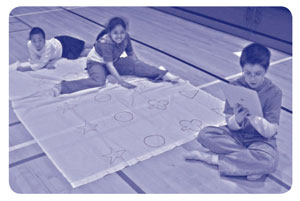 One child sits on the floor and spins the tactile spinner. Two other children play on the Twister mat.
One child sits on the floor and spins the tactile spinner. Two other children play on the Twister mat.
Description
The student who is the spinner spins the dial and calls out the commands. For example, "Right foot on the square, and left hand on the triangle" or "Left foot on the star, and right hand on the circle." Allow the participants to continue for a set number of spins or for a set time.
Adaptations
- Instead of using glitter, the instructor may sew different shapes of various colors, textures, and materials onto the sheet in rows. Material such as corduroy, silk, velvet, or polyester can be used.
- Braille the spinner for participants who are blind.
- Use object cues in the spinner for non readers.
- Sign commands to participants who are hard of hearing or deaf.
- Use physical guidance for participants who have limited tactile ability.
- Participants who are very physically disabled can play in their chairs. Make a special Tactile Twister sheet for them, and hang it over a table or chair. Make all the shapes closer together and in one place, so that participants with limited range of motion can touch all the shapes from their chairs.
- The instructor can also be the spinner for participants who cannot spin for themselves.
Innovator
Lauren Lieberman
The College at Brockport-SUNY
| GAME |
T-Ball Category: Elementary/Middle School |
Goal
To improve sport skills (baseball)
Objective
Students score points by hitting a ball off a T-stand and running the bases.
Equipment
T-stand, Wiffle® ball, and Wiffle bat. You may put bells in the Wiffle balls.
Setup
Play on softball/baseball diamond with a T-stand on home plate. Blindfold sighted or partially sighted students. The playing field is divided into four areas, each representing either a single, double, triple, or home run.
Description
Each student adjusts the T-stand to the desired height, then assumes an appropriate batting stance. The student is allowed three swings to hit the ball. A single, double, triple, or home run is earned if the student hits that ball in the corresponding area of the playing field. After hitting the ball, the student runs the designated number of bases to develop an awareness of the relationship of the four bases to the respective hit. A defensive player retrieves the ball and returns it to home plate for the next batter's turn. The batting and fielding teams change positions when all students have batted.
Adaptations
- Keep the number of students and teams small to allow for more participation.
- Use a beeper ball for students who are blind.
- Adjust the size of the softball or baseball diamond to fit the ability level of the students.
- Use a time limit instead of a certain number of innings.
- Call the batter out when a fielder stops a rolling audible ball or when the fielders perform some type of cooperative drill before the runner reaches the base. For example, after fielding the ball, the defending team might be required to form a line and pass the ball from one end to the other, alternating over the head with between the legs.
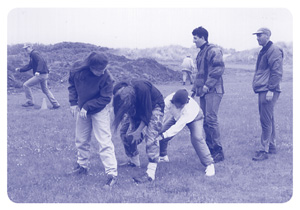 Five young adults are lined up in a field. The second person passes a ball to the third person between her legs.
Five young adults are lined up in a field. The second person passes a ball to the third person between her legs.
- Assign a sighted person, such as a peer tutor, to run the bases with a student who is blind.
- A staff member, volunteer, or peer tutor can
assist students who are deafblind or have multiple disabilities to locate and place the ball on the T-stand, help the students swing the bat, locate a ball in the field, and so forth.
Innovator
John Schrock
Missouri School for the Blind
| GAME |
Team Cone Croquet Category: Recreation |
Goal
To improve sport skills (croquet)
Objective
Participants learn croquet skills as well as team play.
Equipment
A croquet set, large cone markers, and cut Hula Hoops
Setup
The game is set up like the game of croquet. The two ends of the cut Hula Hoops are placed in the top of each pair of cone markers to form giant wickets/arches.
Description
Participants work as a team and must alternate hits. They start at an end stake and hit the croquet ball toward two cones set up side by side with a small space between them. Participants who are blind may use the side of the mallet instead of the end, providing a larger area with which to hit. Partners may tap on the cones or clap to direct the hits for participants who are blind. Participants may also want to feel the ball, then walk to the cone to understand the distance between the two. There can be as many as four participants on a team, utilizing one croquet mallet and ball per team. The teams as well as players within the teams take turns. Regular croquet rules apply if another person's ball is hit. Arrange the cones in any pattern that you wish. The setup can be simplified to reduce playing time. The first team to get back to the end stake (or cone) is the winner. Other options include competition or the use of scorecards to note the number of hits it takes to complete the course.
Adaptations
- Use large orange field marker cones.
- It may help to spray the croquet balls a brighter color.
- A larger ball such as a playground ball or volleyball may be used to increase success.
- Participants who are blind or deafblind may need sign or verbal cues to direct them to their ball or the opponent's ball.
- Participants with limited physical ability may need assistance to hold the mallet, hit the ball, etc.
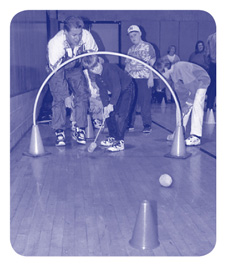 Two cones are set up about 3 feet apart. A Hula Hoop® is cut and the ends placed in the top of each cone to make a giant wicket. A student hits a ball with a mallet through the giant wicket. The teacher stands next to the student.
Two cones are set up about 3 feet apart. A Hula Hoop® is cut and the ends placed in the top of each cone to make a giant wicket. A student hits a ball with a mallet through the giant wicket. The teacher stands next to the student.
Innovator
Candace Rehmeier
Nebraska Center for the Education of Children who are Blind or Visually Impaired
| GAME |
10 Shot Category: Middle/High School |
Goal
To improve sport skills (basketball)
Objective
Students execute foul shots using a two-handed underhand shot, one-handed, or two-handed set shot.
Equipment
Have available mats, basketballs, baskets, and backboards with sound. Use a doorbell; the APH Portable Sound Source, Sport Edition; a pop can with quarters or rocks inside attached to a rope, or use a child's cane to tap the rim of the basket for an auditory cue.
Setup
Place the mats in front of the baskets. A short end of each mat is on the foul line or closer.
Description
A student faces the basketball hoop with heels against the front edge of the mat. He or she shoots a series of 10 consecutive shots; each student keeps track of his or her score, utilizing the following scoring system:
- One point if ball hits the backboard
- Two points if ball hits the rim
- Three points if ball goes in basket
Students challenge themselves by attempting to exceed their previous best score.
Adaptations
- Use a lighter ball (playground ball, volleyball, etc.) for younger students if necessary.
- Play in teams. If a team is short of players, staff can be blindfolded and participate on that team.
- Move students closer to the basket or farther away depending upon ability.
- Have available adjustable baskets that can be lowered for pupils unable to reach a standard basketball hoop.
- Provide assistance as needed to students who have multiple disabilities or are deafblind in order for them to successfully execute foul shots, keep score, etc.
- Use trained peer tutors to give auditory feedback about the previous shot if it was too short, or left or right of the basket.
Innovator
Linda Gingery (retired) contributed the game, though the true innovator is unknown.
Michigan School for the Blind
| GAME |
Throw and Search Category: Elementary/Middle School |
Goal
To improve fundamental motor patterns and skills and sport skills
Objective
Students throw beanbags at a target using the one-handed underhand throw.
Equipment
Mat, beanbags; target objects such as pie tins, bells, wind chimes, or tin cans
Setup
Hang target objects from old venetian blinds, overhead ladders, stall bars, etc. Place a mat 5-10 feet from the hanging objects.
Description
Students square their heels to the mat for alignment. Give each student 10 beanbags; students throw the beanbags at the hanging objects, using the underhand throw. The beanbags hitting the objects will give auditory feedback. After all students have taken their turn, students locate the beanbags by sweeping their hands slowly across the floor under the target objects. When all bags have been collected, repeat the activity.
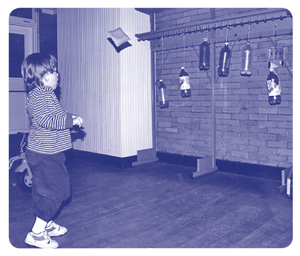 A young girl stands a short distance in front of a line of plastic soda bottles that are suspended from a wall-mounted coat rack. She throws a beanbag at the bottles.
A young girl stands a short distance in front of a line of plastic soda bottles that are suspended from a wall-mounted coat rack. She throws a beanbag at the bottles.
Adaptations
- Decrease or increase the distance between the mat and the objects.
- Arrange targets from low to high.
- Vary the throw: two-handed underhand throw, chest pass, bounce pass, etc.
- Attach a flashlight to the target to provide a directional cue for students with low vision.
- For students who are deafblind, use sign language to communicate rules and successes.
- Provide physical assistance as needed for students having difficulty executing a throw—for example, by modifying the throwing pattern.
Innovator
Linda Gingery (retired)
Michigan School for the Blind
| GAME |
Underwater Tag Category: Aquatics |
Goal
To improve submersion adjustment, breath control, swimming skill, speed, and cardiovascular and muscular endurance
Objective
Students voluntarily submerge completely, holding their breath and blowing bubbles.
Equipment
None
Setup
Pool with depth level appropriate to swimming ability of participants
Description
One person is "it." All others try to avoid being tagged by "it" and thus becoming "it" by ducking underwater when "it" comes close to them. A person cannot be tagged by "it" if he or she ducks underwater before being tagged.
Adaptations
- A player who ducks underwater but comes right back up can be tagged. "It" counts to five, and if the person does not come up, "it" must move on to try to catch another.
- Make the bottom of the pool "safe." Participants who are touching the bottom with a hand cannot be tagged.
- Change the rules for students who have limited breath control abilities—for example, submerge to mouth, nose, or eyes.
- "It" can ring a bell to alert other players of his or her location. In turn, the others can be required to regularly call "it's" name in order to keep "it" aware of their locations.
Innovator
Sue Grosse
Milwaukee High School of the Arts
| GAME |
Whacky Yoga Warriors Category: Elementary/Middle School |
Goal
To improve flexibility, balance, and strength
Objective
Students hold different yoga poses that resemble those of a strong and powerful warrior. Each pose will be individually modified to meet the needs of each person.
Equipment
Soft surface (yoga mats, folding gym mats, wrestling mats, carpeted surface, carpet squares)
Setup
Set up the space so that each student has enough room to move freely without getting into another student's personal space.
Description
Students follow the instructor as she/he describes different yoga poses that relate to a warrior.
- Warrior I - From a standing position, step back with your left foot. Turn your left foot so that the toes are pointing slightly outward and your heel is flat on the floor. Your right toes should face straight forward. Begin to bend your right knee so that your leg comes into a 90-degree angle. Make sure your knee is directly over your ankle. Sink your hips towards the floor keeping your left knee straight. Draw your hands over head with your palms facing inward. Glance up to the sky and hold this pose for 5 seconds. Repeat on other side. Variation: Student places the back knee on the floor to help with balance.
- Warrior II - From Warrior I pose, rotate your torso 90 degrees towards the back leg. Draw your arms straight out to the sides so that they are parallel to the floor. Make sure your front knee is bent towards the 90-degree angle and your back knee is straight. Relax your shoulders and glance over your front arm's fingertips and hold for 5 seconds then repeat on other side. Variation: Student places the back knee on the floor. If the arms begin to tire, individuals can place their hands on their hips.
- Reverse Warrior - From Warrior II pose, place your back hand onto your back thigh. Draw your front arm up towards the sky. As you draw your arm toward the sky, this allows your back to slightly arch. Raise your glance up to the sky. Remember to keep your front knee bent and back leg straight. Try not to place any pressure from your hand onto your back leg. After holding the pose for 5 seconds, slowly draw your spine back into a straight position and repeat on other side. Variations: 1) Student places the back knee on the ground. 2) Student may hold the pose in a straight spine position.
- Twisted Warrior - From Warrior II pose, place your back knee on the ground with your front knee in a 90-degree angle. Press your palms together in front of your chest, like praying. Twisting from your torso, place your left elbow onto your right thigh and draw your right elbow towards the sky. Glance to the sky and hold for 5 seconds; repeat on other side. Variation: Student keeps back knee off the ground with a straight leg (more challenging).
- Warrior III - From Warrior I pose, individuals shift their weight onto their front leg drawing their hip over their ankle and drawing their back leg off the ground. The individual should try to draw the back leg high enough to be parallel to the ground. Arms draw out in front of the individual with palms facing inward. Eyes glance forward finding something to spot to help with balance. Hold for 5 seconds then repeat on other side. Variations: 1) Student keeps his/her toes on the ground until he/she feels more securely balanced, then he/she gradually lifts the leg higher and higher until in full pose position. 2) Students place their hands on the floor for support with their leg off the floor. 3) Students place their hands on a block, an aerobic step, or a wall for support with their leg off the floor.
Transitioning from one pose to another
After each pose, place the hands on the floor on each side of the front foot. Draw the front foot back to meet the back foot. Push your bottom up to the sky while you push through your shoulders, straightening your elbows and relaxing your head between your arms. Knees have a slight bend in them as you try to draw your heels to the floor. When you transition back into a Warrior pose, step a foot between your hands and raise into the next pose.
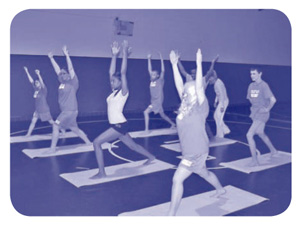 A group of teens in a physical education class practices the Warrior I pose.
A group of teens in a physical education class practices the Warrior I pose.
Adaptations
- Use tactile pose cards.
- Physical guidance from instructor with verbal instructions
- Tactile modeling by instructor
- Use interpreters for individuals with deafblindness.
- Use peer tutors who work 1:1 with student(s).
Innovator
Haley Schedlin
West Irondequoit School District
| GAME |
Water Baseball Category: Aquatics |
Goal
To improve the sidearm strike, water running, underwater swimming, game skills, and muscular and cardiorespiratory endurance
Objective
A student on offense (batter) sidearm strikes a ball and swims underwater to a predetermined spot before returning to home base. At the same time, a student on defense locates the ball and tries to swim with it to home base and back to the defensive wall before the batter reaches home.
Equipment
One or two cones, a beach ball containing bells, and two spoons
Setup
The following diagram shows the Setup.
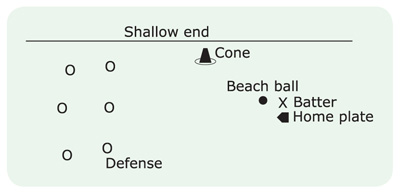 The illustration shows that all players and equipment are in the water. At the shallow end of the pool there are six defense players standing in two rows of three with their backs to the length (long side) of the pool; their left arms are to the shallow end wall. The batter stands at home plate, facing the defense players and with his back to the opposite long side of the pool as the defense players. The defense players and the batter face each other. In the center, next to the shallow end wall, a cone floats; it is the same distance from the batter as it is from the defense players. A beach ball is in front of the batter.
The illustration shows that all players and equipment are in the water. At the shallow end of the pool there are six defense players standing in two rows of three with their backs to the length (long side) of the pool; their left arms are to the shallow end wall. The batter stands at home plate, facing the defense players and with his back to the opposite long side of the pool as the defense players. The defense players and the batter face each other. In the center, next to the shallow end wall, a cone floats; it is the same distance from the batter as it is from the defense players. A beach ball is in front of the batter.
Description
One player strikes a beach ball containing bells from one side of the pool to the other, where the defense waits. The striker then swims underwater to the other side (or to a cone underwater where a guide is striking two spoons together) and then back home. The defense player who retrieves the ball swims with it to home plate and then back to the defensive wall. If the base runner gets back to home plate before the defender reaches the defensive wall, he or she earns a point for his or her team. Rotate defensive positioning if one player dominates, or make a rule that a defensive player cannot touch the ball twice in a row. Members of the defensive team should help with orientation by calling their teammate's name. A helper with spoons should orient the base runner (i.e., hitter) toward home plate. Each member of the offense gets a turn before switching sides.
Adaptations
- Nonswimmers can run, or paddle with a flotation device, to the sound of spoons or clapping.
- Individuals with multiple disabilities may use helpers for guidance or for support on offense and defense.
- In order to include all defensive players, change the rules so that rather than a single defensive player having to swim across the pool and back, the ball must be passed around the entire defense team; each person receiving the ball must perform a predetermined task (e.g., jump five times, bob three times, float on his or her back for 5 seconds) before passing it on to the next person. The last player to receive the ball gives it back to the player who originally got the ball from offense, and the ball is considered to be home at that point.
- To keep interest high, have a sighted announcer give play-by-play descriptions of the game for all the students.
Innovator
Monica Lepore
West Chester University
| GAME |
Water Soccer Category: Aquatics |
Goal
To improve kicking skills, arm strokes, teamwork, and muscular and cardiorespiratory endurance
Objective
Students kick a ball hard enough to make the ball pass the other team's line of players and score. All students may participate in this game.
Equipment
A playground ball or beach ball
Setup
Students form two lines in the pool facing each other 8-10 feet apart. The ball is placed in the center of the two lines. The line formation may be in the shallow or deep end depending upon the skill level, endurance, and confidence of the students.
Description
Students float prone or supine. On the signal "Go," the students kick as hard as they can and try to make the ball go past the other team. One point is scored each time the ball passes the other team. Where necessary, students may use a flotation device or physical assistance for the game.
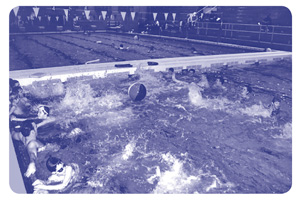 The photo shows two rows of swimmers with a beach ball in between them. The swimmers splash the water to make big waves that move the ball.
The photo shows two rows of swimmers with a beach ball in between them. The swimmers splash the water to make big waves that move the ball.
Adaptations
- The same game can be played on land in the gym. The ball must stay on the ground, and points are scored in the same manner. This is a big hit with elementary students!
- The same game may be played prone using arm strokes.
- The game can be played one-on-one.
- The instructor may describe the position of the ball to increase awareness and excitement for students who are blind.
- The instructor may use more than one ball.
Innovator
Lauren Lieberman
The College at Brockport-SUNY
| GAME |
The Weather Game Category: Aquatics |
Goal
To improve water orientation, breath control, distinguishing weather, socialization, listening, and following directions
Objective
Students follow commands to perform various skills in an aquatics setting.
Equipment
None
Setup
Students are spread out in the shallow end of the pool either in a circle or scattered so there is enough space between them to move freely.
Description
Either the teacher or one of the students is the "weatherperson," who gives students the following commands to perform:
Adaptations
- Students make up their own weather conditions.
- Students who are deafblind will need someone to explain the game, communicate commands, and so forth.
- Let students use their imagination when acting out weather.
- Change the "weatherperson" frequently.
- Provide assistance to students who have difficulty demonstrating movements.
Innovator
Linda Webbert
Baltimore County Public Schools
| GAME |
Your Fitness is in the Cards Category: Elementary/Middle School |
Goal
To increase cardiorespiratory endurance, flexibility, and muscular strength and endurance
Objective
Students read the cards dealt to them at the beginning of the "warm-up" period and correctly execute the corresponding exercises noted on the chart.
Equipment
A deck of cards (regular and braille), a chart (large print and braille) noting the exercise/activity for each card, mats, jump ropes, carpet squares, a climbing rope, and weight equipment
Setup
Set up stations in gym area.
Description
This is a fun warm-up activity. Students receive five playing cards when entering the gym. The students must look at their cards and consult the exercise/activity chart (or have a staff member do it for them) to find out what corresponding exercises or activities they must do and the correct number of repetitions at each station. These stations (and chart) may be changed to reflect the students' skills. Stations may emphasize "fitness" and, for example, have the following activities/ exercises:
- Ace = jog four laps around the gym.
- King = 20 sit-ups.
- Queen = 25 jumping jacks.
- Jack = 10 jumps using a weighted jump rope.
- Joker = the student must pull him or herself on a carpet square two times across the gym floor.
- Hearts numbered 10 and under = the student must jump rope the number on the card multiplied by itself (i.e., eight of hearts = 8 × 8 = 64 jumps).
- Spades numbered 10 and under = the student must perform the same number of repetitions of push-ups as the number on the card.
- Diamonds numbered 10 and under = the student must perform the same number of repetitions of leg lifts on the weight machine as the number on the card.
- Clubs numbered 10 and under = the number of times a student must hang on a climbing rope for 15 counts each time.
Adaptations
- Construct a braille or large-print master chart illustrating the meaning of each playing card.
- Use braille playing cards.
- Use a sighted guide and/or indoor guidewires for students running laps.
- Set up stations in the same area when repeating this warm-up activity.
- Adaptations should be made on the chart for students who have multiple disabilities. (Each station could have three or four options.)
- Provide an interpreter for students who are deaf or deafblind to communicate what exercise or activity is scheduled for the next station and/or the number of repetitions.
- An aide, volunteer, or peer tutor can assist the students who are deafblind to increase their understanding of the movement from station to station, activities, number of repetitions, etc.
Innovator
Candace Rehmeier
Nebraska Center for the Education of Children who are Blind or Visually Impaired
| GAME |
Zone Volleyball Category: Elementary/Middle School |
Goal
To improve sport skills (volleyball) and muscular endurance
Objective
Students serve a volleyball from a predetermined distance into a designated area on the opposite side of the court.
Equipment
Volleyball court, volleyball net, oversized trainer volleyballs, and floor marking tape
Setup
Set up the volleyball net. Mark three or more serving areas as well as three serving lines (see diagram). The distance should reflect students' abilities.
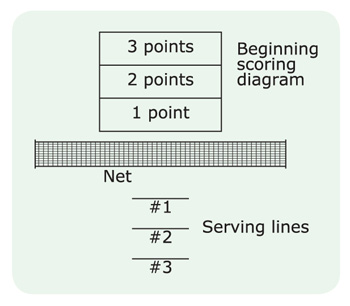 The illustration shows the beginning scoring diagram. A net is positioned horizontally. Below the net are three serving lines. Serving line #1 is closest to the net, #2 is below #1, and #3 is farthest from the net. Above the net is a box divided into three equal horizontal sections; the section closest to the net is marked 1 point, the middle section is marked 2 points, and the section farthest from the net is marked 3 points.
The illustration shows the beginning scoring diagram. A net is positioned horizontally. Below the net are three serving lines. Serving line #1 is closest to the net, #2 is below #1, and #3 is farthest from the net. Above the net is a box divided into three equal horizontal sections; the section closest to the net is marked 1 point, the middle section is marked 2 points, and the section farthest from the net is marked 3 points.
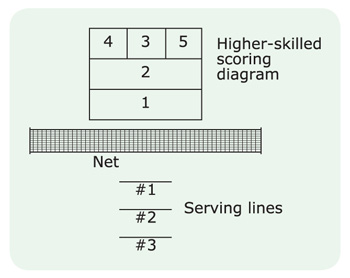 The illustration shows a higher-skilled scoring diagram. A net is positioned horizontally. Below the net are three serving lines. Serving line #1 is closest to the net, #2 is below #1, and #3 is farthest from the net. Above the net is a box divided into three equal horizontal sections; the section closest to the net is marked 1 point and the middle section is marked 2 points. The section farthest from the net is divided into three equal sections; the section on the left is marked 4 points, the middle section is marked 3 points, and the section on the right is marked 5 points.
The illustration shows a higher-skilled scoring diagram. A net is positioned horizontally. Below the net are three serving lines. Serving line #1 is closest to the net, #2 is below #1, and #3 is farthest from the net. Above the net is a box divided into three equal horizontal sections; the section closest to the net is marked 1 point and the middle section is marked 2 points. The section farthest from the net is divided into three equal sections; the section on the left is marked 4 points, the middle section is marked 3 points, and the section on the right is marked 5 points.
Description
In order to make the activity more of a game situation, points are assigned to designated areas of the court (refer to diagram). Students serve from behind any of the three serving lines. Once they select a serving line, five serves must be made from this area. In the next round, they may select a different serving line. Games consist of as many rounds as the class period allows. Tournaments can be conducted and the standings carried over to the next day. Students may compete individually or as members of a team. Students can work on math skills by adding up their points earned each game.
Adaptations
- Make serving lines tactile by taping cord to the floor.
- Students use either bright yellow oversized "trainer" volleyballs or regulation volleyballs. (Students select the size ball they want to use.)
- Use voice or clapping as directional prompts to specific areas for students who are totally blind.
- Various levels of assistance may be incorporated to teach students the serving motion. For example, students who have difficulty executing the skill may be physically assisted through the task; or students able to perform the skill, yet limited in cognitive abilities, may be given a tactile signal (i.e., tap on the elbow to serve).
Innovator
Candace Rehmeier
Nebraska Center for the Education of Children who are Blind or Visually Impaired
Appendix A
Classifications of Blindness and Deafness
Students who are labeled blind, deaf, hard of hearing, visually impaired, and so forth all have a wide range of sensory abilities. In order to determine the appropriate adaptations and teaching strategies, it is important to know the amount of hearing and vision a student possesses. The following two charts will aid in understanding the labels in a student's file.
Classifications of Blindness
Visual handicaps are defined in terms of visual acuity as measured by a Snellen chart. The lines of progressively smaller letters are read by a person sitting or standing at a distance of 20 feet from the chart. Sharpness or clearness of vision is designated as a numerical ratio. One of the following classifications may appear on a student's school record:
20/200—legal blindness. The ability to see at 20 feet what the normal eye can see at 200 feet. This classification makes the student eligible to receive assistance under state and federal programs.
5/200 to 10/200—travel vision. The ability to see at 5 to 10 feet what persons with normal vision see at 200 feet.
3/200 to 5/200—motion perception. The ability to see at 3 to 5 feet what persons with normal vision see at 200 feet. This ability is limited almost entirely to motion.
Less than 3/200—light perception. The ability to distinguish a strong light at a distance of 3 feet from the eye, but inability to detect movement of a hand at the same distance.
Lack of visual perception—total blindness. This is the inability to recognize a strong light that is shown directly into the eye.
Classifications of Deafness
| Degree of Loss |
Loss in Decibels |
Difficulty with |
| Slight |
25-40 |
Whispered speech |
| Mild |
41-54 |
Normal speech at a distance greater than 3-5 feet |
| Marked or moderate |
55-69 |
Understanding loud or shouted speech at close range; group discussion |
| Severe |
70-89 |
Understanding speech at close range, even when amplified |
| Profound |
90+ |
Hearing most sounds, including telephone rings and musical instruments |
Appendix B
Tips for Teaching Students who are Visually Impaired
- Treat the child as part of the class. The same disciplinary rules should apply to everyone. Make exceptions only when necessary, just as you would for any other child.
- Speak naturally when you talk. Don't be afraid to use words that refer to seeing. However, the words "here" and "there" are too general for descriptive use. Be specific, and label objects that give direction and location.
- Gestures are not always enough. In a group setting, call the child by name when you want a response from him or her.
- Use sound to help the child. Your voice leads and directs a visually impaired child within the environment. Get the child's attention before giving instructions. A moving speaker confuses a child. Describe with clear directions and in a normal speaking voice where you are and how the child can reach you.
- Help make the sound environment meaningful for the visually impaired child. Eliminate confusing or conflicting sounds. The sorting of sounds is a difficult skill which takes time, experience, and explanation to develop.
- Explain what is happening around the child. Show from where sounds and smells are coming. As the child explores, describe everything with variety, quality, and richness.
- Orient the child to the classroom and equipment in the gym. Let the child know if you have changed the room around. Independent mobility is important and sometimes difficult for visually impaired children.
- Avoid overprotection. Remember that all children get bumps and scrapes occasionally. Safety is important, but overprotection can be just as detrimental to a child as underprotection.
- Encourage independence. Let the children do as much as possible for themselves.
- Build the child's self-confidence by letting them try. Take the child through an activity or game a couple of times before requiring independent movement. For a sighted child, motor imitation is a visual skill, whereas a visually impaired child needs to experience the activity physically.
- Answer questions simply and naturally. The other children will ask questions about a visually impaired child.
- Consider the available light sources. Light can be distracting for some partially sighted children, while for others indirect lighting may be inadequate.
- Teach the child through the remaining senses. A visually impaired child cannot learn by observing and imitating the action of others. You may need to physically put the child through an action or allow the child to experience the actions you are performing.
- State your name when approaching a visually impaired child. Voices are not always easy to identify, particularly in crowds or stress situations. Also, introduce others in the room, especially if they are newcomers or people who are not usually in the classroom.
- Relay accurate information to the visually impaired child in order to maintain a sense of trust.
- Address the student directly, not through a companion or guide.
- If you are talking to a blind student and you have to leave, tell him or her that you are leaving! People look silly talking to themselves thinking you are there.
- Do not raise your voice so the blind person will understand you better, unless the person is hearing-impaired also.
- Doors should be completely closed or completely open. A half-open door is a hazard to a blind person.
- Do not be a servant. Do things together.
- Ropes taped to the floor help visually impaired students to identify activity boundaries.
- Occasionally blindfold the sighted students and play a game. This increases empathy for and acceptance of the blind student.
- Do not think of them as blind children. They are children who happen to be blind.
Appendix C
Resources for Recreation and Sport
American Alliance for Health, Physical Education, Recreation & Dance
1900 Association Drive
Reston, VA 20191-1598
(703) 476-3400 · 1-800-213-7193
Fax: (703) 476-9527
www.aahperd.org
This is an organization for students, educators in physical education, health,
recreation and dance. It houses the Adapted Physical Activity Council and
operates the Information and Research Utilization Center devoted to physical
education and recreation for individuals with disabilities.
Association for the Education and Rehabilitation of the Blind and Visually Impaired
1703 N. Beauregard Street, Suite 440
Alexandria, VA 22311
(703) 671-4500 · 1-877-492-2708
Fax: (703) 671-6391
www.aerbvi.org
Blind Outdoor Leisure Development (BOLD) Challenge Aspen
PO Box 6639
Snowmass Village, CO 81615
970-923-0578 Fax: 970-923-7338
E-mail: Possibilities@challengeaspen.com
http://www.challengeaspen.com
BOLD assist individuals who are blind in participating in outdoor recreation. It helps to establish local recreation clubs. It designs and conducts training courses.
Braille Sports Foundation
730 Hennepin Avenue, Room 301
Minneapolis, MN 55402
Disabled Sports USA
451 Hungerford Drive
Suite 100
Rockville, MD 20850
(301) 217-0960 · Fax: (301) 217-0968
E-mail: information@dsusa.org
www.dsusa.org
Disabled Sports USA promotes sports and recreation opportunities for individuals with physical disabilities. It provides direct services to people with mobility impairments, including those with visual impairments, head injuries, cerebral palsy, birth defects, and neuromuscular disabilities.
National Beep Baseball Association
3444 Limerick Lane, NE
Rochester, MN 55906 (507) 208-8383
www.nbba.org
Ski for Light, Inc.
1455 West Lake Street
Minneapolis, MN 55408
(612) 827-3232
E-mail: info@sfl.org
www.sfl.org
United States Association for Blind Athletes (USABA)
33 North Institute Street
Colorado Springs, CO 80903
(719) 630-0422 · Fax: (719)-630-0616
www.usaba.org
USABA aims to develop individual independence through athletic competition.
United States Cerebral Palsy Athletic Association
25 West Independence Way
Kingston, RI 02881
(401) 874-7465 · Fax: (401) 874-7468
E-mail: uscpaa@mail.bbsnet.com
USA Deaf Sports Federation
P.O. Box 910338
Lexington, KY 40591-0338
(605) 367-5760 TTY · (605) 367-5760 Voice
Fax: (605) 782-8441
E-mail: HomeOffice@usdeafsports.org
www.usdeafsports.org
The USA Deaf Sports Federation fosters athletic competition among deaf people and regulates uniform rules governing such competition. Regional, state, and local groups.
U.S. Toy Library Association
1326 Wilmette Avenue
Wilmette, IL 60091
(847) 920-9030 · Fax: (847) 920-9032
E-mail: usatla@aol.com
This is a national network of nearly 400 toy lending libraries serving children with and without disabilities. The network seeks to broaden an understanding of how toys educate and aid in the development and therapy of children with disabilities. Families may borrow both commercially available and adapted toys.
Wheelchair Sports, USA
1236 Jungermann Road, Suite A
St. Peters, MO 63376
(636) 614-6784 · Fax: (636) 246-0110
E-mail: office@wsusa.org
www.wsusa.org
World Recreation Association of the Deaf, Inc. USA
P.O. Box 3211
Quartz Hill, CA 93586
Videophone: (661) 943-8879
E-mail: wradceo@aol.com
www.wrad.org
Established to foster the development of innovation in recreation and cultural activities for the deaf and hard-of-hearing community.
In addition to this list, there are many other sources for recreation and sport for individuals who are sensory-impaired. Most cities have a Light House for the Blind, a Deaf Club, a Federation for the Blind, an Association for the Blind, a Deaf/Blind contact center, and Associations for the Deaf. Contact these agencies and organizations for additional resources.
Appendix D
Equipment Resource List
3Rivers Archery
P.O. Box 517
Ashley, IN 46705-0517
(260) 587-9501 · 1-888-329-9872
Fax: (888) 329-9872
E-mail: info@3riversarchery.com
www.3riversarchery.com
Equipment available: Archery equipment
American Printing House for the Blind
1839 Frankfort Avenue
Louisville, KY 40206-0085
(502) 895-2405 · 1-800-223-1839
Fax: (502) 899-2274
www.aph.org
Equipment available: Balls, sound locator devices, talking pedometers, talking jump ropes, push button padlocks, independent guidewire systems, expanded core curriculum materials
Canadian Blind Sports Association
#325 - 5055 Joyce Street
Vancouver, BC V5R 6B2
Canada
(604) 419-0480 · Fax: (604) 419-0481
www.canadianblindsports.ca
Equipment available: Goalball information and updates, lawn bowl information
Discraft
29592 Beck Road
Wixom, MI 48393
(248) 624-2250 · Fax: (248) 624-2310
www.discraft.com
Equipment available: Disc golf drivers, including customized drivers
Flaghouse, Inc.
P.O. Box 109
Hasbrouck Heights, NJ 07604-3116
1-800-793-7900 · Fax: 1-800-793-7922
www.flaghouse.com
Equipment available: Beeper balls, bowling ramps, therapeutic equipment, mats, aquatic equipment
Gym Closet
P.O. Box 549
Temperance, MI 48182
1-800-445-8873
Fax: (586) 997-4866
E-mail: email@gymcloset.com
www.gymcloset.com
Equipment available: Gym noodles, wall padding, sports equipment for all abilities
Hydro-Fit
(541) 484-4361 · Fax: (541) 484-1443
www.hydrofit.com
Equipment available: Buoyancy equipment
National Beep Baseball Association
3444 Limerick Lane, NE
Rochester, MN 55906
(507) 208-8383
www.nbba.org
Equipment available: Beep baseball equipment, beeping Easter eggs
PowerShowdown (Showdown)
Keenan Cabinets of Distinction
1008 Paul Bunyan Dr. SE
Bemidji, MN 56601
218-751-2114
RehabMart
150 Sagewood Drive
Winterville, GA 30683-1563
1-800-827-8283 · Fax: 1-888-507-7326
E-mail: info@rehabmart.com
www.rehabmart.com
Equipment available: Beepers and minibeepers, beeping soccer balls and basketballs
Sportime - School Specialty
P.O. Box 1579
Appleton, WI 54912-1579
1-888-388-3224 · Fax 1-888-388-6344
E-mail: customercare@schoolspecialty.com
www.schoolspecialty.com
Equipment available: Goalballs, parachutes, Balzac® balls, balls on string (kick, throw, bat), various sensory stimulating equipment
Wham-O, Inc.
Attn: Consumer Affairs
5903 Christie Ave.
Emeryville, CA 94608
1-888-942-6650 · Fax: (510) 653-8895
E-mail: consumer_affairs@wham-o.com
www.wham-o.com
Equipment available: Frisbees, Hula Hoops
Appendix E
Articles
Beets, M. W., Foley, J. T., Tindall, D. W, & Lieberman, L. J. (2007). Accuracy of voice-announcement pedometers for youth with visual Impairment. The Adapted Physical Activity Quarterly, 24(3), 218-227.
Casselbrant, M. L., Mandel, E. M., Sparto, P. J., Redfern, M. S., & Furman, J. M. (2007). Contribution of vision to balance in children four to eight years of age. Annals of Otology, Rhinology & Laryngology, 116, 653-657.
Celeste, M. (2006). Play behaviors and social interaction of a child who is blind: In theory and practice. Journal of Visual Impairment & Blindness, 100(2), 75-90.
Clark, C., & McDonnell, A. P. (2008). Teaching choice making to children with visual impairments and multiple disabilities in preschool and kindergarten classrooms. Journal of Visual Impairment & Blindness, 100, 397-409.
Cohen-Maitre, S. A., & Haerich, P. (2005). Visual attention to movement and color in children with cortical visual impairment. Journal of Visual Impairment & Blindness, 99(7), 389-402.
Foley, J., Lieberman, L., & Wood, B. (2008). Teaching strategies with pedometers for all children. RE:View, 39(4), 206-212.
Kozub, F. (2006). Motivation and physical activity in adolescents with visual impairments. Re:View, 37(4), 149-160.
Kozub, F. M., Oh, H., & Rider, R. A. (2005). RT3 accelerometer accuracy in estimating short term physical activity in individuals with visual impairments. Adapted Physical Activity Quarterly, 22(3), 265-276.
Mastro, J., Hassing-Bonnette, T., & Swarts, B. (2009). How to play beep baseball. Palaestra 24(3), 32-37, 53.
Lieberman, L. J. (2006). Physical activity, including physical education, sport, and recreation for children who are deafblind. In M. Hefner & S. Davenport (Eds.), CHARGE Syndrome: A management manual for parents. http://www.chargesyndrome.org/manual/plans.pdf.
Lieberman, L. J. (2007). Recreational activities for children and youth who are deafblind. Deaf-Blind Perspectives, 14(2), 6-9.
Lieberman, L. J., & MacVicar, J. (2003). Play and recreation habits of youths who are deaf-blind. Journal of Visual Impairment & Blindness, 97(12), 755-768.
Lieberman, L. J., & Pecorella, M. (2006). Activity at home for children and youth who are deafblind. Deaf-Blind Perspectives, 14(1), 3-7.
Lieberman, L. J., Robinson, B., & Rollheiser, H. (2006). Youth with visual impairments: Experiences in general physical education. RE:View, 38(1), 35-48.
Lieberman, L. J., Schedlin, H., & Pierce, T. (2009). Teaching jump rope to children with visual impairments. Journal of Visual Impairment & Blindness, 103(3), 173-178.
Lieberman, L. J., & Wilson, S. (2005). Effects of a sports camp practicum on attitudes toward children with visual impairments and deaf-blindness. RE:View, 36(4), 141-153.
McKenzie, A. R., & Lewis, S. (2008). The role and training of paraprofessionals who work with students who are visually impaired. Journal of Visual Impairment & Blindness, 102(8), 459-471.
Miszko, T. A., Ramsey, V. K., & Blasch, B. B. (2004). Tai Chi for people with visual impairments: A pilot study. Journal of Visual Impairment & Blindness, 98(4), 5.
Robinson, B., & Lieberman, L. J. (2007). Influence of a parent resource manual on the physical activity levels of children with visual impairments. RE:View, 39(3), 129-139.
Shapiro, D., Moffett, A., Lieberman, L. J., & Dummer, G. (2005). Perceived competence of children with visual impairments. Journal of Visual Impairment & Blindness, 99(1), 15-25.
Shapiro, D. R., Moffett, A., Lieberman, L., & Dummer, G. M. (2008). Domain-specific ratings of importance and global self-worth of children with visual impairments. Journal of Visual Impairment & Blindness, 102(4), 232-243.
Stuart, M. E., Lieberman, L. J., & Hand K. (2006). Beliefs about physical activity among children who are visually impaired and their parents. Journal of Visual Impairment & Blindness, 100(4), 223-234.
Wiskochil, B., Lieberman, L. J., Houston-Wilson, C., & Petersen, S. (2007). The effects of trained peer tutors on the physical education of children who are visually impaired or blind. Journal of Visual Impairment & Blindness, 101(7), 339-350.
Appendix F
Books/DVDs
Carson, R. L., & Lima, M. (2008). Play on! Playground learning activities for youth fitness. Reston, VA: American Association for Physical Activity and Recreation.
Graham, G., Holt/Hale, S. A., & Parker, M. (2004). Children moving: A reflective approach to teaching physical education (6th ed.). New York: McGraw-Hill.
International Blind Sports Federation. (n.d.). IBSA Showdown rule book 2005-2009. Retrieved March 6, 2009, from http://www.ibsa.es/eng/deportes/showdown/IBSAShowdownRulebook2005-2009.pdf
LaCortiglia, M. (2009). Run, play, move: A planning model to create physical education activities for individuals with disabilities. Watertown, MA: Perkins School for the Blind.
Lepore, M., Gayle, W., & Stevens, S. (2007). Adapted aquatics programming (2nd ed.). Champaign, IL: Human Kinetics.
Lieberman, L. J. (Ed.) (2007). A paraprofessional training guide for physical education. Champaign, IL: Human Kinetics
Lieberman, L. J., & Houston-Wilson, C. (2009). Strategies for inclusion (2nd ed). Champaign, IL: Human Kinetics.
Lieberman, J., Modell, S., Ponchillia, P., Jackson, I. (2006). Going places: Transition guidelines for community-based physical activities for students who have visual impairments, blindness, or deafblindness. Louisville, KY: American Printing House for the Blind, Inc.
Ponchillia, P., Lieberman, L. J., & Ponchillia, S. (in press). Physical activity, sport, and recreation for individuals who are visually impaired and deafblind. New York, NY: American Federation of the Blind Press.
Rothhammer International (Producer). (2009). Introduction to adapted aquatics [DVD]. (Available from Human Kinetics, P.O. Box 5076, Champaign, IL 61825-5076.)
Winnick, J. P., & Short, F. X. (1999). The Brockport Physical Fitness Test. Champaign, IL: Human Kinetics.
Appendix G
Web sites
www.campabilities.org
This is the Web site of Camp Abilities. The site includes teaching strategies for children with visual impairments, blindness, or deafblindness.
www.twu.edu/INSPIRE-information
This site promotes adapted physical education for all children.
www.aph.org
This is the Web site for the American Printing House for the Blind (APH). The site includes information and products for children with visual impairments, blindness or deafblindness; http://www.aph.org/pe/index.html is APH's physical education website.
www.tsbvi.edu/recc/pe.htm
This is the site for the Texas School for the Blind and Visually Impaired. This link is for resources and published materials related to physical education and sports for children with visual impairments.
www.usaba.org
The United States Association for Blind Athletes is our national governing body for sports for individuals who are visually impaired, blind, or deafblind. It includes a link to game modifications for children with visual impairments.
Appendix H
Camps
Camp Abilities is a developmental sports camp for children who are visually impaired, blind or deafblind. See www.campabilities.org.
The National Sports Education Camps Project (NSEC), a joint partnership between Western Michigan University and the United States Association of Blind Athletes, provides short-term interventions to teach sports to children with visual impairments. See http://www.usaba.org/Pages/sportscamps/campinfo.html.
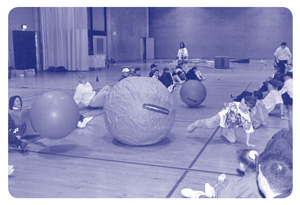 A group of students crawl on the gym floor kicking three giant balls.
A group of students crawl on the gym floor kicking three giant balls.
References
Cowart, J. (1993). Adapted instructional and equipment ideas for use with pupils who are multihandicapped blind within a leisure time context. In P. Jansma, (Ed.), The psychomotor domain and the seriously handicapped (4th ed., pp.321-340). New York: University Press of America.
Fait, H. (1978). Special physical education. Philadelphia: W.B. Saunders.
Lieberman, L. J. (in press). Visual impairments. In J. P. Winnick, (Ed.), Adapted physical education and sport (5th ed.). Champaign, IL: Human Kinetics.
O'Connell, M., Lieberman, L., & Petersen, S. (2006). The use of tactile modeling and physical guidance as instructional strategies in physical activity for children who are blind. Journal of Visual Impairment & Blindness, 100, 471-477.
Reams, D. (1980). Project ComPAC. Miami: Dade County Public Schools.
Sulzer-Azaroff, B., & Mayer, G. (1991). Behavior analysis for lasting change. Fort Worth: Holt, Reinhart and Winston.
Ulrich, D. A. (2000). The test of gross motor development. Austin, TX: Pro-Ed.
Vodola, T. M. (1973). Individualized physical education program for the handicapped child. Englewood Cliffs, New Jersey: Prentice-Hall.
White, E. (1995). Making archery a sport for the visually impaired. Strategies, 8, 12-14.
Winnick, J. P. (Ed.). (in press). Adapted physical education and sport (5th ed.). Champaign, IL: Human Kinetics.
Winnick, J. P., & Short, F. X. (1999). The Brockport Physical Fitness Test. Champaign, IL: Human Kinetics.
























































